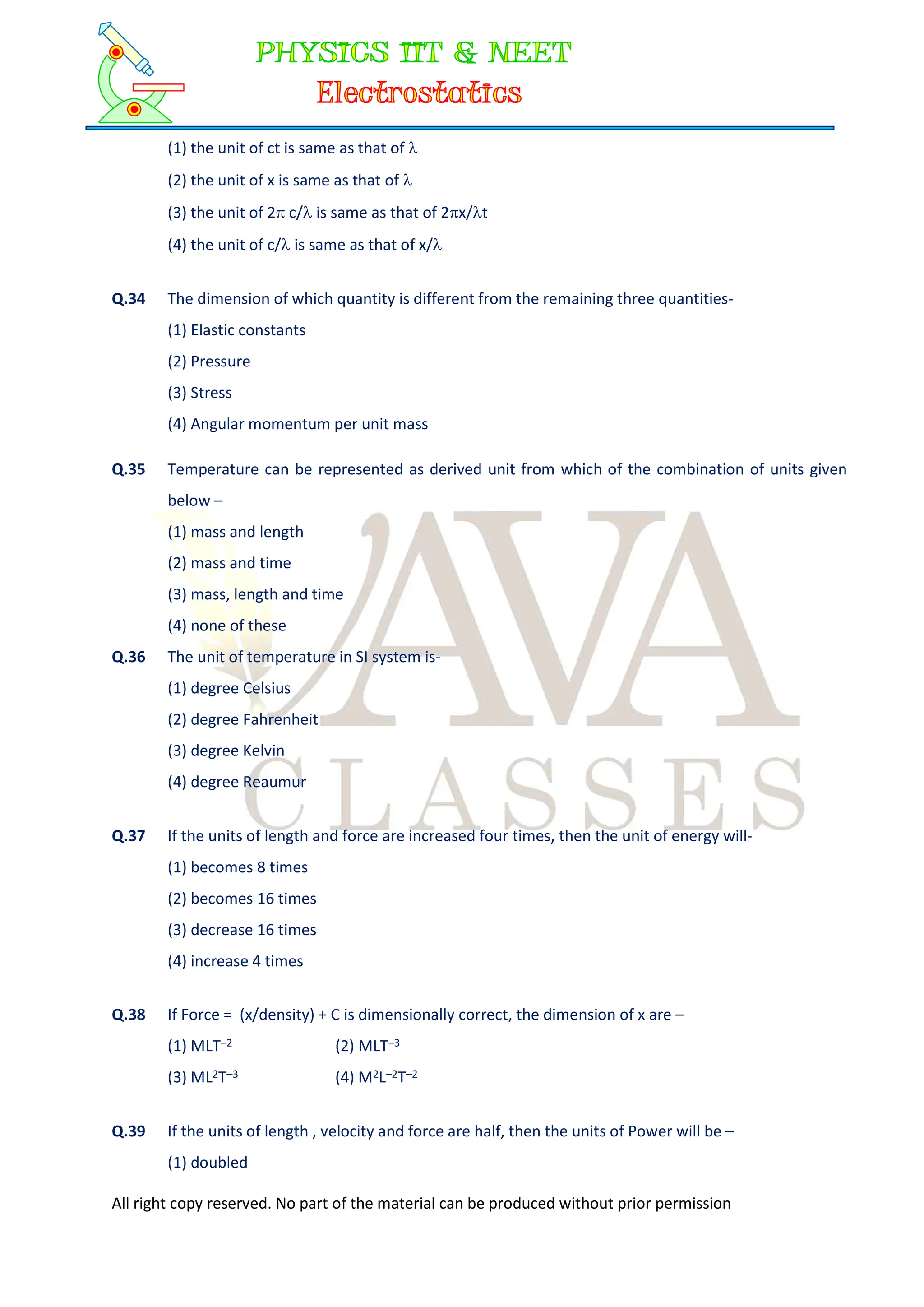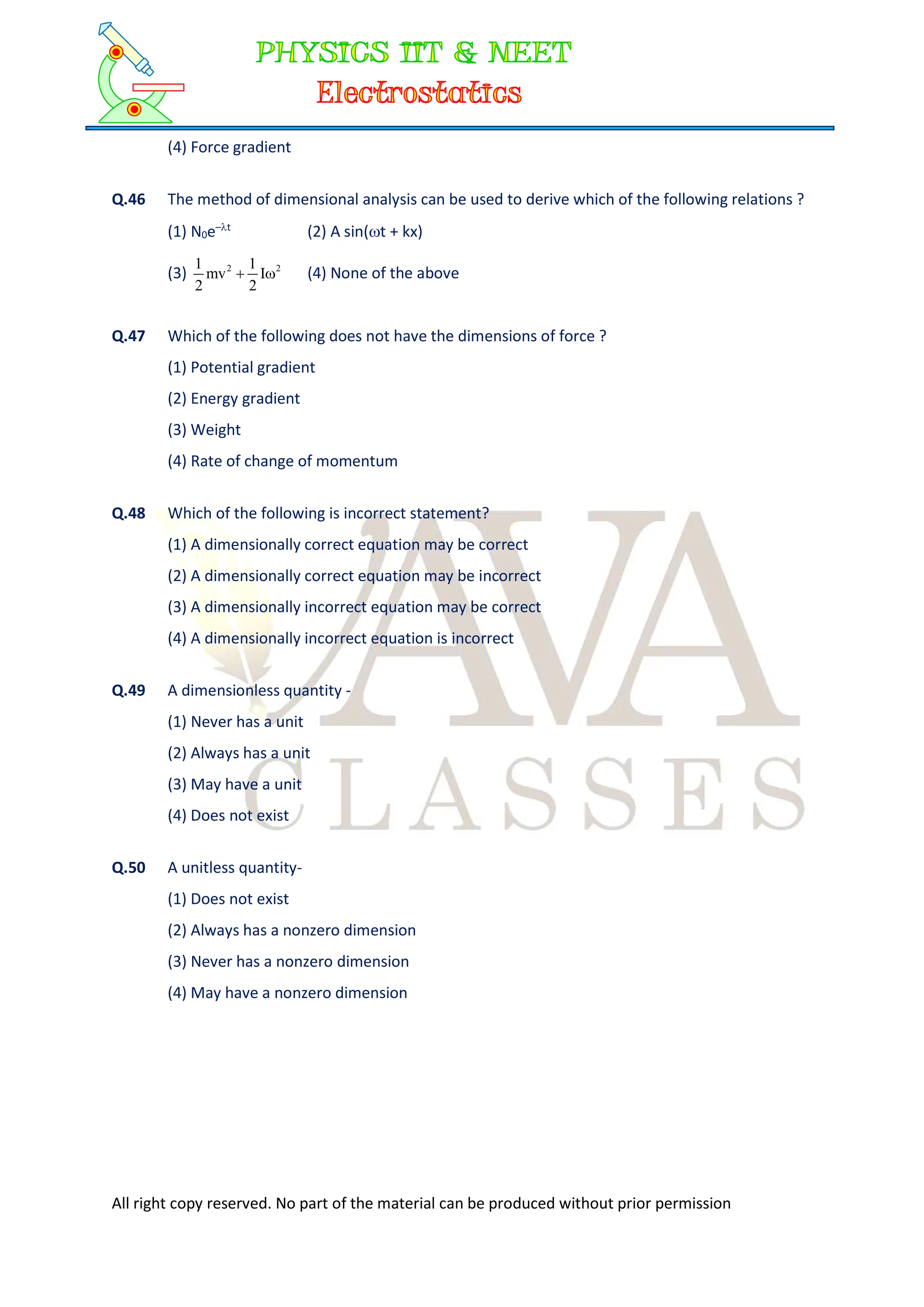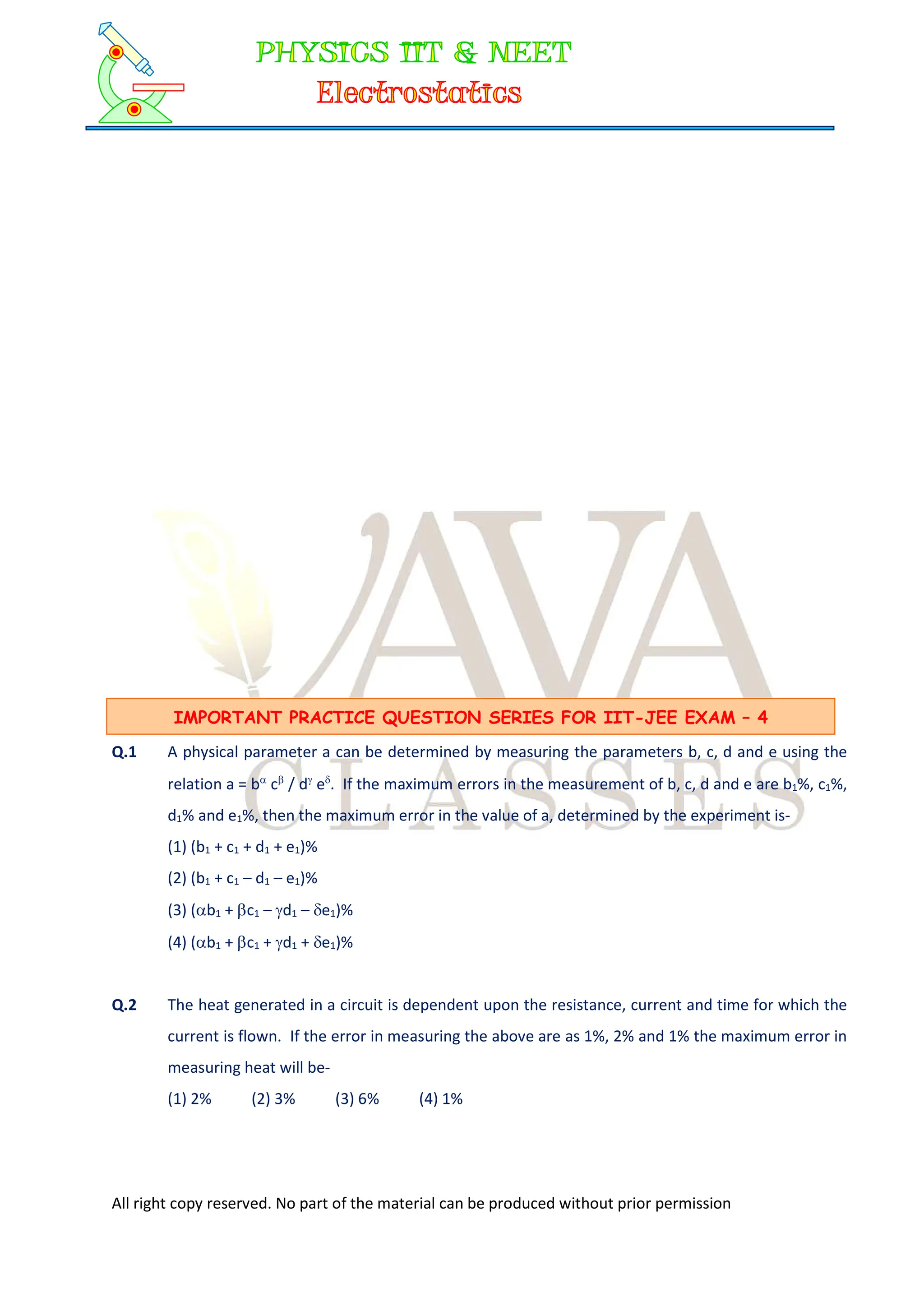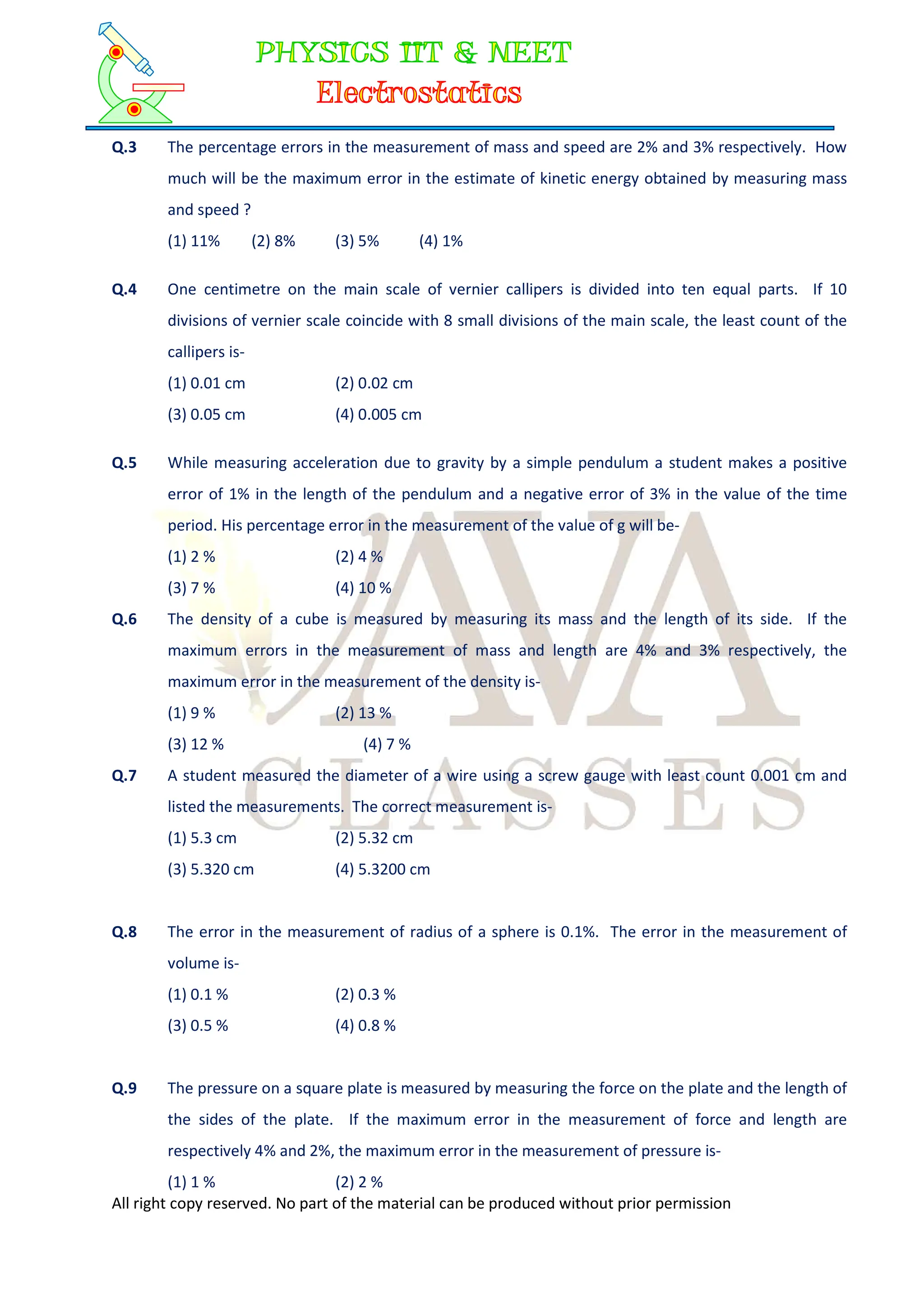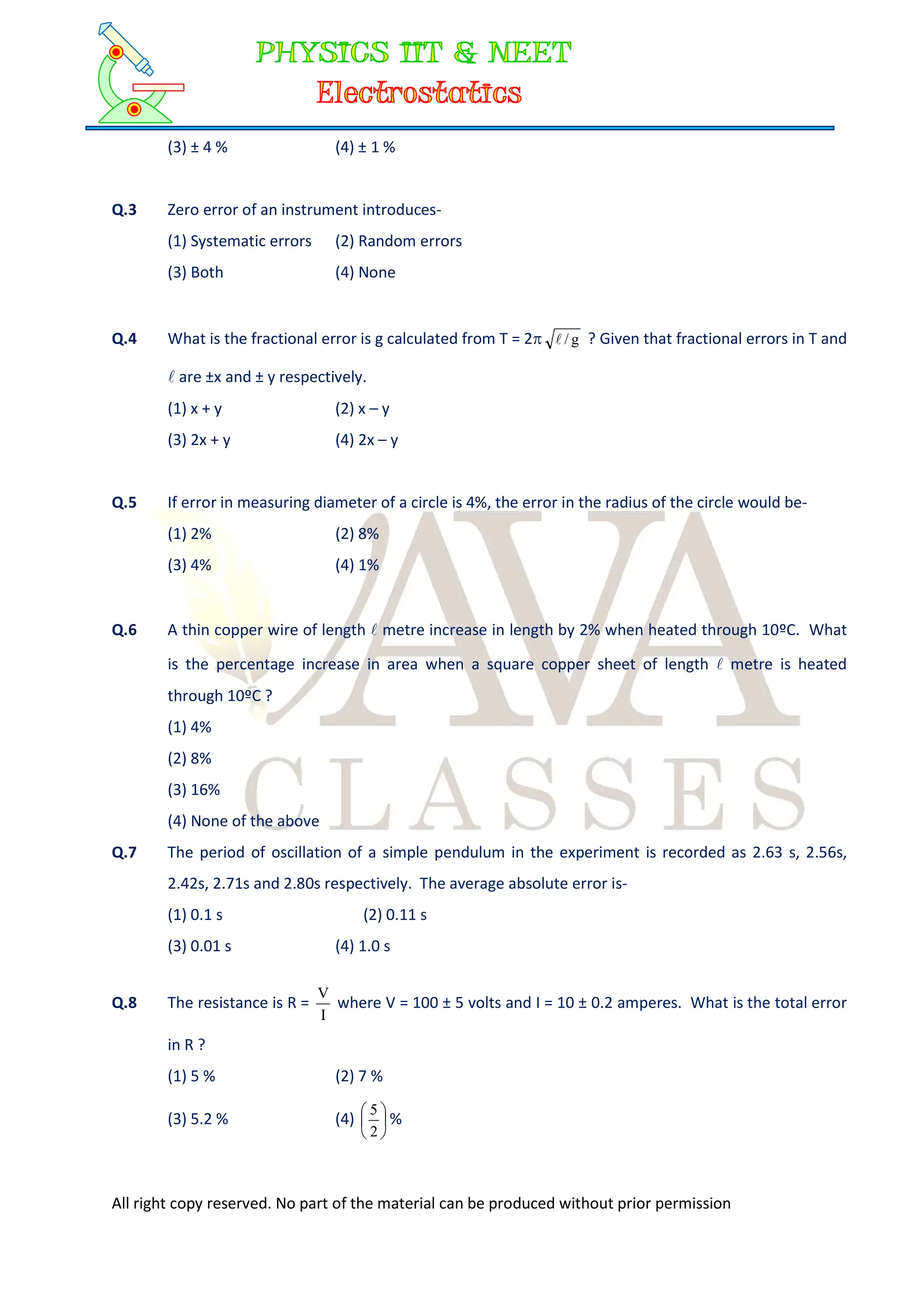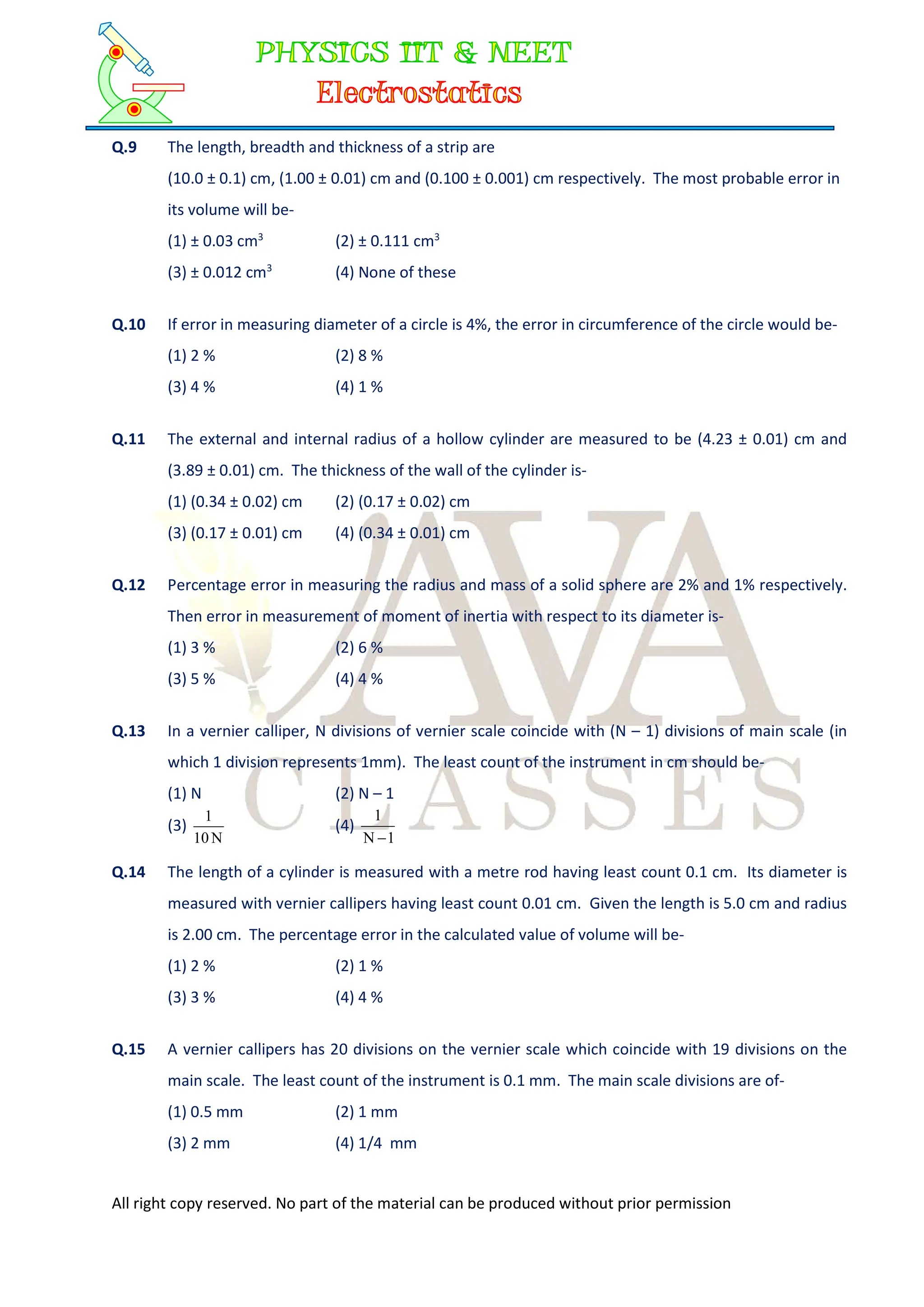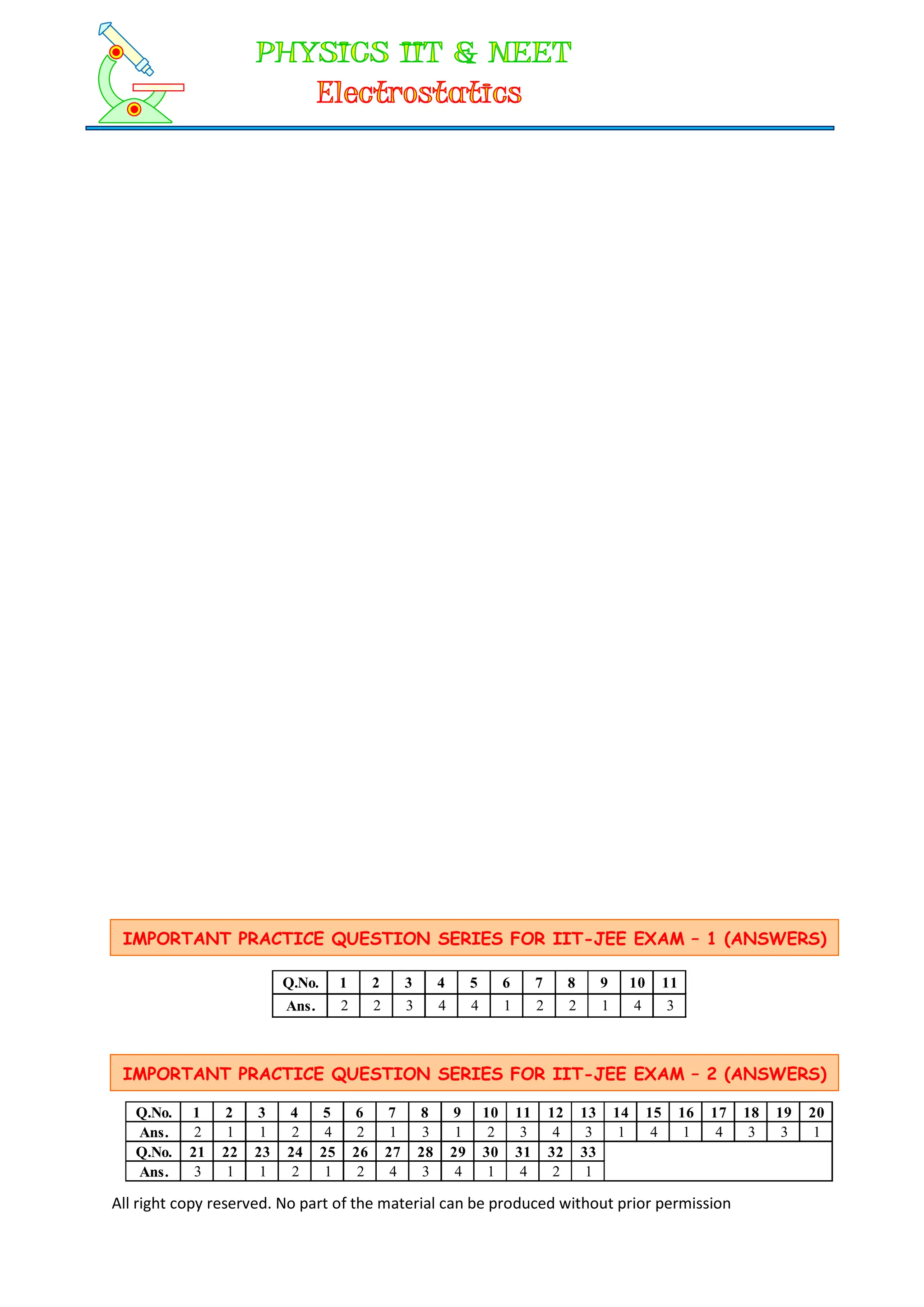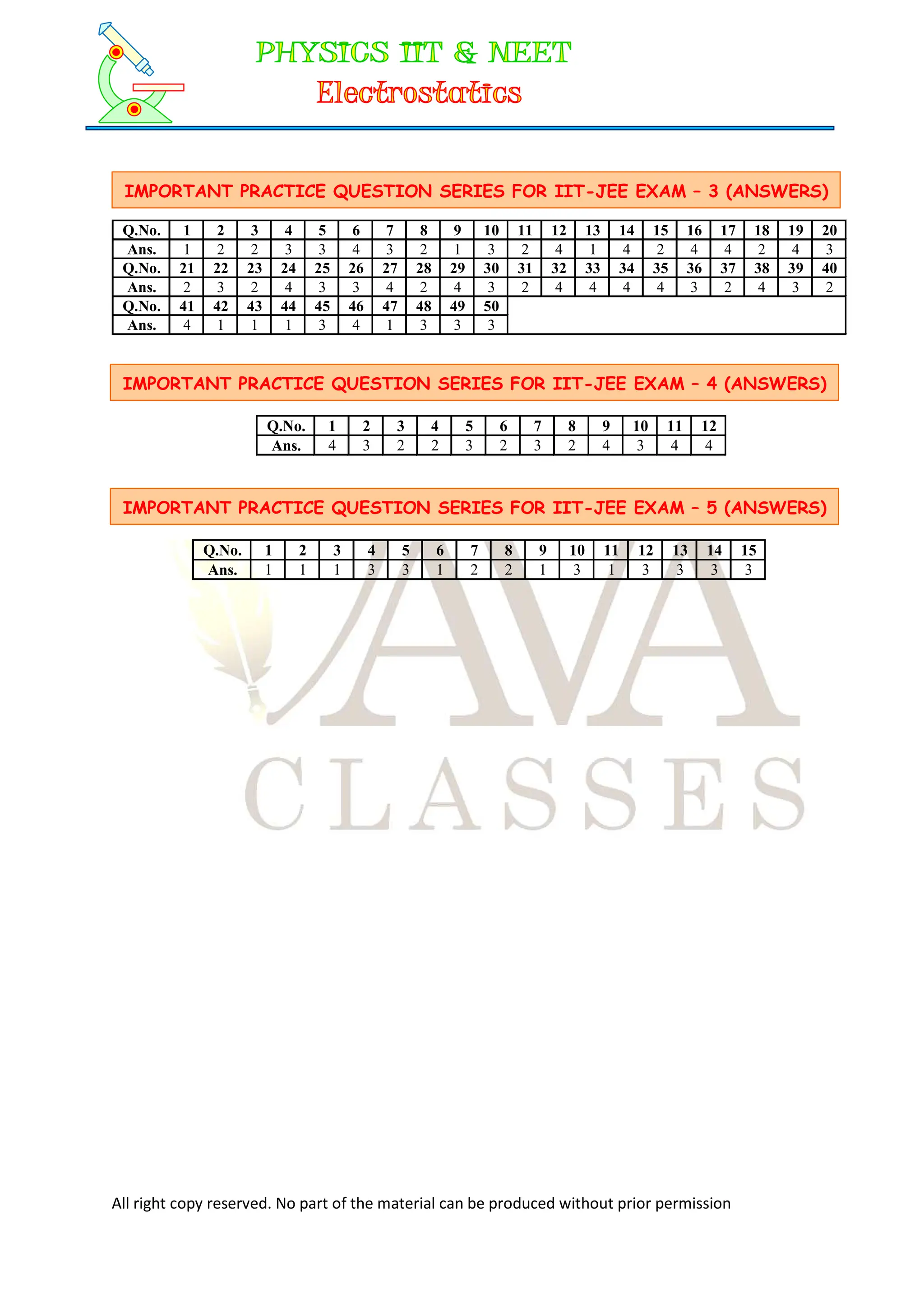The document discusses the scope and significance of physics, covering its fundamental laws and the development of classical and modern physics, including concepts like mechanics, thermodynamics, and quantum mechanics. It highlights the importance of measurement and the need for standard units, referencing the International System of Units (SI) established for physical quantities. Additionally, it outlines various sub-disciplines within physics and their application in technology, health, and exploration.
![[Type here]
All right copy reserved. No part of the material can be produced without prior permission
Key Features
All-in one Study Material (for Boards/IIT/Medical/Olympiads)
Multiple Choice Solved Questions for Boards & Entrance Examinations
Concise, conceptual & trick – based theory
Magic trick cards for quick revision & understanding
NCERT & Advanced Level Solved Examples
JAWS OBJECT BEING MEASURED
RATCHET SCEW
ROTATING BARREL
INNER CYLINDER](https://image.slidesharecdn.com/unitdimensionsmeasurements-240129100521-dde0aa76/75/Unit-Dimensions-Measurements-Class-11-Physics-Chapter-1-Study-Material-in-pdf-1-2048.jpg)
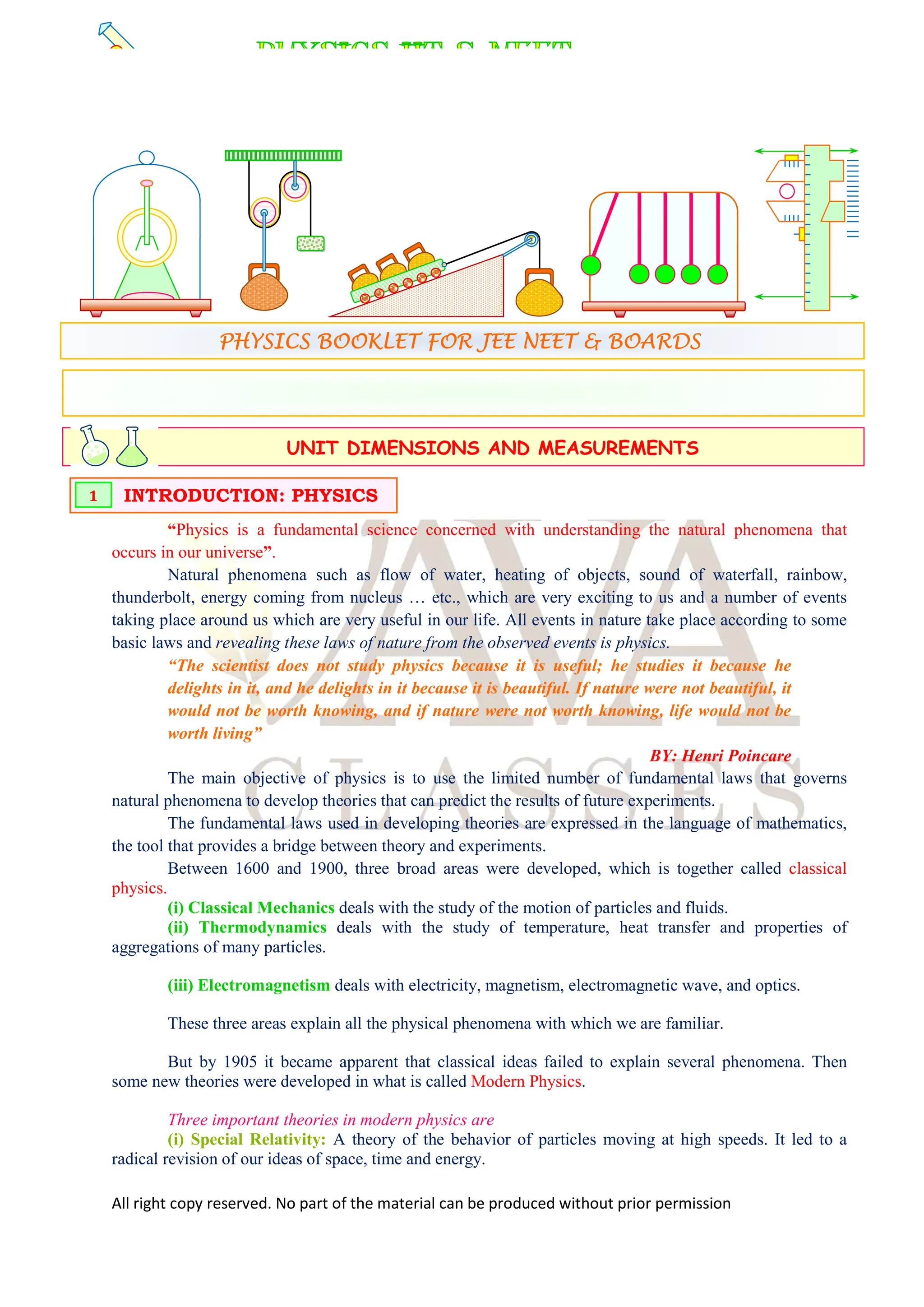

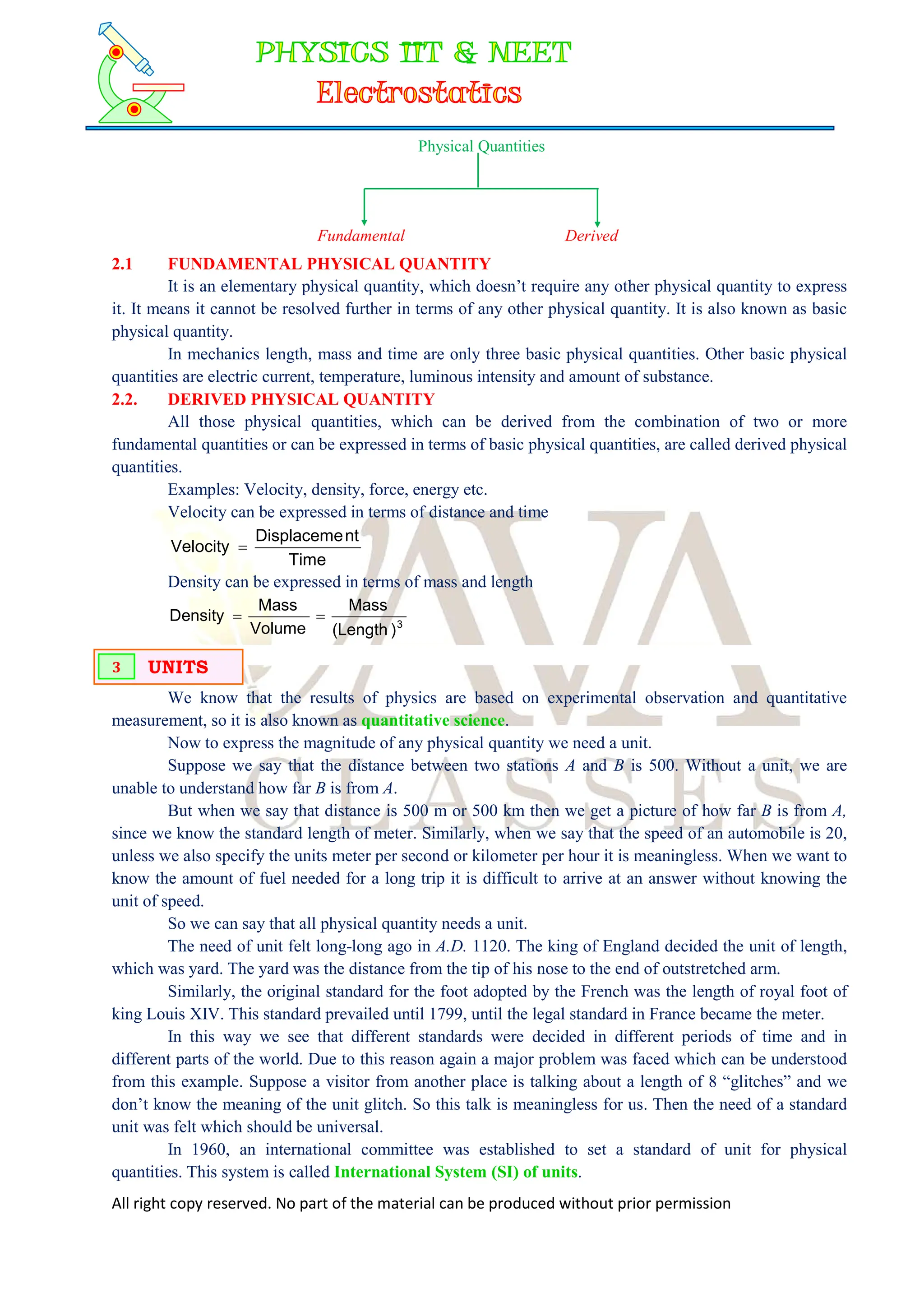
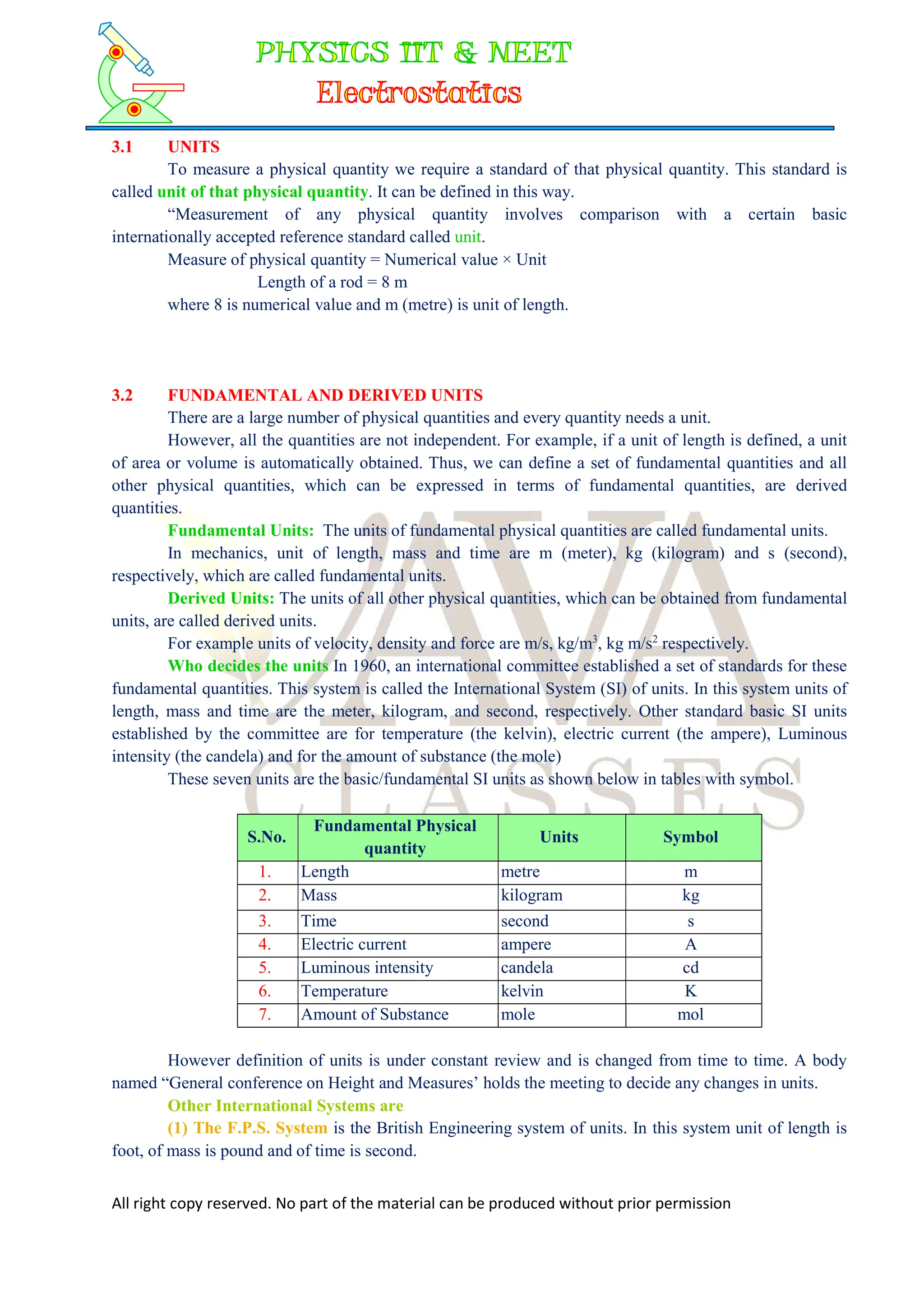
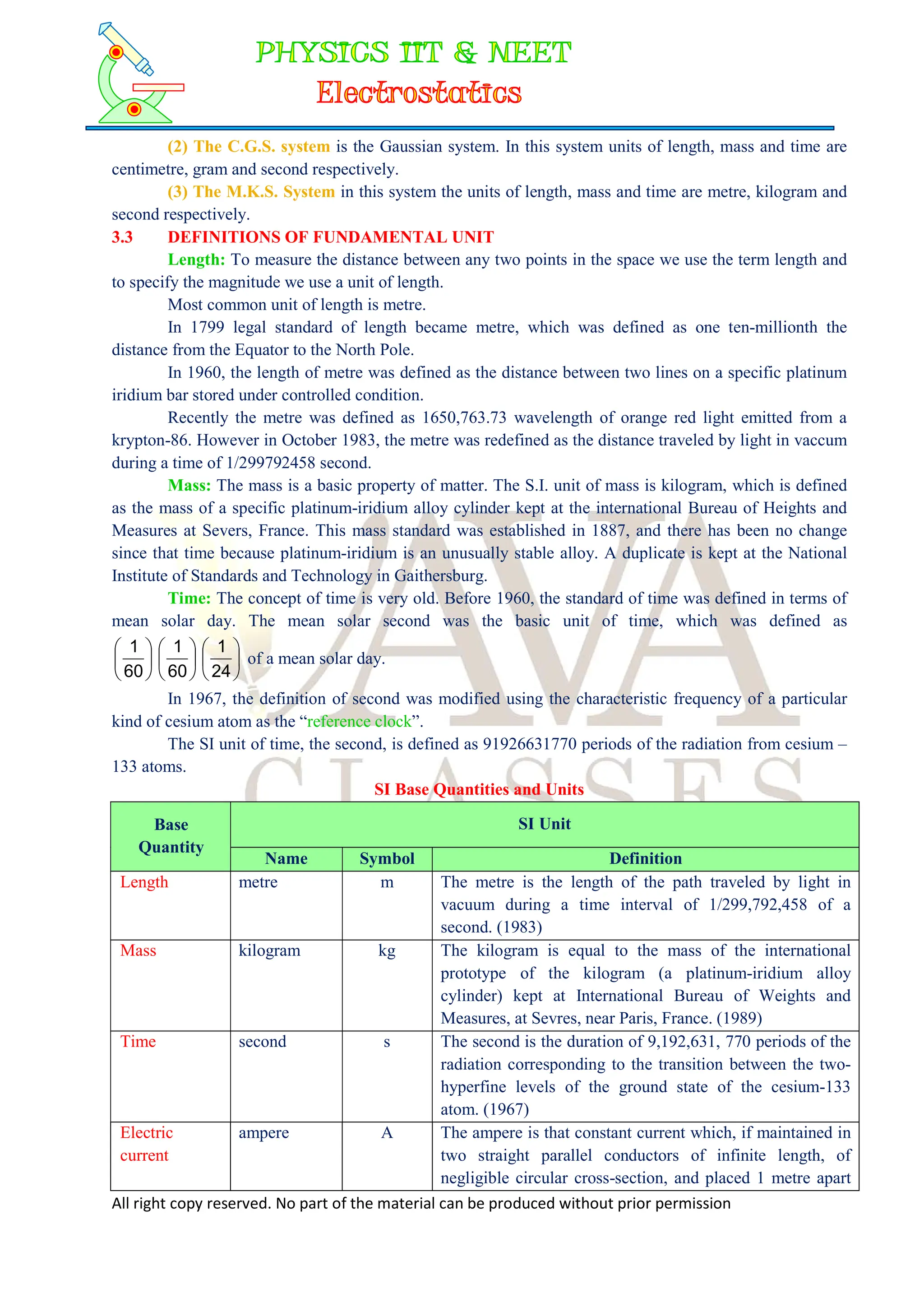
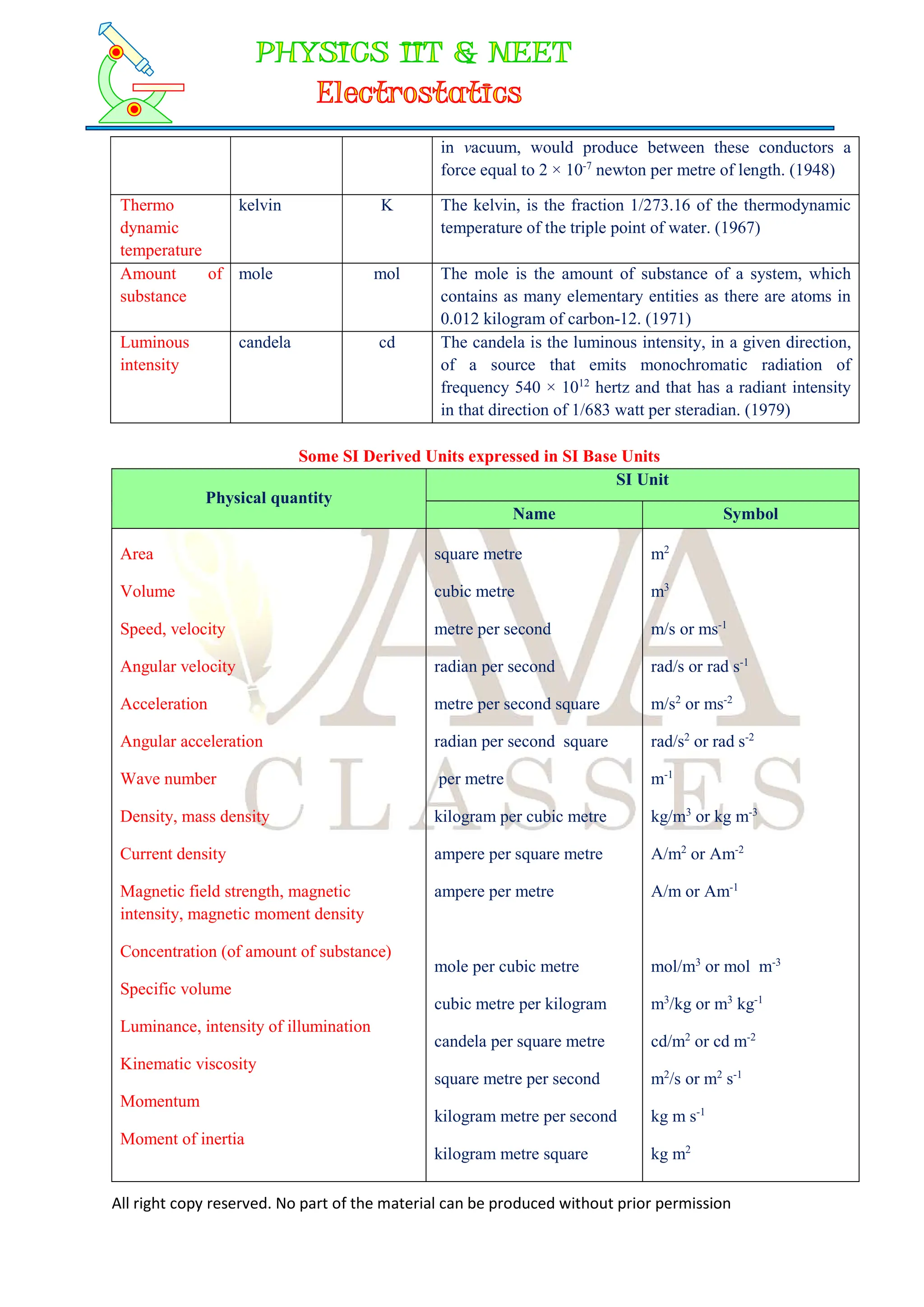
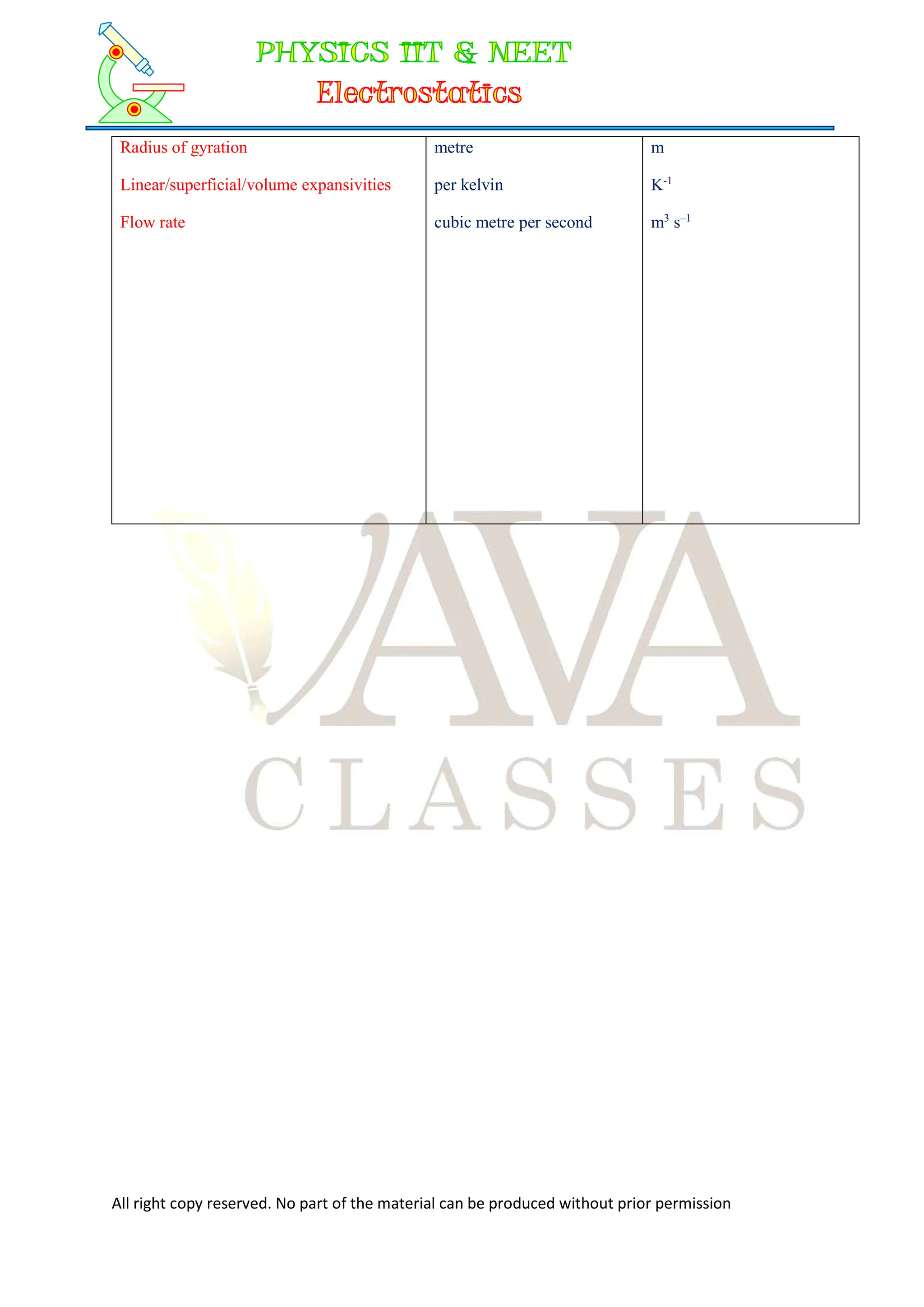

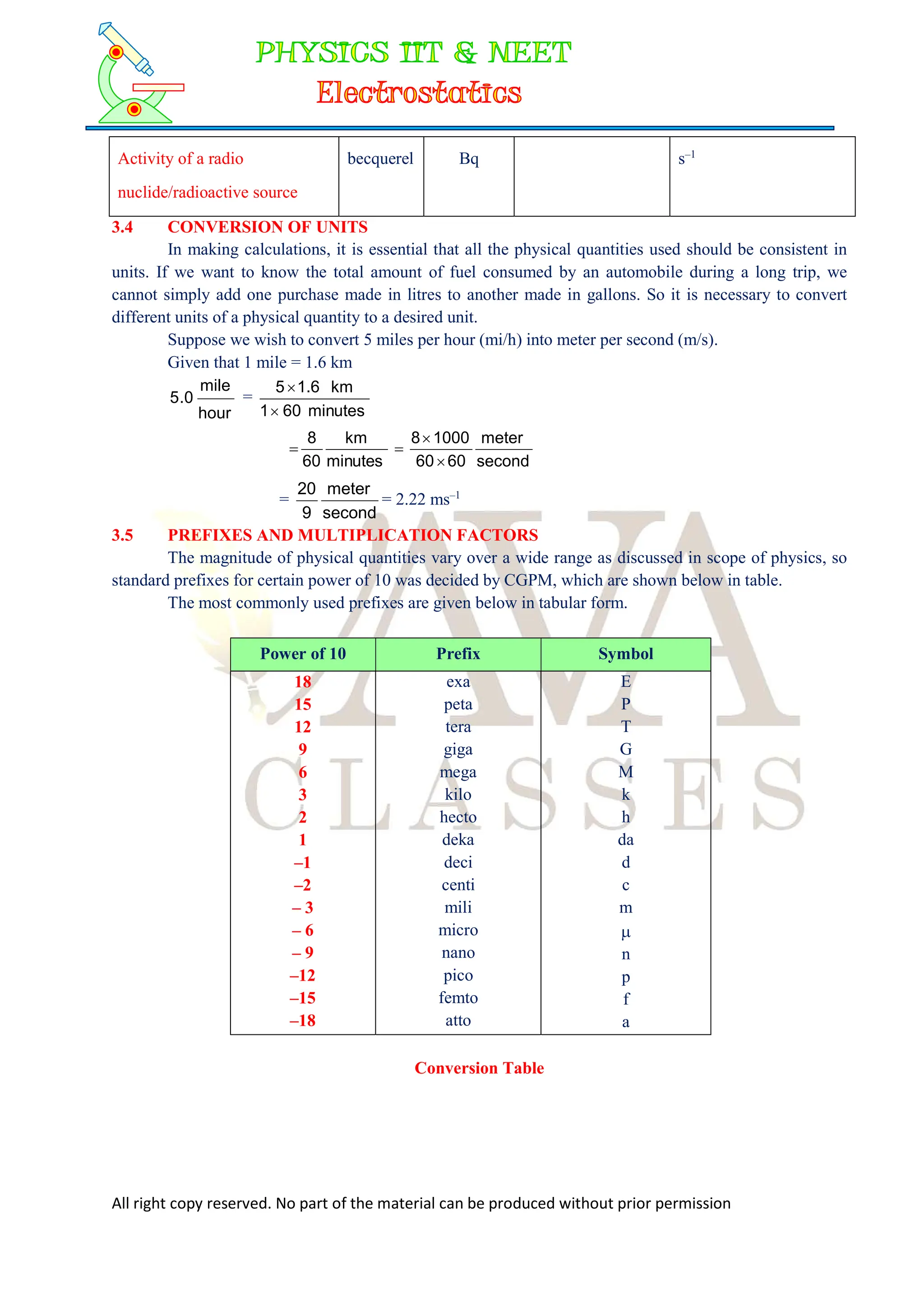

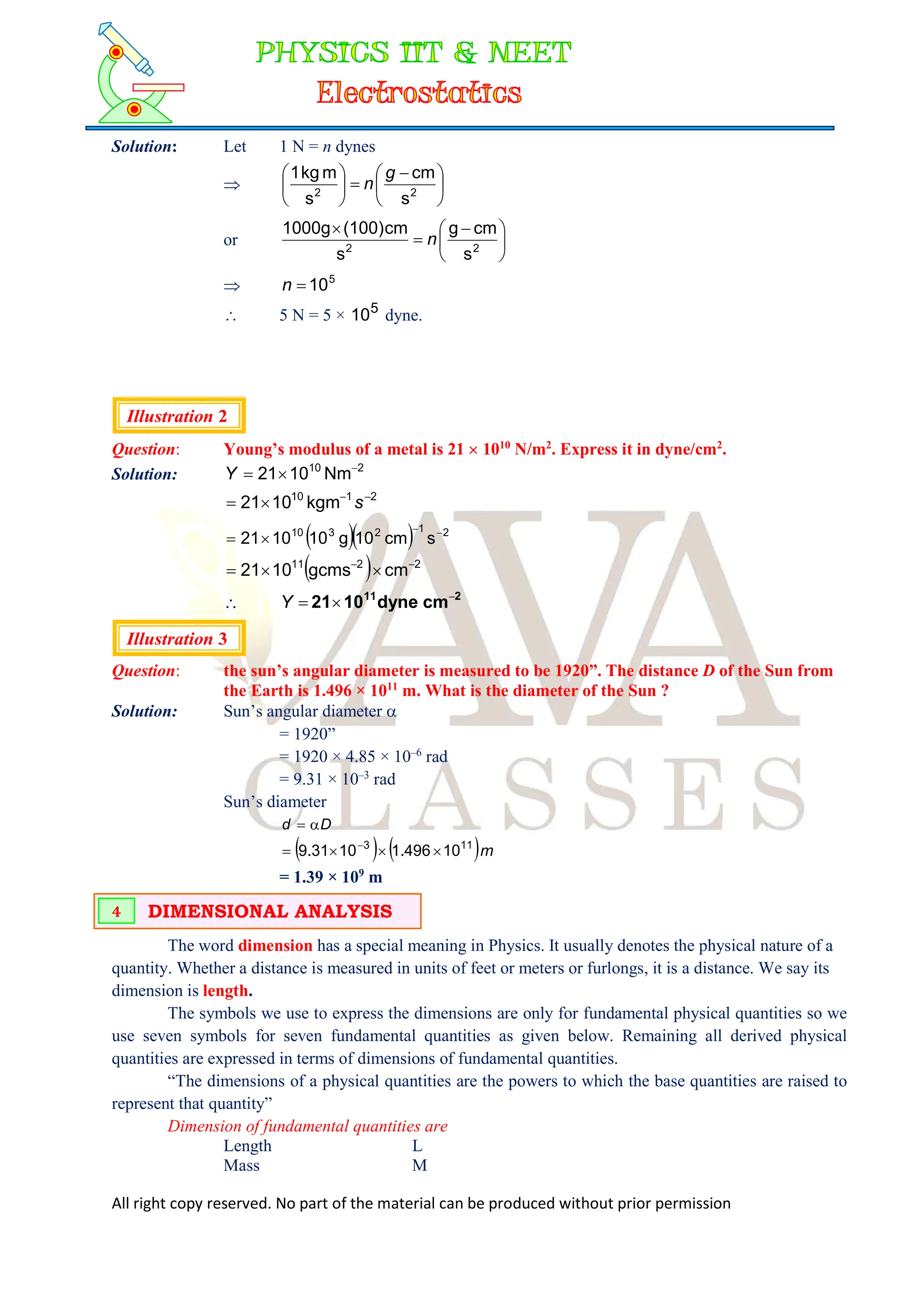
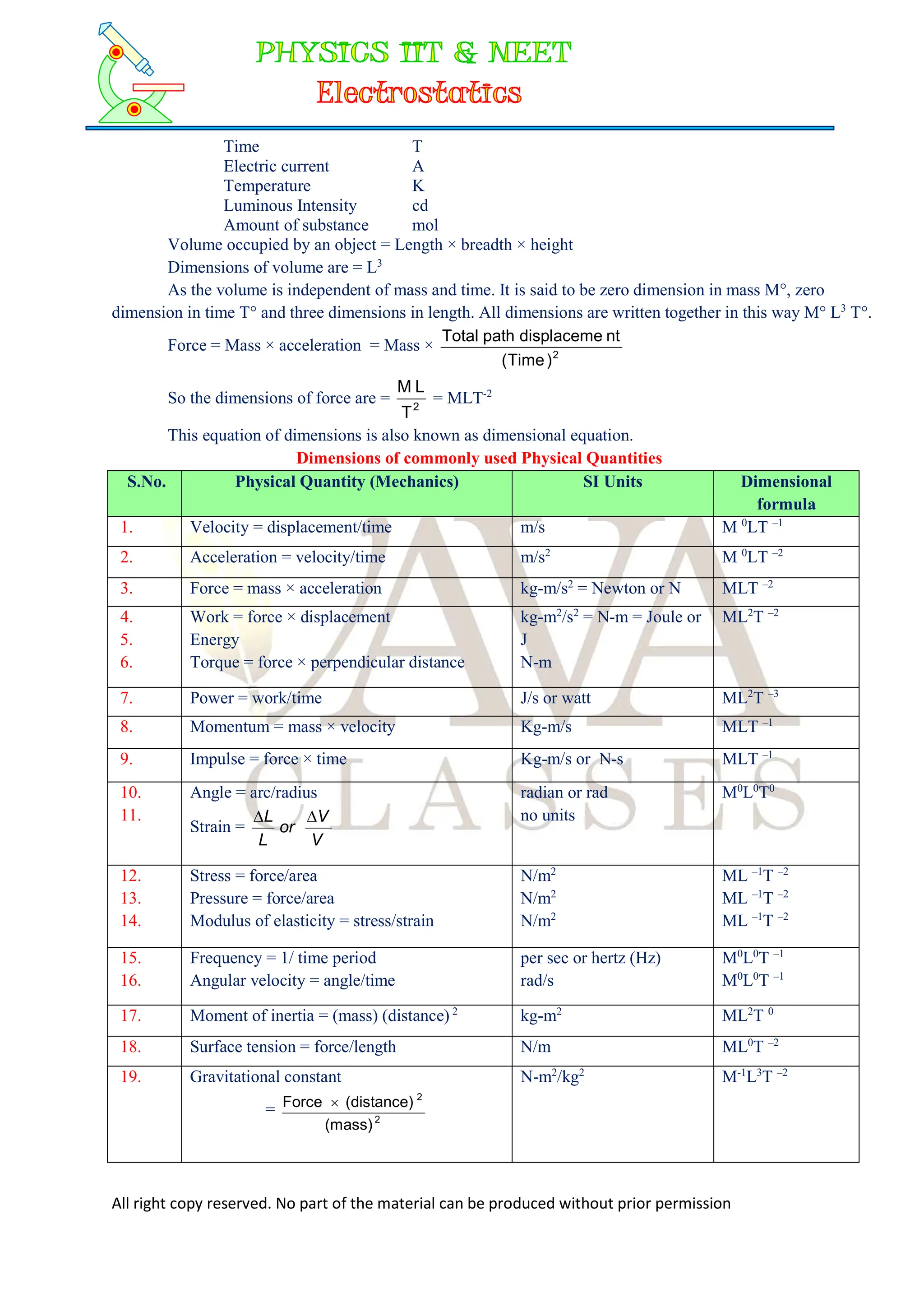
![All right copy reserved. No part of the material can be produced without prior permission
S.No. Physical Quantity SI Units Dimensional
formula
1. Thermodynamic temperature kelvin (K) M 0
L0
T 0
K
2. Heat joule ML2
T –2
3. Specific heat Jkg-1
K–1
M 0
L2
T –2
K –1
4. Latent heat J kg–1
M 0
L2
T –2
5. Universal gas constant J mol–1
K–1
ML2
T–2
K –1
mol –1
6. Boltzmann’s constant JK–1
ML2
T–2
K –1
7. Stefan’s constant Js–1
m–2
K–4
MT –3
K –4
8. Planck’s constant Js ML2
T –1
9. Solar constant J m–2
s–1
ML0
T –3
10. Thermal conductivity Js-1
m-1
K–1
MLT –3
K-1
11. Thermal resistance Kscal–1
M-1
L-2
T3
K
12. Enthalpy cal ML2
T –2
13. Entropy cal K–1
ML2
T –2
K –1
Quantities having same Dimensions
Dimension Quantity
]
[ 1
0
0
T
L
M Frequency, angular frequency, angular velocity, velocity gradient and decay constant
]
[ 2
2
1
T
L
M Work, internal energy, potential energy, kinetic energy, torque, moment of force
]
[ 2
1
1
T
L
M Pressure, stress, Young’s modulus, bulk modulus, modulus of rigidity, energy density
]
[ 1
1
1
T
L
M Momentum, impulse
]
[ 2
1
0
T
L
M Acceleration due to gravity, gravitational field intensity
]
[ 2
1
1
T
L
M Thrust, force, weight, energy gradient
]
[ 1
2
1
T
L
M Angular momentum and Planck’s constant
]
[ 2
0
1
T
L
M Surface tension, Surface energy (energy per unit area)
]
[ 0
0
0
T
L
M Strain, refractive index, relative density, angle, solid angle, distance gradient, relative
permittivity (dielectric constant), relative permeability etc.
]
[ 2
2
0
T
L
M Latent heat and gravitational potential](https://image.slidesharecdn.com/unitdimensionsmeasurements-240129100521-dde0aa76/75/Unit-Dimensions-Measurements-Class-11-Physics-Chapter-1-Study-Material-in-pdf-14-2048.jpg)
![All right copy reserved. No part of the material can be produced without prior permission
]
[ 1
2
2
K
T
ML Thermal capacity, gas constant, Boltzmann constant and entropy
]
[ 1
0
0
T
L
M
,
,
,
g
R
k
m
g
l
where l = length g = acceleration due to gravity, m = mass,
k = spring constant, R = Radius of earth
]
[ 1
0
0
T
L
M RC
LC
R
L
,
, where L = inductance, R = resistance, C = capacitance
]
[ 2
2
T
ML 2
2
2
2
2
,
,
,
,
,
, CV
C
q
LI
qV
VIt
t
R
V
Rt
I where I = current, t = time, q = charge,
L = inductance, C = capacitance, R = resistance
Note : A physical constant may or may not have dimensions.
Illustration 4
Question: Find the dimensional formula of angular velocity.
Solution: [angular velocity] =
T
T
L
M
t
= M°L°T–1
Illustration 5
Question: Find the dimensional formula for Planck’s constant (h).
Solution: E =
hc
[h] =
1
2
2
LT
L
T
ML
c
E
ML2
T–1
4.1 APPLICATION OF DIMENSIONAL ANALYSIS
(i) In conversion of units from one system to other
This is based on the fact that the product of the numerical value and its corresponding unit is
constant.
Numerical value × Unit = constant
So when the unit will change, numerical value will also change.
Gravitational constant G = 6.67 × 10-11
Nm2
/kg2
in SI units. We can convert it in C.G.S. system in
this way.
The dimensional formula of G is M-1
L3
T-2
Let n1 represents magnitude in S.I. unit and n2 in C.G.S. unit
n1 (M1
–1
L1
3
T1
–2
) = n2
2
2
3
2
1
2 T
L
M
n2 = n1
2
2
1
3
2
1
1
2
1
T
T
L
L
M
M
=
2
3
1
11
s
1
s
1
cm
1
m
1
gm
1
kg
1
10
6.67
](https://image.slidesharecdn.com/unitdimensionsmeasurements-240129100521-dde0aa76/75/Unit-Dimensions-Measurements-Class-11-Physics-Chapter-1-Study-Material-in-pdf-15-2048.jpg)
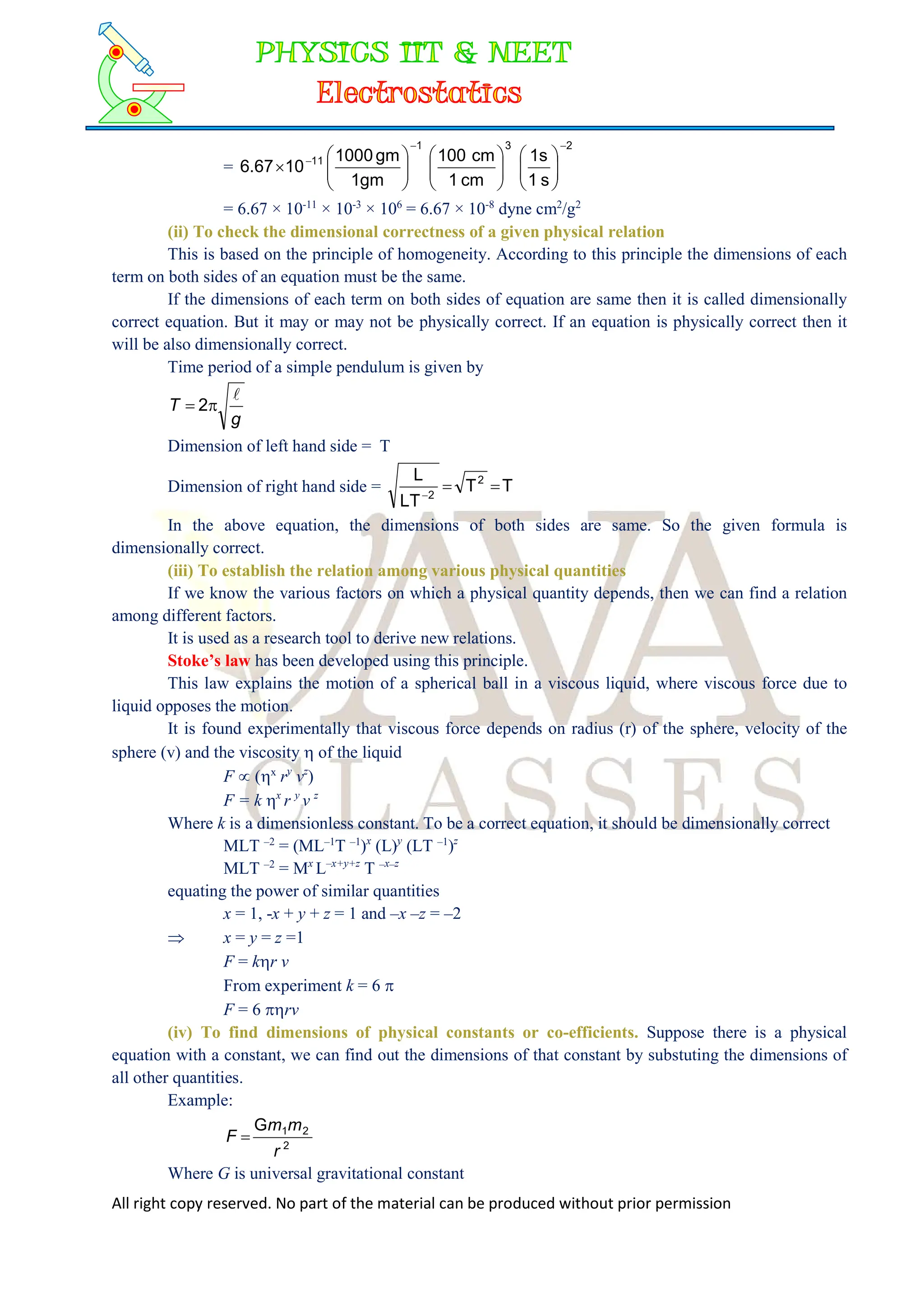
![All right copy reserved. No part of the material can be produced without prior permission
G
2
1
2
m
m
Fr
=
2
2
2
M
L
MLT
= 2
3
1
T
L
M
4.2 LIMITATIONS OF DIMENSIONAL ANALYSIS
The method of dimensions has the following limitations:
(i) By this method the value of dimensionless constant cannot be calculated.
(ii) By this method the equation containing trigonometric, exponential and logarithmic terms
cannot be analyzed.
(iii) If a physical quantity in mechanics depends on more than three factors, then relation among
them cannot be established because we can have only three equations by equalizing the powers of M, L and
T.
(iv) It doesn’t tell whether the quantity is vector or scalar.
Illustration 6
Question: The velocity of sound in a gas depends on its pressure and density. Obtain a relation
between velocity, pressure and density.
Solution: Let the relationship is expressed as ,
c
a
P
k
v
where P is pressure, is density and v is
velocity of sound.
Now, ]
[
]
[
],
[
]
[
],
[
]
[ 3
2
1
1
ML
T
L
M
P
T
L
v
c
a
L
M
T
L
M
T
L
M ]
[
]
[
]
[ 3
2
1
1
0
or ]
[
]
[ 2
3
1
0 a
c
a
c
a
T
L
M
T
L
M
Equating the powers of M, L and T, we have
a + c = 0, – a – 3c = 1, – 2a = – 1
2
1
,
2
1
c
a
Expression for velocity of sound is of the form
P
k
v .
Actual formula is
P
v where
V
P
C
C
(adiabatic exponent).
Illustration 7
Question: In a new system of units, unit of mass is taken as 50 kg, unit of length is taken as 100
m and unit of time is 1 minute. What will be the weight of a body in this system, if in
SI system, its weight is 10 N.
Solution: Let the weight of the body in new system is X units
10 N = X units
Let 1
1
1 ,
, T
L
M and 2
2
2 ,
, T
L
M be the symbols for mass, length and time in the two system
respectively, then
]
[
]
[
10 2
2
2
2
2
1
1
1
T
L
M
X
T
L
M
s
60
,
s
1
,
m
100
,
m
1
,
kg
50
,
kg
1 2
1
2
1
2
1
T
T
L
L
M
M](https://image.slidesharecdn.com/unitdimensionsmeasurements-240129100521-dde0aa76/75/Unit-Dimensions-Measurements-Class-11-Physics-Chapter-1-Study-Material-in-pdf-17-2048.jpg)
![All right copy reserved. No part of the material can be produced without prior permission
units
2
.
7
5000
36000
60
1
100
1
50
10
2
X
10 N = 7.2 units.
Illustration 8
Question: The period P of a simple pendulum is the time for one complete swing. How does P
depend on the mass m of the bob, the length of the string, and the acceleration due
to gravity g?
Solution: We begin by expressing the period P in terms of the other quantities as follows:
P = km x
y
g z
Where k is a constant and x, y and z are to be determined. Next we insert the dimensions of
each quantity
P = Mx
Ly
Lz
T –2z
= Mx
Ly+z
T –2z
On equating the powers of each dimension on either side of the equation.
T: 1 = –2z
M: 0 = x
L: 0 = y + z
These equations are easily solved and yield x = 0,
z =
2
1
, and y =
2
1
. Thus,
g
k
P
This analysis will not yield the value of k, but we have found, perhaps surprisingly, that
the period does not depend on the mass. A derivation in terms of the forces acting on the
bob shows that k = 2.
Illustration 9
Question: The equation of state of some gases can be expressed as RT
b)
(V
V
a
P 2
.
Here, P is the pressure, V the volume, T the absolute temperature, and a, b, R are
constants. Find the dimensions of a.
Solution: Dimensions of 2
v
a
will be same as dimensions of pressure
2
3
]
[L
a
= ML–1
T–2
[a] = ML5
T–2
Illustration 10
Question: If energy (E), momentum (P) and force (F) are chosen as fundamental units. Then find
the dimensions of mass in new system.
Solution: The dimensions of E, P and F in terms of M, L and T are
[E] = ML2
T-2
[P] = MLT-1
[F] = MLT-2
Let [M] = Ea
Pb
FC
or [M] = (ML2
T-2
)a
(MLT-1
)b
(MLT-2
)C
Equating the powers of M, L and T, we have a = -1, b = 2 and c = 0
Hence [M] = E-1
P2](https://image.slidesharecdn.com/unitdimensionsmeasurements-240129100521-dde0aa76/75/Unit-Dimensions-Measurements-Class-11-Physics-Chapter-1-Study-Material-in-pdf-18-2048.jpg)
![All right copy reserved. No part of the material can be produced without prior permission
Illustration 11
Question: Consider the equation ,
2
E
x
e
F
where F is force x is distance E is energy and ,
are constants. What are the dimensions of and ?
Solution: As argument of exponential functions is dimensionless, so
Dimensions of ]
[ 0
0
0
T
L
M
E
x
]
[
]
[
]
[
]
[ 0
0
0
2
2
T
L
M
T
L
M
L
]
[
]
[ 2
T
L
M
Now
2
will have dimensions of force
]
[
2
F
]
[
]
[
]
[ 2
2
2
T
L
M
T
L
M
2
1
1
]
[
T
L
M
MEASUREMENT OF LENGTH
Vernier calliper and screw gauge are the instruments used for measuring length with high
accuracy. From a normal scale, accuracy of 1 mm is obtained, while with these instruments, accuracies
upto 0.01 mm can be achieved.
LEAST COUNT
The smallest measurement that can be taken with the help of a measuring instrument is called its
least count. Like, in a simple wristwatch, the second’s hand moves through a smallest time interval of 1 s.
So, we can measure a minimum time of 1 s. Thus, the least count of the wristwatch is 1 s similarly the least
count of a normal metre scale is 1 mm.
Following two points are worth remembering regarding the least count.
(i) Least count represents the permissible error in the measurement.
(ii) It gives the limit of resolution of the instrument.
The following illustrations will make the above statements clear.
For example a simple geometry box scale has smallest division of 0.1 cm marked on it. This is the
least count. When a measurement is taken from this scale, the result can be 5.1 cm or 7.9 cm, but it cannot
be 5.15 cm or 7.93 cm. Reporting the answer as 7.93 cm gives a wrong information, it shows that the least
count is 0.01 cm i.e., instrument has greater resolution.
5.1 VERNIER CALLIPER
It consists of a fixed main scale marked on a metallic strip. Another metallic strip slides on it with
a vernier scale on it. Scales are marked in such a way that when zero’s of both scales are aligned, nth
division of vernier scale coincides with (n – 1)th
division of main scale. In the figure shown, 10th
division of
vernier scale coincides with 9th
division of main scale.
MEASUREMENT
5](https://image.slidesharecdn.com/unitdimensionsmeasurements-240129100521-dde0aa76/75/Unit-Dimensions-Measurements-Class-11-Physics-Chapter-1-Study-Material-in-pdf-19-2048.jpg)
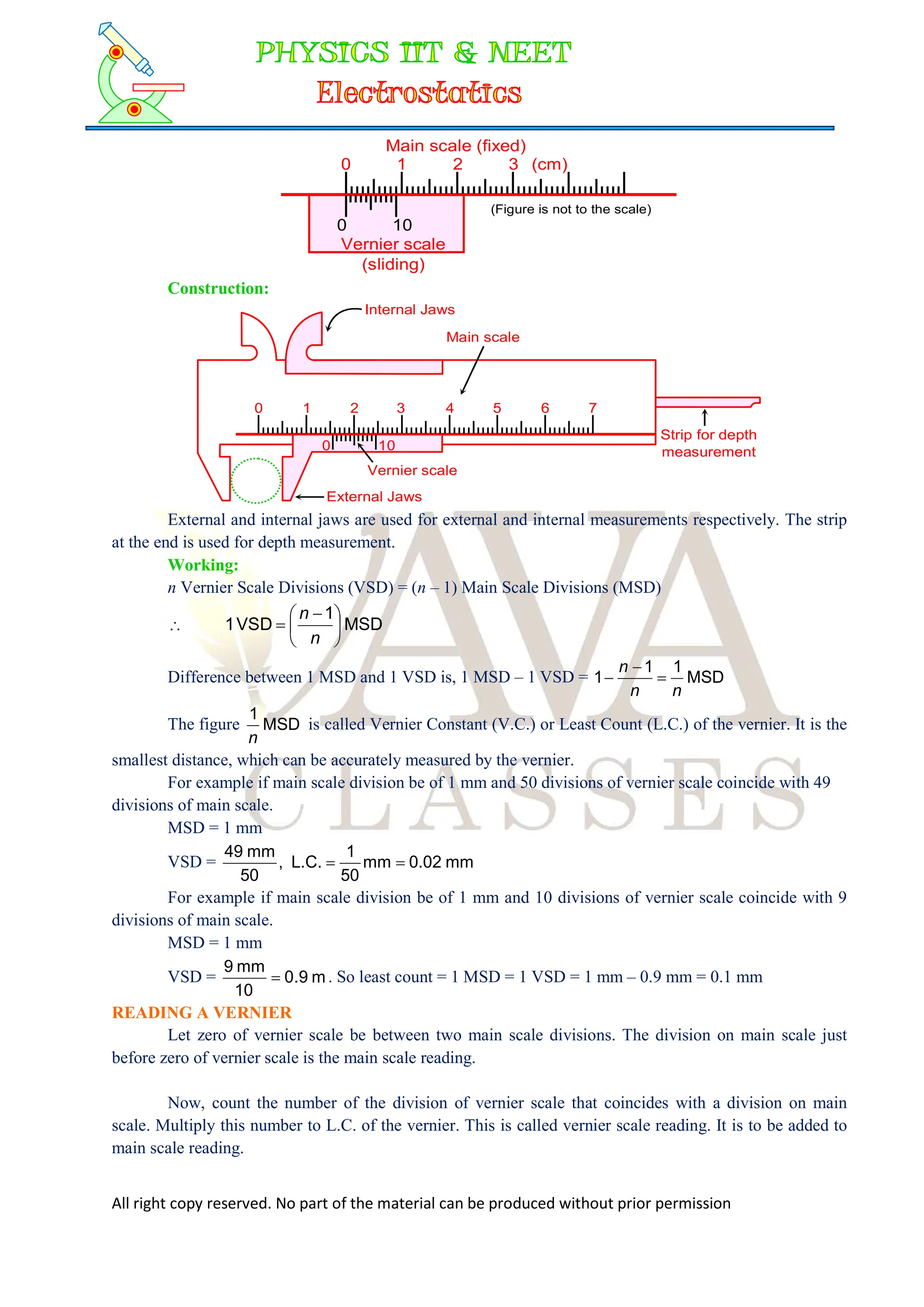
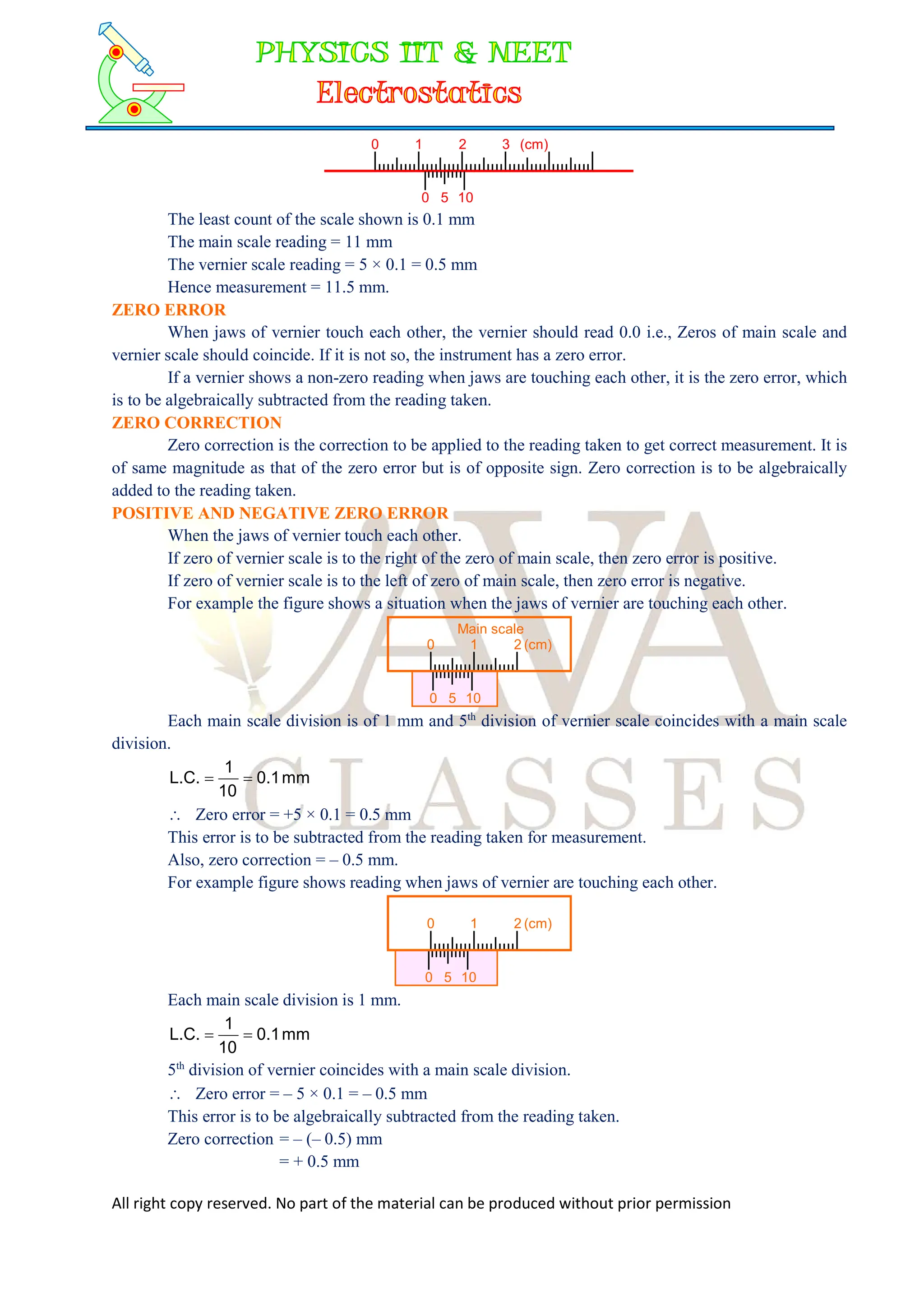
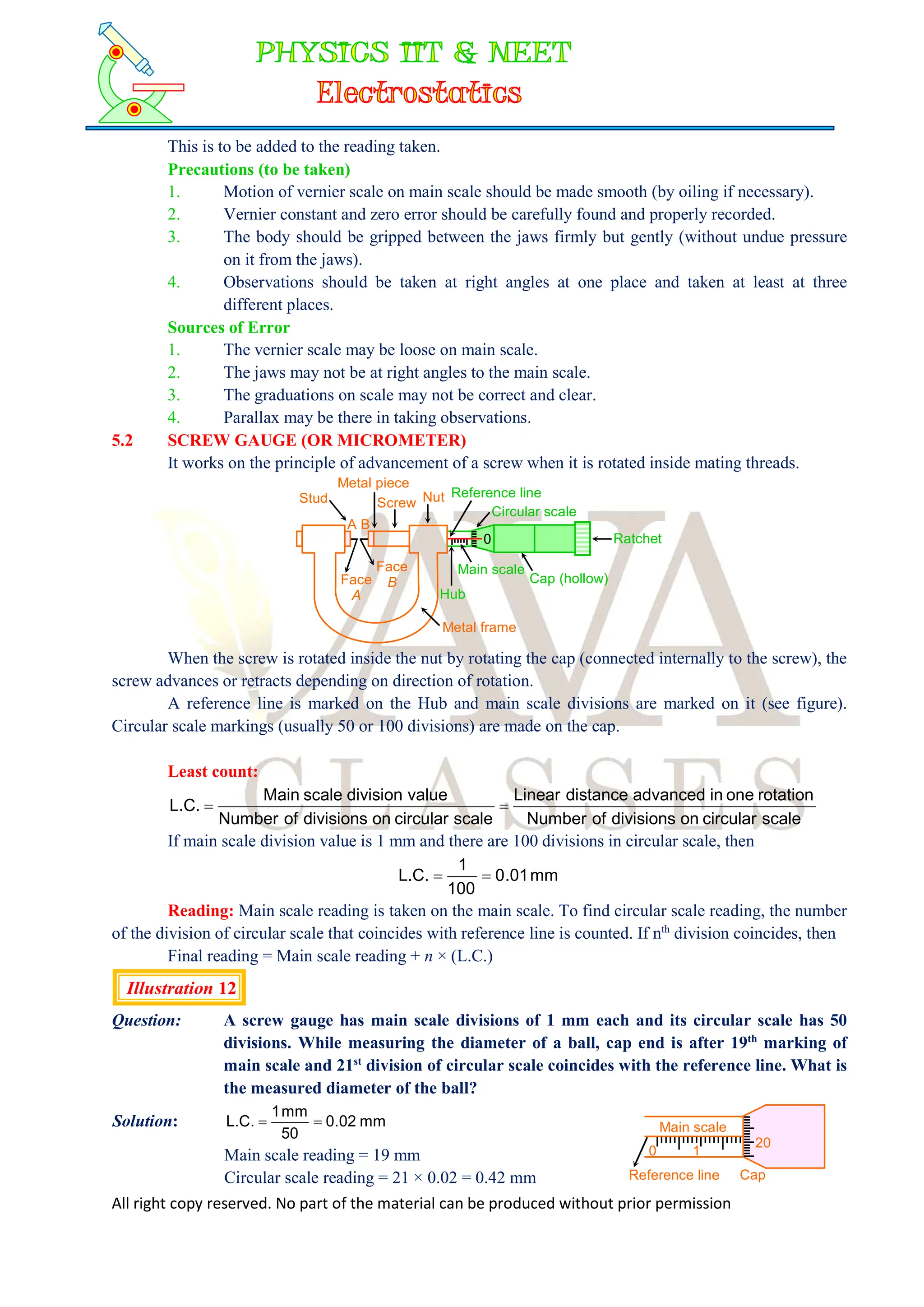
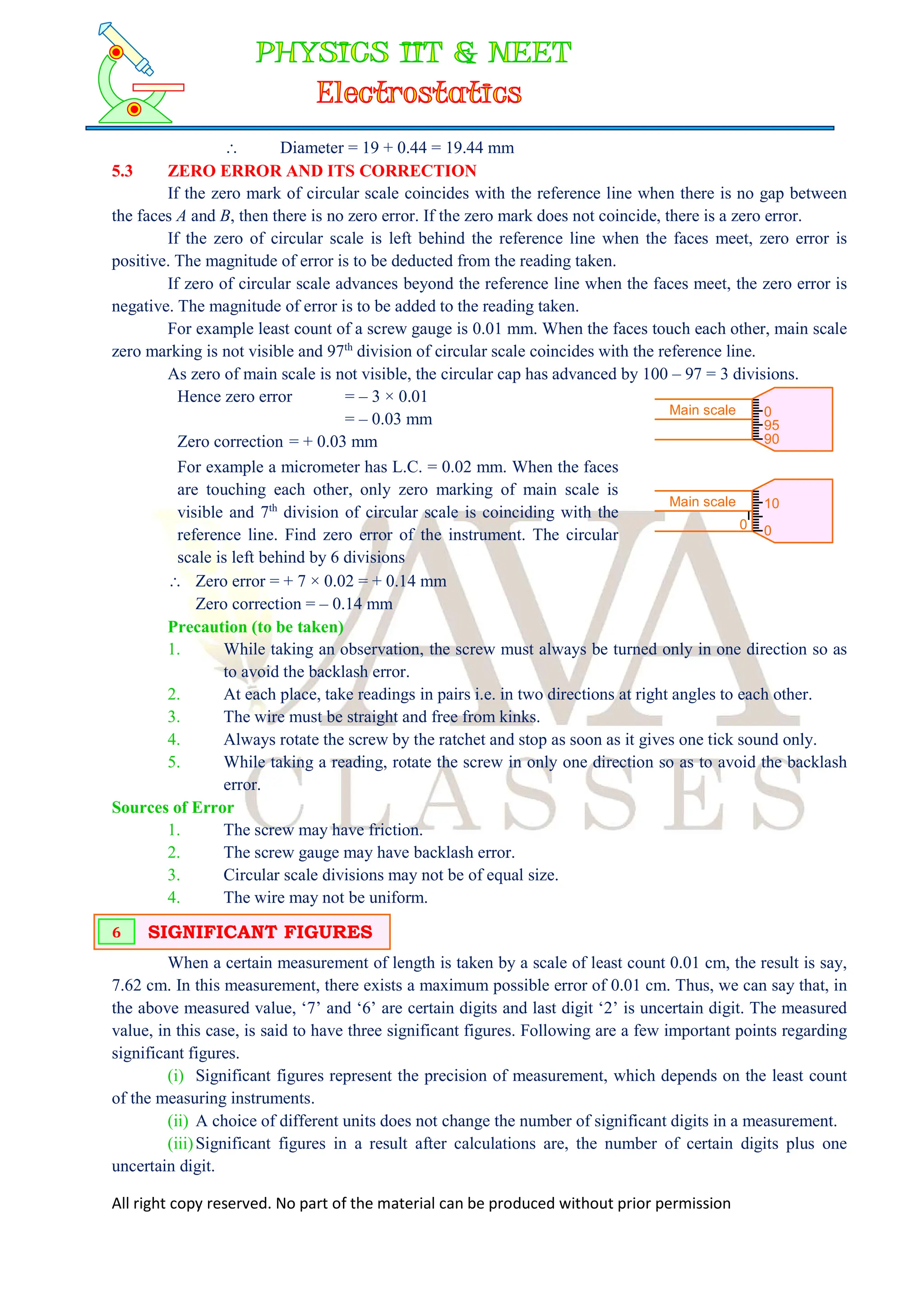
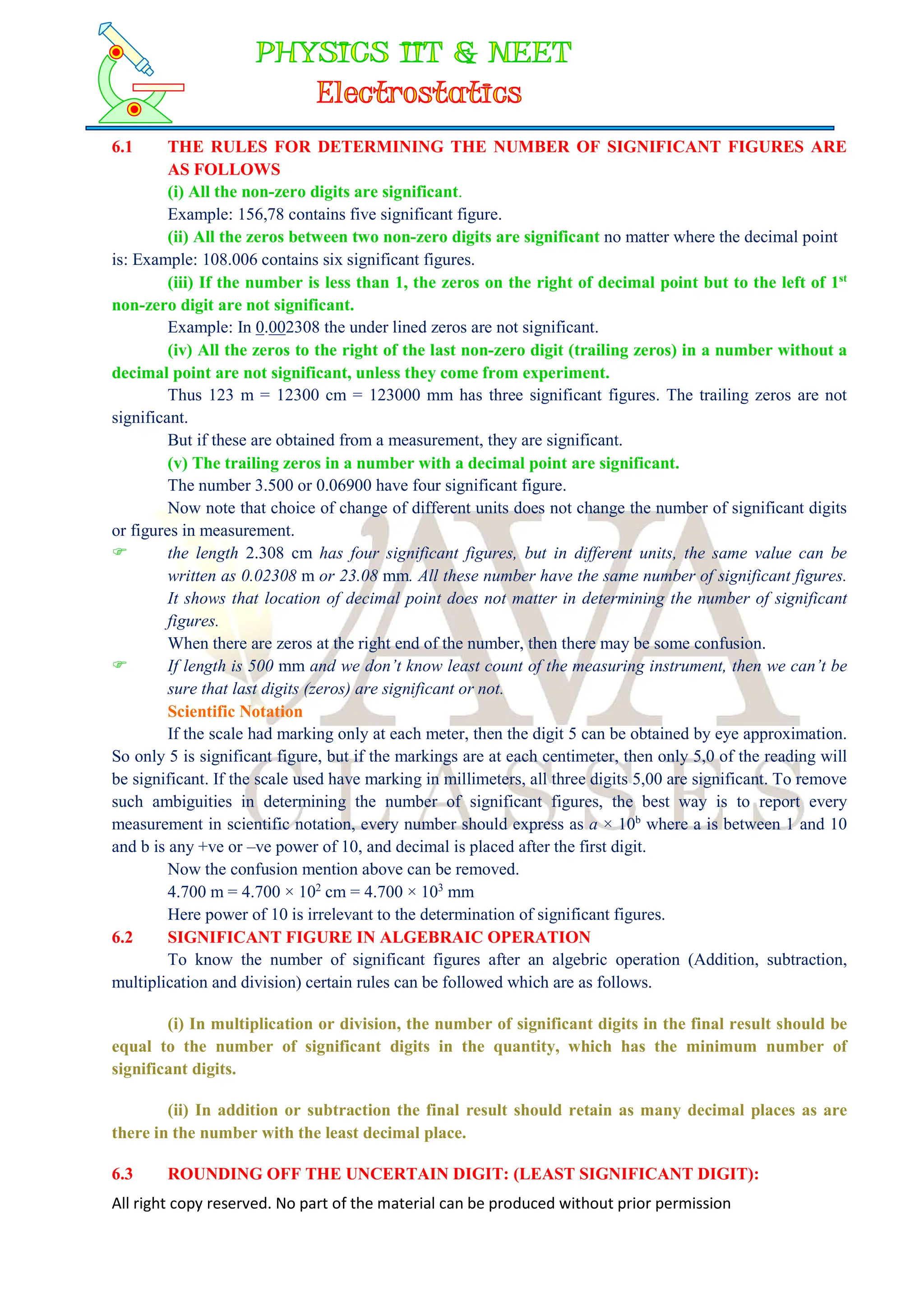
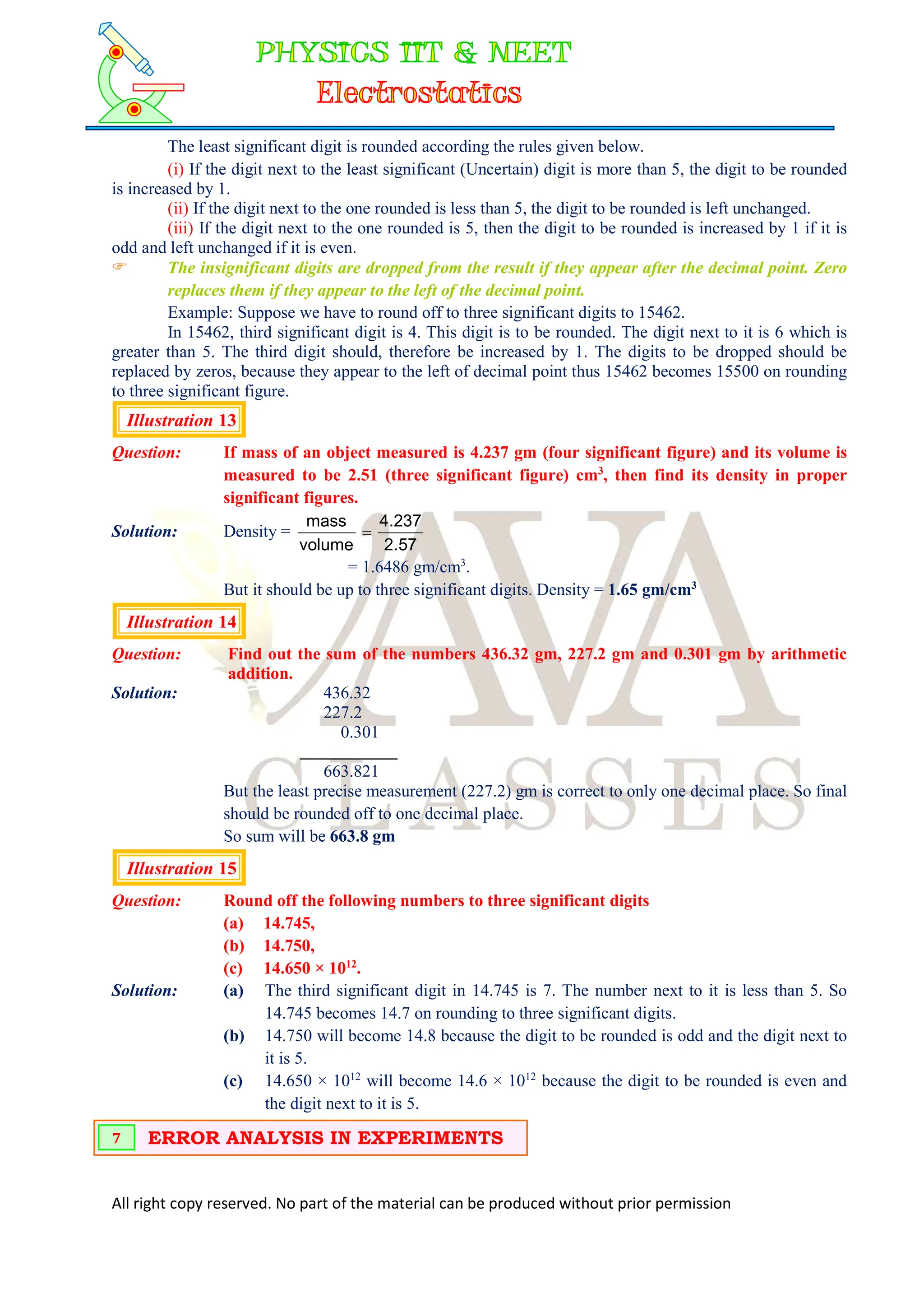
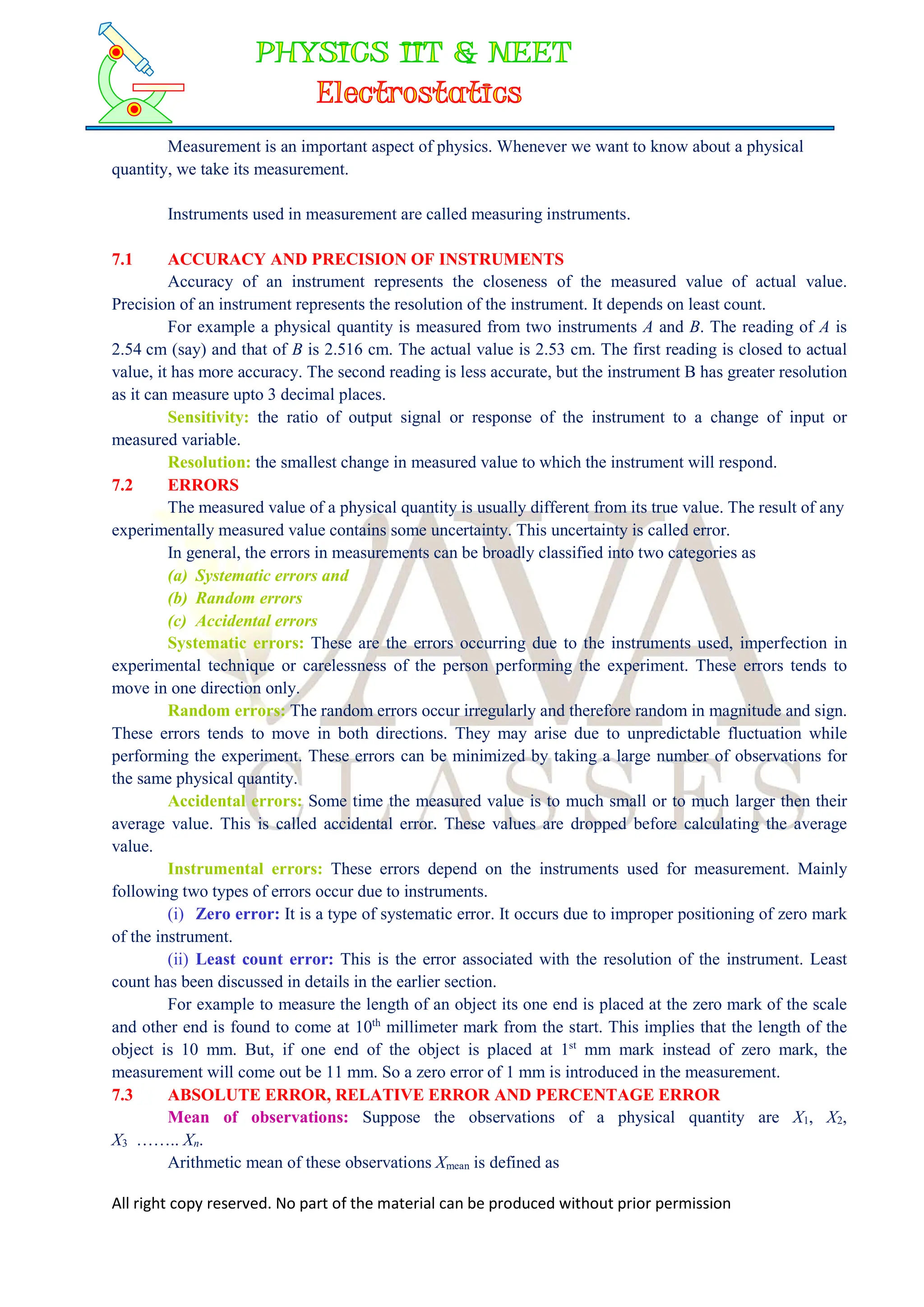
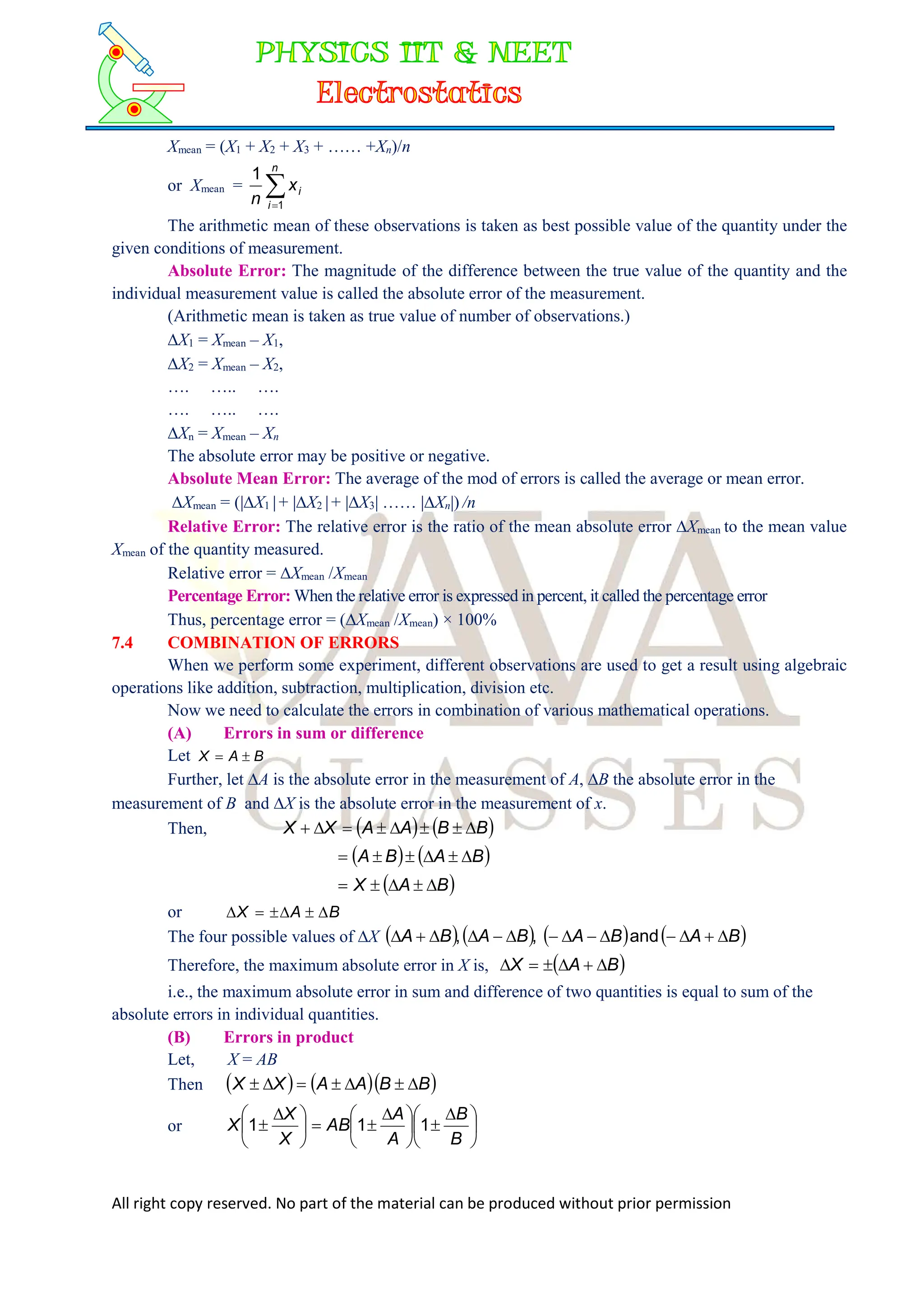
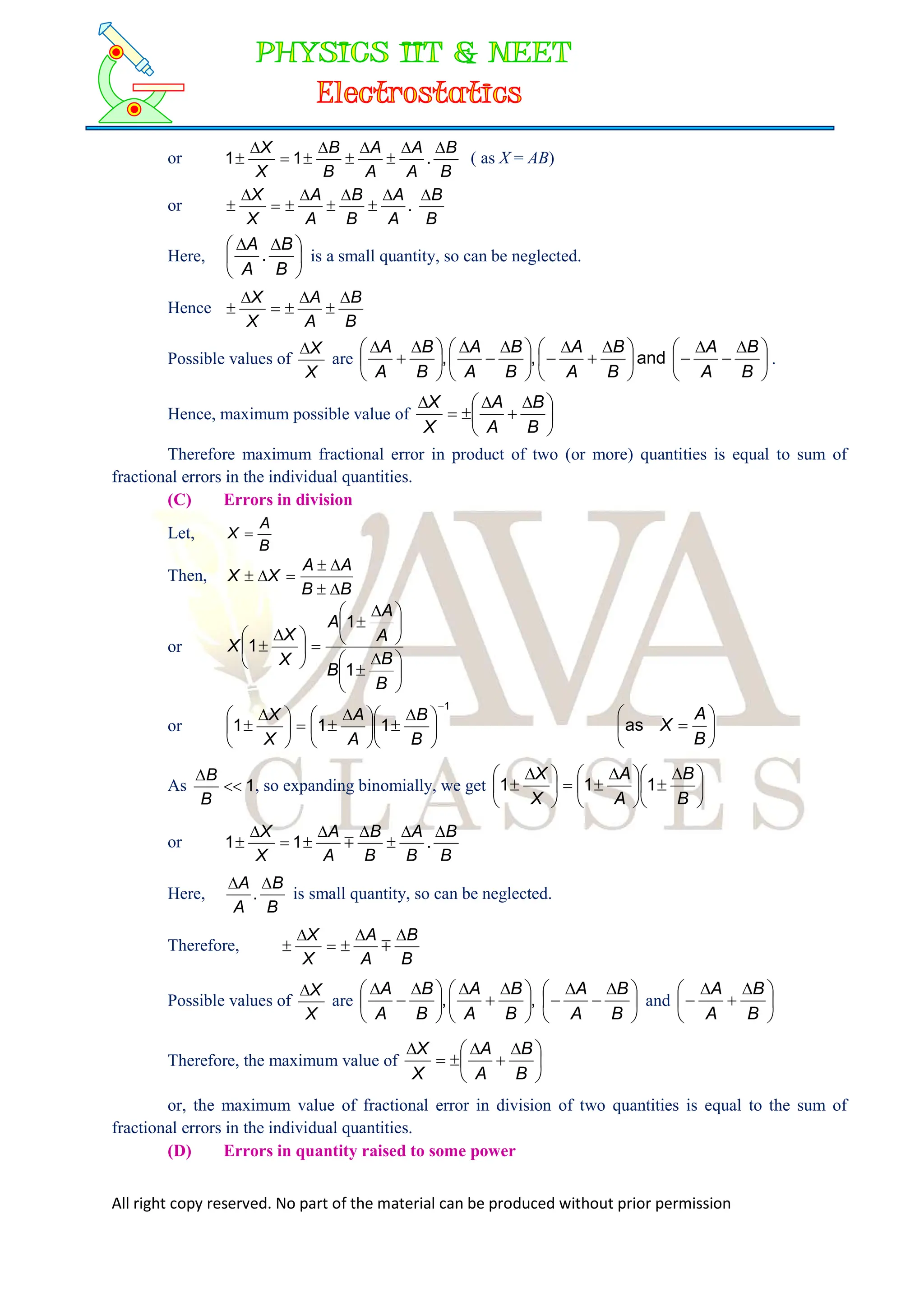
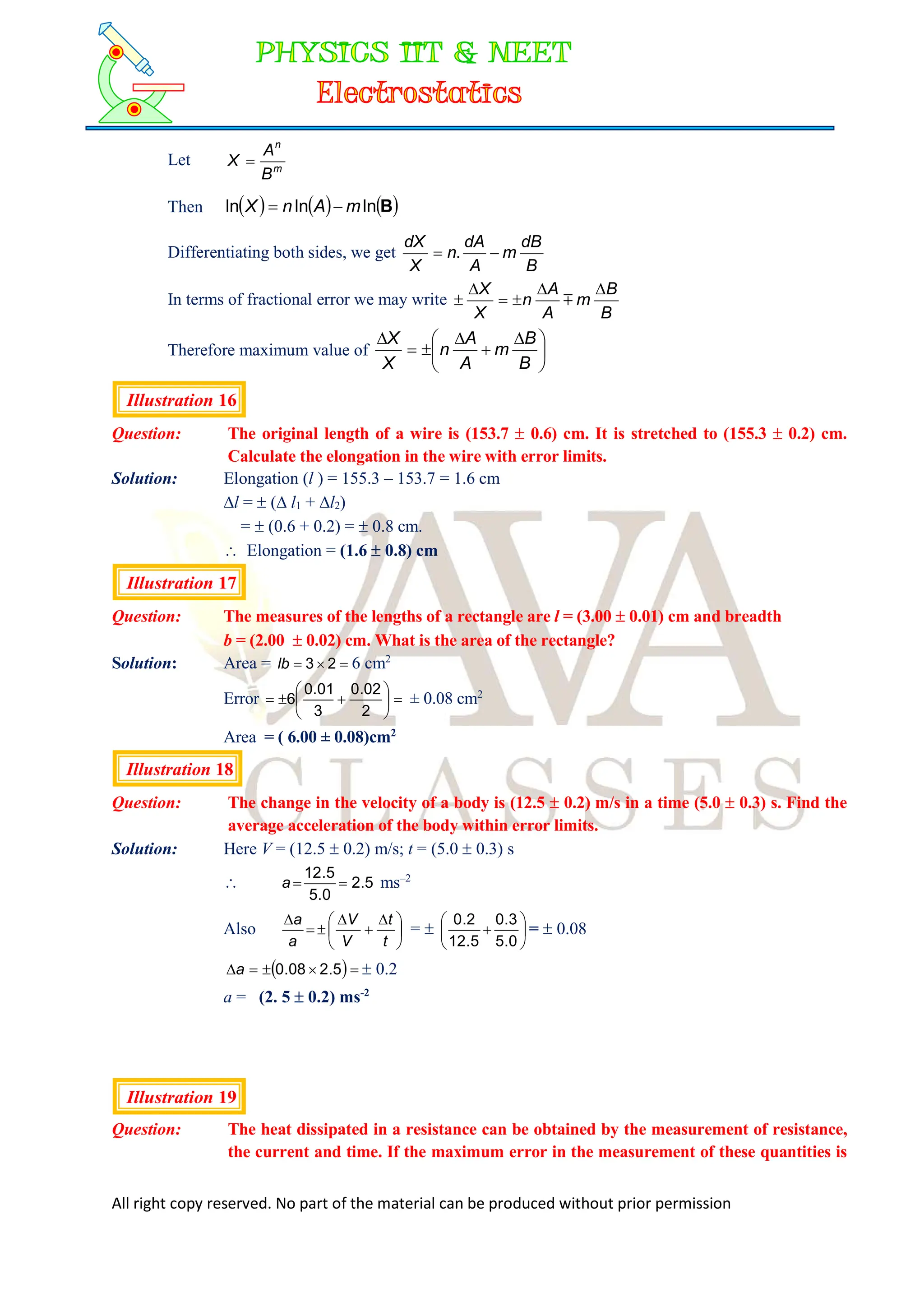
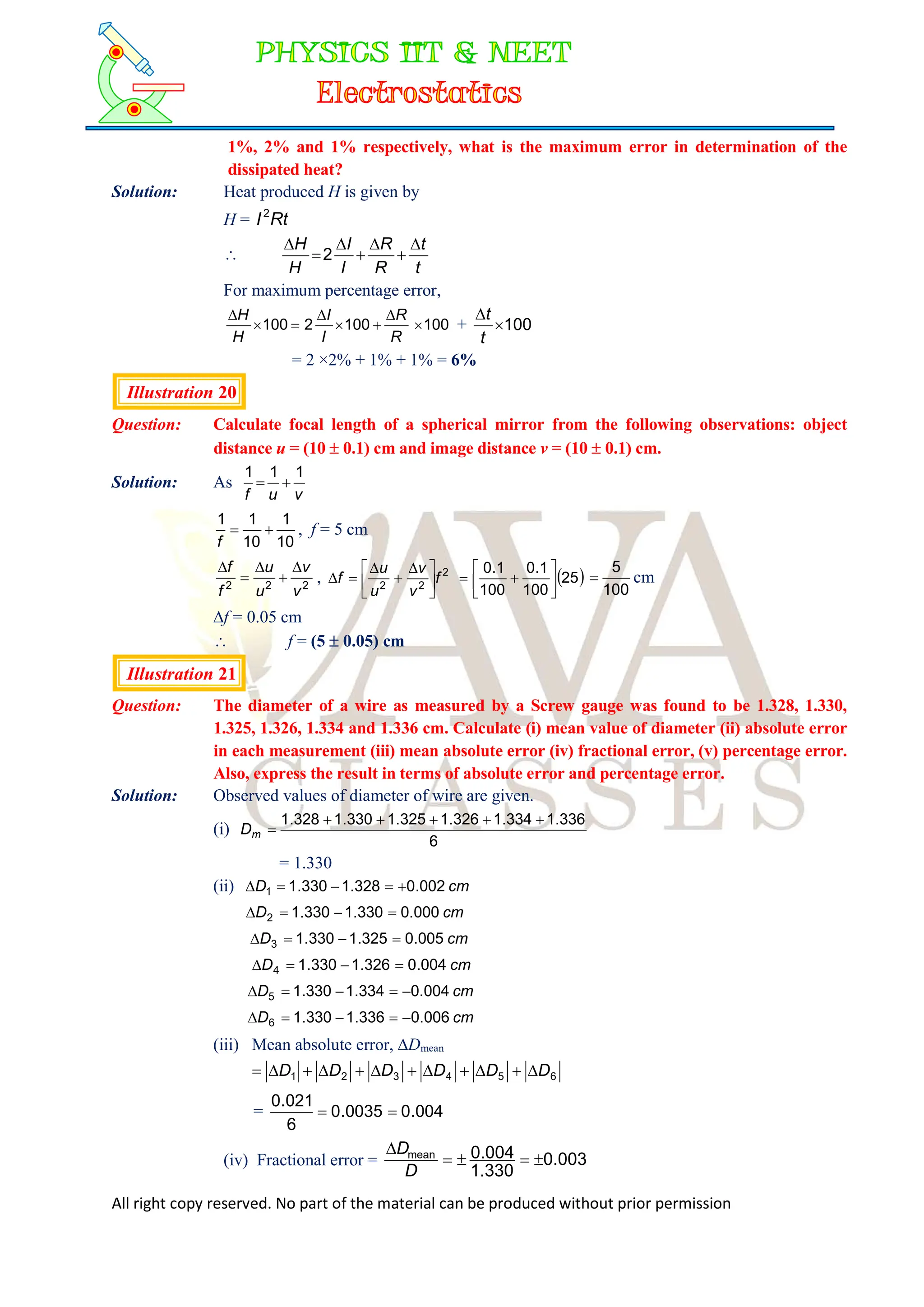
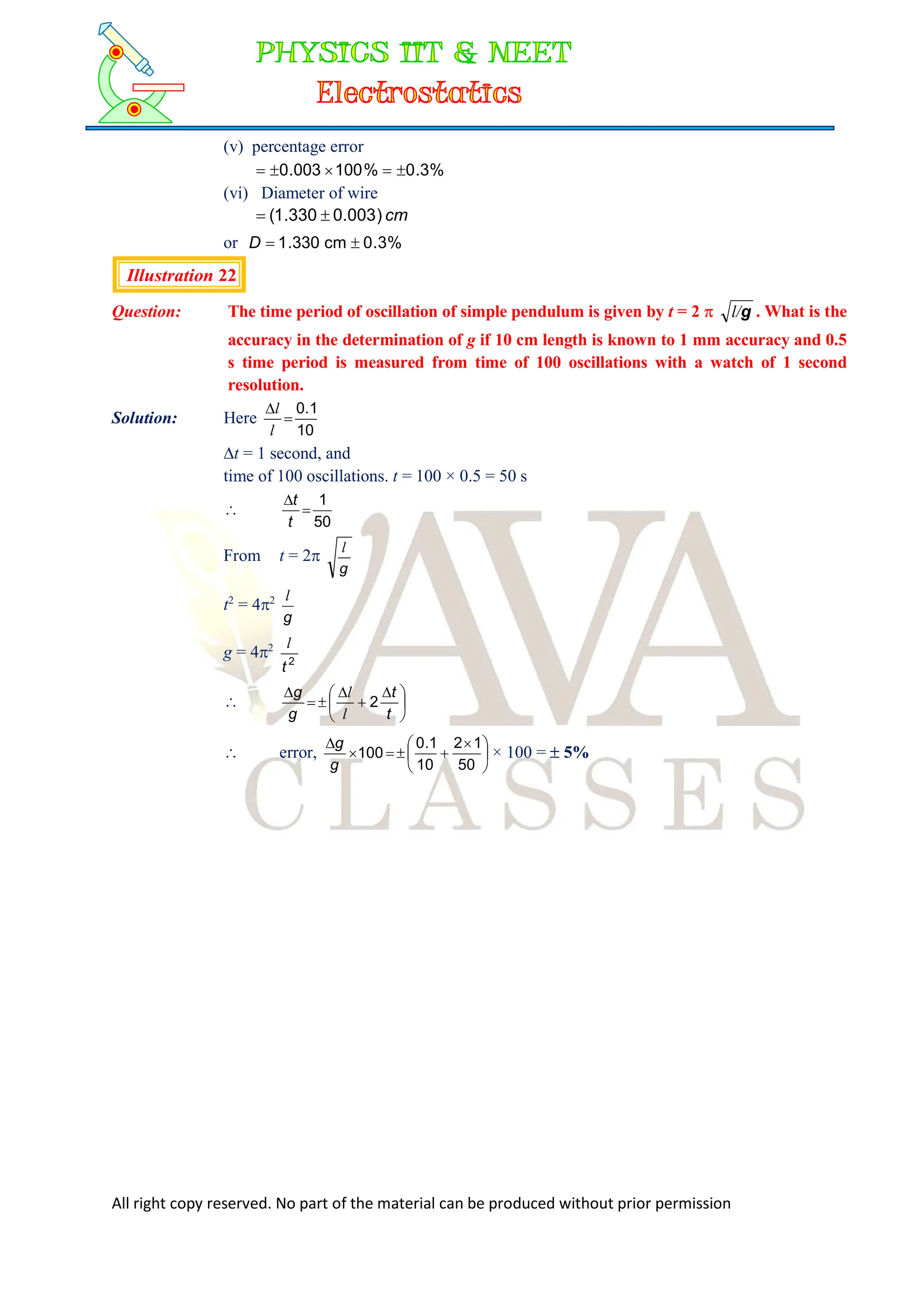


![All right copy reserved. No part of the material can be produced without prior permission
ANSWERS TO PROFICIENCY TEST
1. 2 × 106
dynes
2. 4.2 107
erg
3. 0.001293 g cm–3
4. 1 joule = 107
erg.
5. 5893 × 10–10
m ; 589.3 nm
6. (i) LT–2
, (ii) dimensionless. (iii) ML–3
, (iv) ML2
T–2
, (v) M–1
L3
T–2
, (vi) 2
2
A
MLT
7. Pressure and stress
8. Force
9. [mass] = [FTV–1
]
10. 3
11.
rp
k
13. LT–1
, LT–2
, L, T
14. [M°L°T–1
], [M0
L–1
T0
]
15.
r
v
m 2
K
F
16. (a) 1 (b) 3 (c) 4
17. (i) 0.0393 kg
(ii) 4.08 105
s
18. 17.7
19. 4.6 × 10–5
20. 3.6 × 105
21. 0.882 m2
22. 04
.
0
cm
78
.
1 cm
23. 1
ms
3
.
0
45
.
3
24. 1.8 %](https://image.slidesharecdn.com/unitdimensionsmeasurements-240129100521-dde0aa76/75/Unit-Dimensions-Measurements-Class-11-Physics-Chapter-1-Study-Material-in-pdf-34-2048.jpg)
![All right copy reserved. No part of the material can be produced without prior permission
25. %
9
SOLVED OBJECTIVE EXAMPLES
Example 1:
The dimensional formula for Planck’s constant (h) is
(a) ML–2
T–3
(b) ML2
T–2
(c) ML2
T –1
(d) ML–2
T–2
Solution:
E =
hc
[h] =
1
2
2
LT
L
T
ML
c
E
ML2
T–1
(c)
Example 2:
Of the following quantities, which one has dimensions different from the remaining three?
(a) energy per unit volume
(b) force per unit area
(c) product of voltage and charge per unit volume
(d) angular momentum per unit mass
Solution:
[energy per unit volume] = 2
1
3
2
2
T
ML
L
T
ML
[force per unit area] = 2
2
L
MLT
= ML–1
T –2
[product of voltage and charge per unit volume] = ML–1
T–2
[angular momentum per unit mass]= ML2
T–1
L. M–1
= L2
T–1
(d)
Example 3:
E, m, J and G denote energy, mass, angular momentum and gravitational constant
respectively. Then the dimensions of EJ 2
/m5
G2
are
(a) angle (b) length (c) mass (d) time
Solution:
2
2
3
1
5
2
1
2
2
2
2
5
2
)
T
L
(M
(M)
)
T
(ML
)
T
(ML
G
m
EJ
= M0
L0
T0
(a)
Example 4:
When 2.0347 is added to 15.7, the sum is
(a) 17.7347 (b) 17.734 (c) 17.73 (d) 17.7
Solution:
Since the least number of places after decimal is 1, the final result will have same. On rounding off
17.7347 to one place after decimal it becomes 17.7](https://image.slidesharecdn.com/unitdimensionsmeasurements-240129100521-dde0aa76/75/Unit-Dimensions-Measurements-Class-11-Physics-Chapter-1-Study-Material-in-pdf-35-2048.jpg)
![All right copy reserved. No part of the material can be produced without prior permission
(d)
Example 5:
A body travels uniformly a distance of
2
.
0
8
.
13 m in a time
3
.
0
0
.
4 s. The velocity of the
body within error limits is
(a) 1
ms
2
.
0
45
.
3
(b) 1
ms
3
.
0
45
.
3
(c) 1
ms
4
.
0
45
.
3
(d) 1
ms
5
.
0
45
.
3
Solution:
Here cm
2
.
0
8
.
13
S ;
3
.
0
0
.
4
t s
1
ms
45
.
3
0
.
4
8
.
13
V
Also
t
t
S
S
V
V
0895
.
0
0
.
4
3
.
0
8
.
13
2
.
0
3
.
0
V (rounding off to one place of decimal)
1
ms
0.3
3.45
V
(b)
Example 6:
The length and breadth of a metal sheet are 3.124 m and 3.002 m respectively. The area of
this sheet up to four correct significant figures is
(a) 9.376 m2
(b) 9.378 m2
(c) 9.379 m2
(d) 9.388 m2
Solution:
Given length (l) = 3.124 m and breadth (b) = 3.002 m.
We know that area of the sheet 2
m
378248
.
9
002
.
3
124
.
3
b
A l .
Since both length and breadth have four significant figures, therefore area of the sheet after
rounding off to four significant figures is 9.378 m2
(b)
Example 7:
The value of universal gravitation constant G = 6.67 10-11
N m2
kg-2
. The value of G in units
of g-1
cm3
s-2
is
(a) 6.67 10-8
(b) 6.67 10-7
(c) 6.67 10-9
(d) 6.67 10-10
Solution:
G = 6.67 10-11
Nm2
kg-2
= 6.67 10-11
(kg ms-2
) (m2
) (kg)-2
= 6.67 10-11
[ (1000 g ) (100 cm) s-2
] (100 cm)2
(1000 g)-2
= 6.67 10-11
105
104
10-6
g-1
cm3
s-2
= 6.67 10-8
g-1
cm3
s-2
(a)
Example 8:
If energy (E), momentum (P) and force (F) are chosen as fundamental units. The dimensions of
mass in new system is](https://image.slidesharecdn.com/unitdimensionsmeasurements-240129100521-dde0aa76/75/Unit-Dimensions-Measurements-Class-11-Physics-Chapter-1-Study-Material-in-pdf-36-2048.jpg)
![All right copy reserved. No part of the material can be produced without prior permission
(a) E -1
P3
(b) E -1
P2
(c) E -2
P2
(d) none of these
Solution:
The dimensions of E, P and F in terms of M, L and T are
[E] = ML2
T-2
[P] = MLT-1
[F] = MLT-2
Let [M] = Ea
Pb
FC
or [M] = (ML2
T-2
)a
(MLT-1
)b
(MLT-2
)C
Equating the powers of M, L and T, we have a = -1, b = 2 and c = 0
Hence [M] = E-1
P2
(b)
Example 9:
Two full turns of the circular scale of a screw gauge cover a distance of 1 mm on its main
scale. The total number of divisions on circular scale is 50. Further, it is found that screw
gauge has a zero error of – 0.03 mm. While measuring the diameter of a thin wire, a student
notes the main scale reading of 3 mm and the number of circular scale divisions in line with
the main scale as 35. The diameter of the wire is
(a) 3.67 mm (b) 3.38 mm (c) 3.32 mm (d) 3.73 mm
Solution:
Least count = mm
01
.
0
50
mm
5
.
0
Zero error = – 0.03 mm (Given)
Measured diameter = 3 mm + 35 × 0.01 mm = 3.35 mm
Correct diameter = 3.35 – (–0.03 mm) = 3.38 mm
(b)
Example 10:
A body of mass m = 3.513 kg is moving along the x-axis with a speed of 5.00 ms–1
. The
magnitude of momentum is recorded as
(a) 17.56 kg ms–1
(b) 17.57 kg ms–1
(c) 17.6 kg ms–1
(d) 17.565 kg ms–1
Solution:
p = mv = 3.513 × 5.00 = 17.565 kg ms–1
Since the result cannot have more than three significant figures
p = 17.6 kg ms–1
(c)](https://image.slidesharecdn.com/unitdimensionsmeasurements-240129100521-dde0aa76/75/Unit-Dimensions-Measurements-Class-11-Physics-Chapter-1-Study-Material-in-pdf-37-2048.jpg)
![All right copy reserved. No part of the material can be produced without prior permission
SOLVED SUBJECTIVE EXAMPLES
Example 1:
Find the dimensions of the following quantities
(i) Acceleration (ii) Angle (iii) Density
(iv) Kinetic energy (v) Gravitational constant
Solution:
(i) Acceleration =
Time
Velocity
[Acceleration] =
[Time]
[Velocity]
= 2
1
LT
T
LT
(ii) Angle =
Distance
Distance
angle is dimensionless.
(iii) Density =
Volume
Mass
[Density] =
]
Volume
[
]
Mass
[
= 3
3
ML
L
M
(iv) Kinetic energy =
2
1
Mass × Velocity2
[Kinetic energy] = [Mass] × [Velocity]2
= ML2
T–2
(v) Constant of gravitation occurs in Newton’s law of gravitation
F = G 2
2
1
d
m
m
[G] = 2
3
1
2
2
2
1
2
T
L
M
MM
L
MLT
]
[
]
[
]
[
]
[
m
m
d
F
Example 2:
Check by the method of dimensional analysis whether the following relations are correct.
(i) v =
D
P
where v = velocity of sound and
P = pressure, D = density of medium.
(ii) n =
m
F
l
2
1
, where n = frequency of vibration, l = length of the string.
F = stretching force, m = mass per unit length of the string.
Solution:
(i) [R.H.S.] =
]
[
]
[
D
P
3
2
1
ML
T
ML
= LT–1
[L.H.S] = [v] = LT–1
Hence the relation is correct.
(ii) [R.H.S.] = 1
1
1
2
T
LT
L
1
ML
MLT
1
]
[
]
[
]
[
1
L
m
F
l
[L.H.S.] =
Time
Number
A
= 1
T
T
1
. Hence the result is correct.
Example 3:
Round off to three significant digits
(i) 0.03927 kg (ii) 4.085 × 105
Solution:
(i) 0.0393 kg ( the last digit 7 > 5)
(ii) 4.08 × 105
s ( the digit to be rounded off is 5 and preceding digit is even)](https://image.slidesharecdn.com/unitdimensionsmeasurements-240129100521-dde0aa76/75/Unit-Dimensions-Measurements-Class-11-Physics-Chapter-1-Study-Material-in-pdf-38-2048.jpg)
![All right copy reserved. No part of the material can be produced without prior permission
Example 4:
The velocity v of a particle depends on the time t according to the equation v = a + bt +
t
d
c
.
Write the dimensions of a, b, c and d.
Solution:
From principle of homogeneity
[a] = [v]
or [a] = LT–1
[bt] = [v]
or [b] =
T
LT
]
[
]
[ 1
t
v
or [b] = LT–2
Similarly, [d ] = [t ] = T
Further, ]
[
]
[
]
[
v
t
d
c
or [c] = [v] [d + t ]
or [c] = LT -1
.T
or [c] = L
Example 5:
The moment of inertia of a body rotating about a given axis is 6.0 kg m2
in the SI system.
What is the value of the moment of inertia in a system of units in which the unit of length is 5
cm and the unit of mass is 10 g?
Solution:
The dimensions of moment of inertia are (ML2
). We have
2
2
1
1 u
n
u
n
or
2
2
2
2
2
1
1
1 L
M
L
M n
n
2
2
1
2
1
1
2
2
2
2
1
1
1
2
L
L
M
M
L
M
L
M
n
n
n
Given n1 = 6.0, M1 = 1 kg, L1 = 1 m, M2 = 10 g and L2 = 5 cm.
Therefore,
2
2
cm
5
m
1
g
10
kg
1
0
.
6
n
2
cm
5
cm
100
g
10
g
1000
0
.
6
2
20
100
0
.
6
= 2.4 105
units
Example 6:
The time period T of the oscillations of a large star, oscillating under its own gravitational
attraction, may depend on its mean radius R, its mean density and the gravitation constant
G. Using dimensional analysis, show that T is independent of R and is given by
G
k
T
where k is a dimensionless constant.
Solution:
Let c
b
a
G
kR
T
Substituting the dimensions, we have](https://image.slidesharecdn.com/unitdimensionsmeasurements-240129100521-dde0aa76/75/Unit-Dimensions-Measurements-Class-11-Physics-Chapter-1-Study-Material-in-pdf-39-2048.jpg)
![All right copy reserved. No part of the material can be produced without prior permission
[ T ] c
2
3
1
b
3
a
T
L
M
ML
L
Equating powers of M, L and T, we have
0 = b – c
0 = a – 3b + 3c
and 1 = -2c
which give a = 0, b = -1/2 and c = -1/2
Hence 2
1
0
kR
T 2
1
G
or T
G
k
Thus T is independent of R
Example 7:
A rectangular plate has a length of (21.3 0.2) cm and a width of (9.80 0.10) cm. Find the
area of the plate.
Solution:
Area (A) = lb = 21.3 9.8 = 209 cm2
019
.
0
8
.
9
1
.
0
3
.
21
2
.
0
A
A
A =
209
019
.
0
= 2
cm
3.97
2
cm
4
A = 2
cm
4
209
Example 8:
The heat dissipated in a resistance can be obtained by the measurement of resistance, the
current and time. If the maximum error in the measurement of these quantities is 1%, 2% and
1% respectively, what is the maximum error in determination of the dissipated heat?
Solution:
Heat produced H is given by
H =
J
Rt
I2
J
J
t
t
R
R
I
I
H
H
2
For maximum percentage error,
100
100
2
100
R
R
I
I
H
H
+ 100
100
J
J
t
t
= 2 ×2% + 1% + 1% + 0% = 6%
Example 9:
In an experiment, values of two resistances are measured to be r1 = (5.0 0.2) ohm and
r2 = (10.0 0.1) ohm. Find the values of total resistance in parallel with limits of percentage
error.
Solution:
Combined resistance in parallel (Rp) is given by
2
1
1
2
2
1
1
1
1
r
r
r
r
r
r
Rp
Rp =
2
1
2
1
r
r
r
r
15
50
3.33 As
2
1
1
1
1
r
r
Rp
Differentiating we get](https://image.slidesharecdn.com/unitdimensionsmeasurements-240129100521-dde0aa76/75/Unit-Dimensions-Measurements-Class-11-Physics-Chapter-1-Study-Material-in-pdf-40-2048.jpg)
![All right copy reserved. No part of the material can be produced without prior permission
2
2
2
2
1
1
2 r
dr
r
dr
R
dR
p
p
or
2
2
1
2
1
1
2 r
dr
r
dr
R
dR
p
p
2
2
2
)
0
.
10
(
1
.
0
)
0
.
5
(
2
.
0
)
33
.
3
(
p
dR
1
.
0
p
dR
So
)
1
.
0
3
.
3
(
p
R
Example 10:
A helicopter can hover when the power of its engine is P. A second helicopter is an exact copy
of the first one but its linear dimensions are double those of the original. What power output
is needed to enable this second helicopter to hover?
Solution
The required power for the hovering helicopter should depend on acceleration due to gravity g,
linear size of helicopter L, average density of its material and density of air 0
So, let d
c
b
a
L
g
P 0
Or d
c
b
a
L
g
k
P 0
where k is a dimensionless constant
d
c
b
a
k ]
ML
[
]
ML
[
]
L
[
]
LT
[
]
T
L
M
[ 3
3
2
3
2
1
c + d = 1
a + b – 3c – 3d = 2
– 2a = – 3 a =
2
3
Or
2
1
)
(
3
d
c
b
2
1
3
b [ c + d = 1]
2
7
b
So it is clear that 2
7
L
P
2
8
22
7
'
P
P P so P
P 31
.
11
'
So power of the second helicopter should be 11.31 times the power of the first helicopter.](https://image.slidesharecdn.com/unitdimensionsmeasurements-240129100521-dde0aa76/75/Unit-Dimensions-Measurements-Class-11-Physics-Chapter-1-Study-Material-in-pdf-41-2048.jpg)
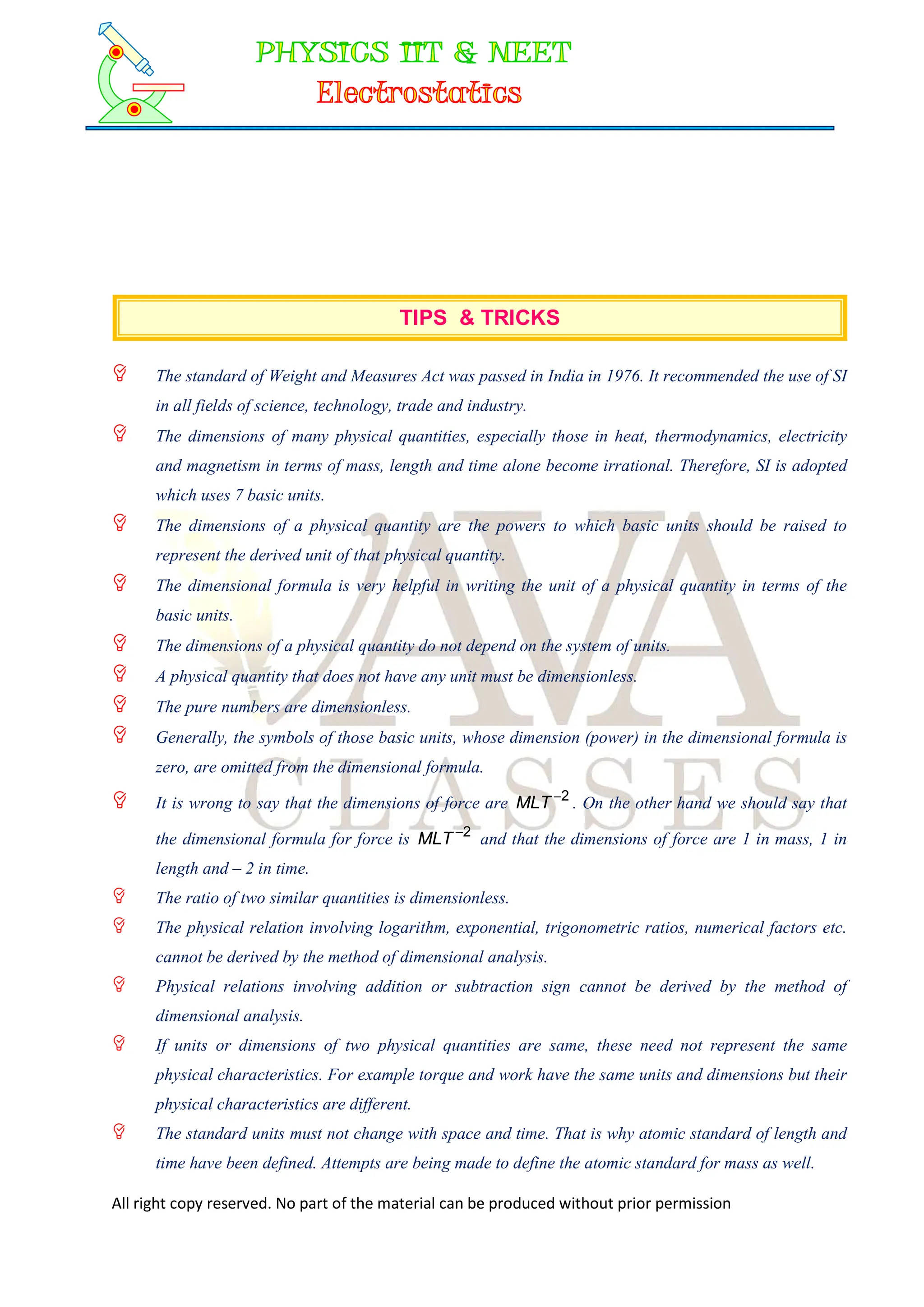
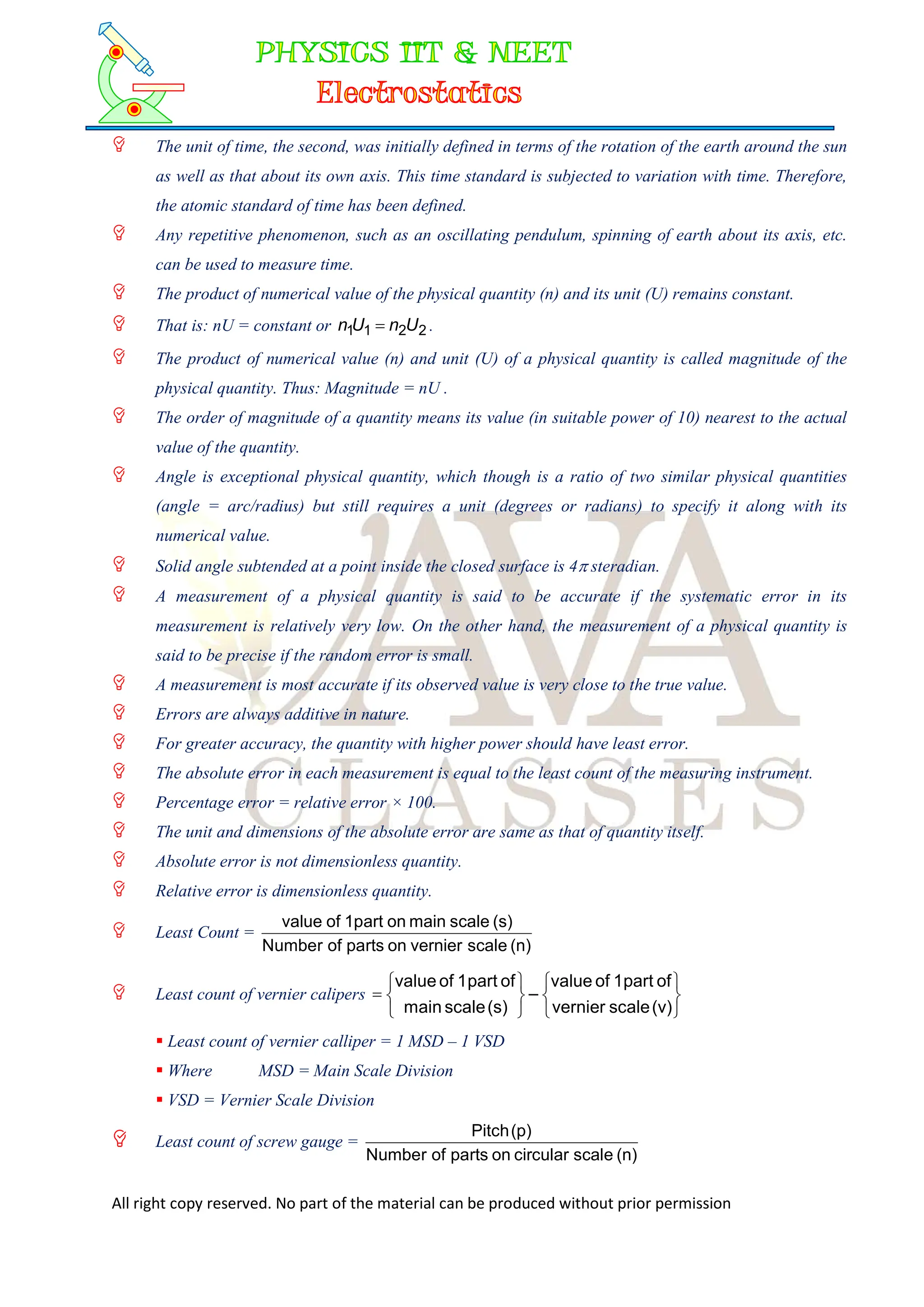

![All right copy reserved. No part of the material can be produced without prior permission
EXERCISE - I
NEET SINGLE CHOICE CORRECT
1. If velocity (V), acceleration (A) and force (F) are taken as fundamental quantities instead of mass
(M), length (L) and time (T), the dimensions of Young’s modulus of elasticity would be (with M,
L and T as fundamental, [Young’s modulus] = ML–1
T–2
(a) FA2
V–2
(b) FA2
V–3
(c) FA2
V–4
(d) FA2
V–5
2. The number of particles crossing per unit area perpendicular to X-axis in unit time is
N = –D
1
2
1
2
x
x
n
n
Where n1 and n2 are number of particles per unit volume for the value of x1 and x2 respectively.
The dimensions of diffusion constant D are
(a) M°LT2
(b) M°L2
T–4
(c) M°LT–3
(d) M°L2
T–1
3. The dimensional formula for latent heat is
(a) M°L2
T –2
(b) MLT –2
(c) ML2
T –2
(d) ML2
T –1
4. The result after adding 3.8 × 10–6
with 4.2 × 10–5
with due regard to significant figure is
(a) 4.58 × 10–5
(b) 0.458 × 10–4
(c) 4.6 × 10–5
(d) 45.8 × 10–6
5. A dimensionally consistent relation for the volume V of a liquid of coefficient of viscosity
flowing per second through a tube of radius r and length l and having a pressure difference p
across its end is
1
1
T
ML
η
(a) V = pr4
/8l (b) V = l/8 pr4
(c) V = 8 pl/r4
(d) V = p /8lr4
6. The volume of a sphere is 1.76 cm3
. The volume of 25 such spheres taking into account the
significant figure is
(a) 0.44 × 102 cm3
(b) 44.0 cm3
(c) 44 cm3
(d) 44.00 cm3](https://image.slidesharecdn.com/unitdimensionsmeasurements-240129100521-dde0aa76/75/Unit-Dimensions-Measurements-Class-11-Physics-Chapter-1-Study-Material-in-pdf-45-2048.jpg)
![All right copy reserved. No part of the material can be produced without prior permission
7. Which of the following has not been expressed in proper units? [stress = force /Area, surface
tension = force/length]
(a) stress/strain = N/m2
(b) surface tension = N/m
(c) energy = kg × m/s (d) pressure = N/m2
8. Suppose the acceleration due to gravity at a place is 10 m/s2
. Its value in cm/(minute)2
is
(a) 36 105
(b) 6 104
(c) 36 104
(d) none of these
9. If x = an
, then fractional error
x
x
is equal to
(a)
n
a
a
(b) n
a
a
(c) n loge
a
a
(d) n log
a
a
10. What is the percentage error in the measurement of time period of a pendulum if maximum errors
in the measurement of ‘I’ and g’ are 2% and 4% respectively?
(a) 6% (b) 4% (c) 3% (d) 5%
11. A physical quantity is represented by X = Ma
Lb
T–c
. If percentage error in the measurement of M, L
and T are %, % and % respectively, then the maximum percentage error in calculating X is
(a) (a – b + c)% (b) (a + b + c)% (c) (a – b – c)% (d) none of the above
12. The density of a cube is measured by measuring its mass and the length of its sides. If the
maximum errors in the measurement of mass and length are 3% and 2% respectively, then the
maximum error in the measurement of density is
(a) 9% (b) 7% (c) 5% (d) 1%
13. What is a vernier constant?
(a) It is the value of one main scale division divided by the total number of division on the main
scale
(b) It is the value of one vernier scale division divided by the total number of divisions on the
vernier scale
(c) It is the difference between value of one main scale division and one vernier scale division.
(d) It is not the least count of the vernier scale.
14. Choose the wrong statement for zero error and zero correction.
(a) If the zero of the vernier scale does not coincide with the zero of the main scale then the
instrument is said to be having a zero error.
(b) Zero correction has a magnitude equal to zero error but sign is opposite to that of the zero
error.
(c) Zero error is positive when the zero of vernier scale lies to the left of the zero of the main
scale.
(d) None of these is wrong.](https://image.slidesharecdn.com/unitdimensionsmeasurements-240129100521-dde0aa76/75/Unit-Dimensions-Measurements-Class-11-Physics-Chapter-1-Study-Material-in-pdf-46-2048.jpg)
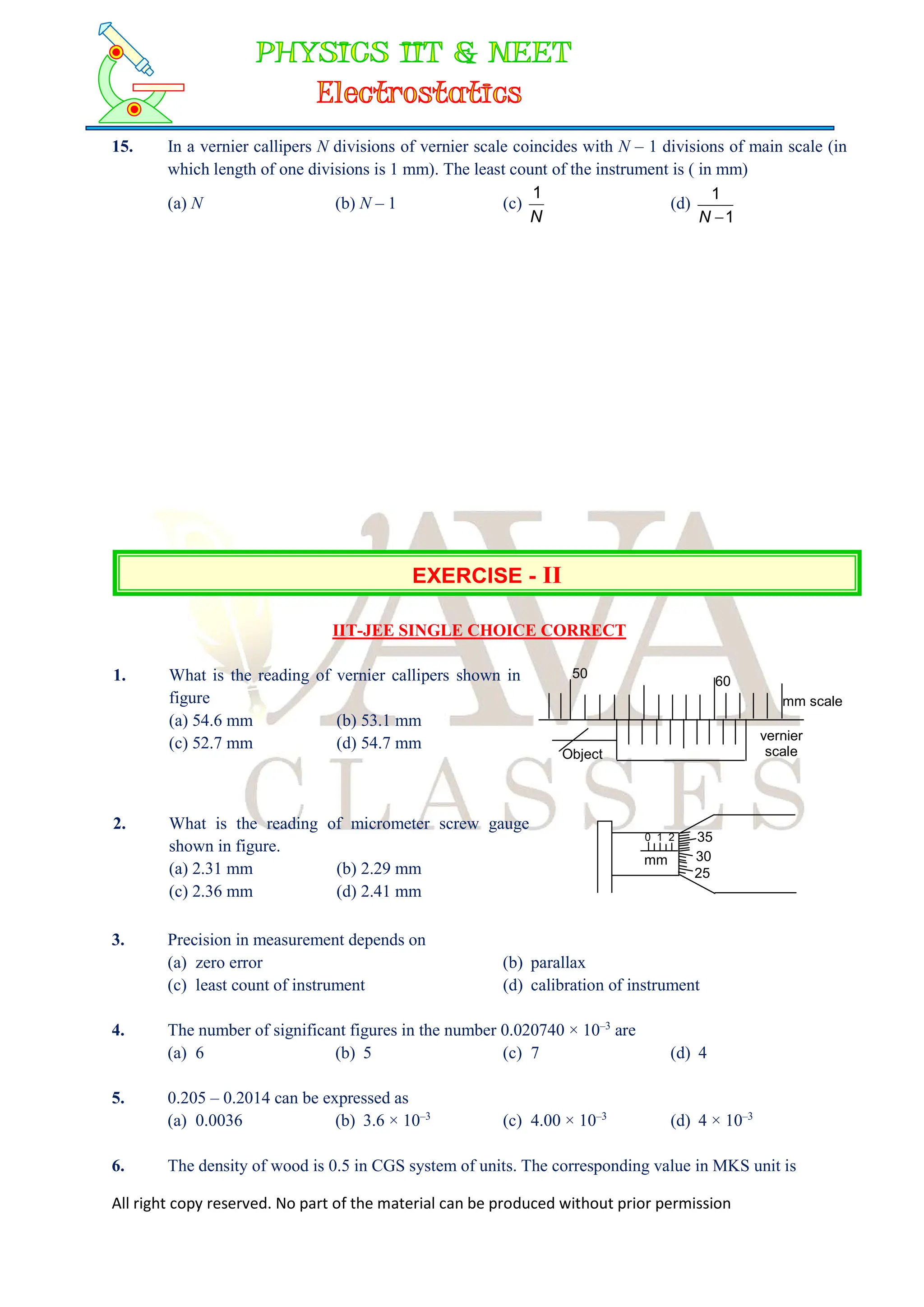
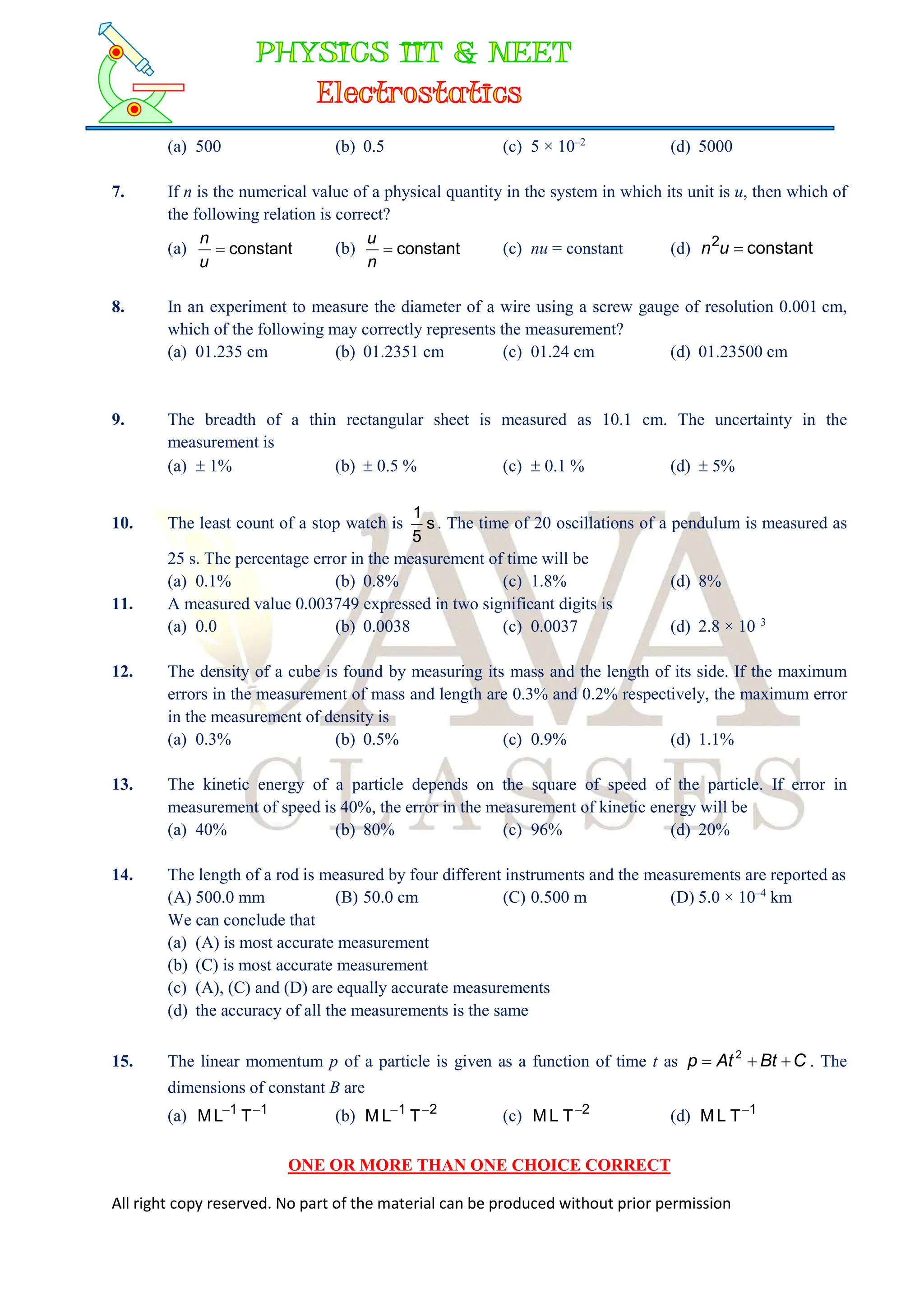
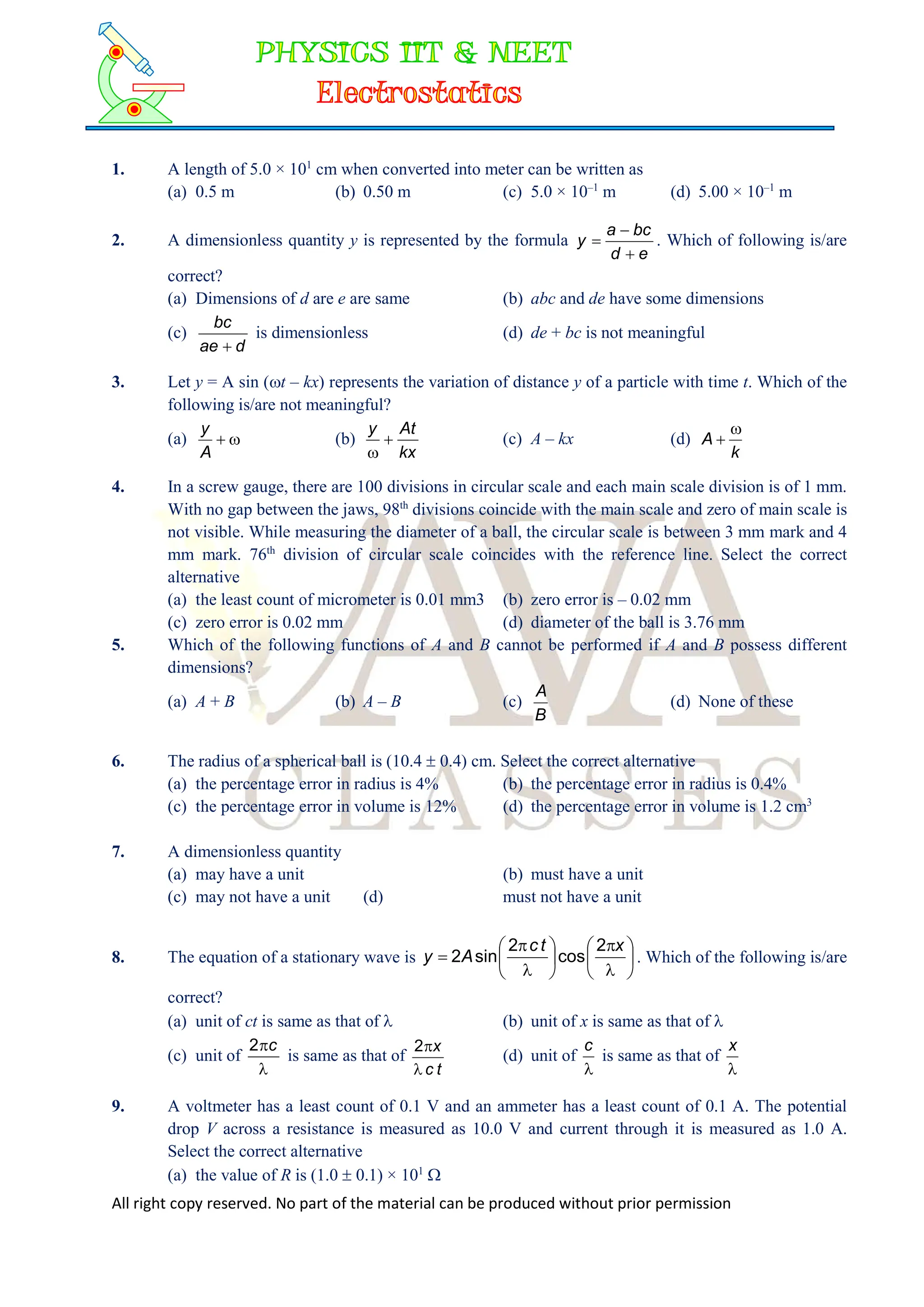
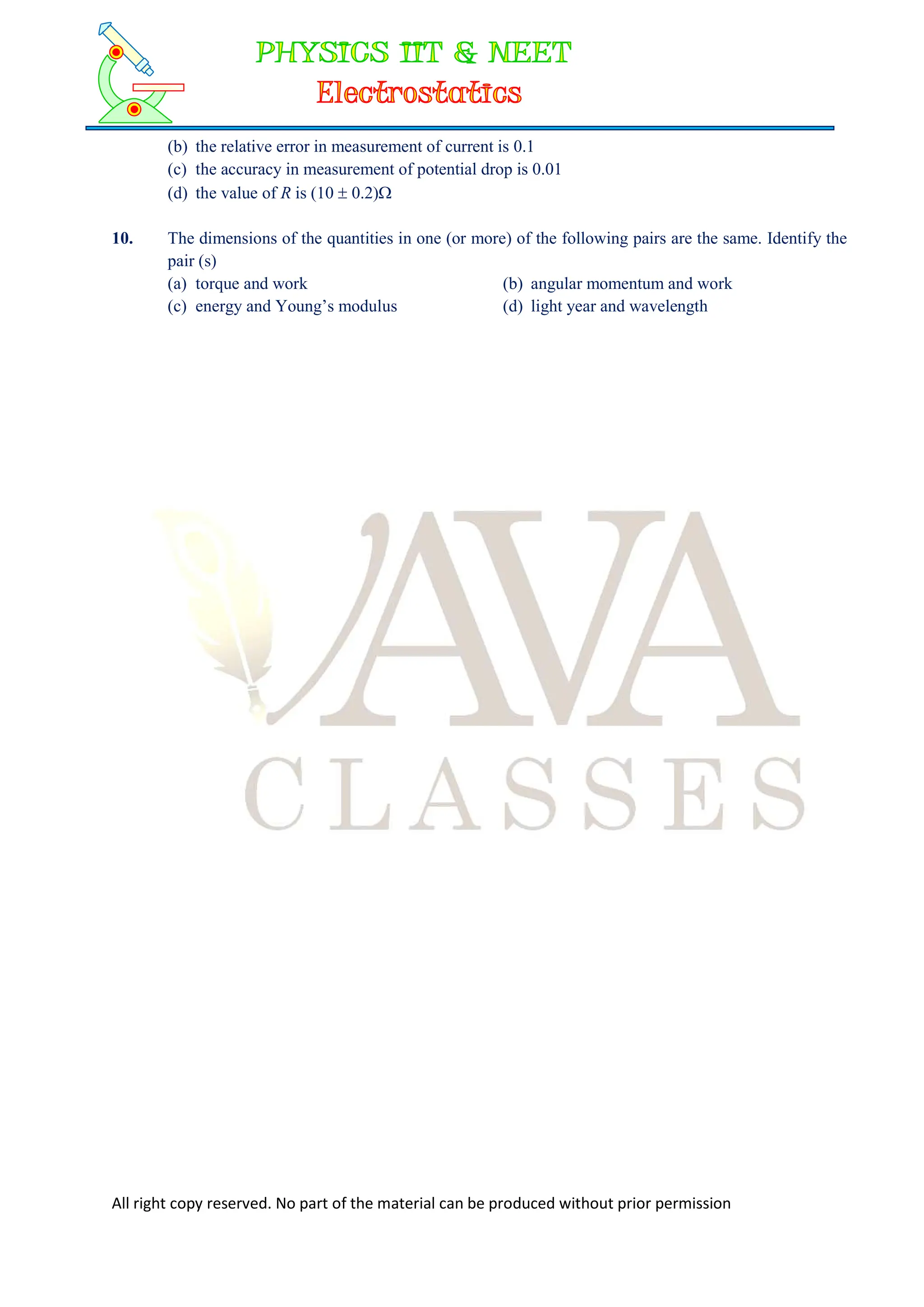
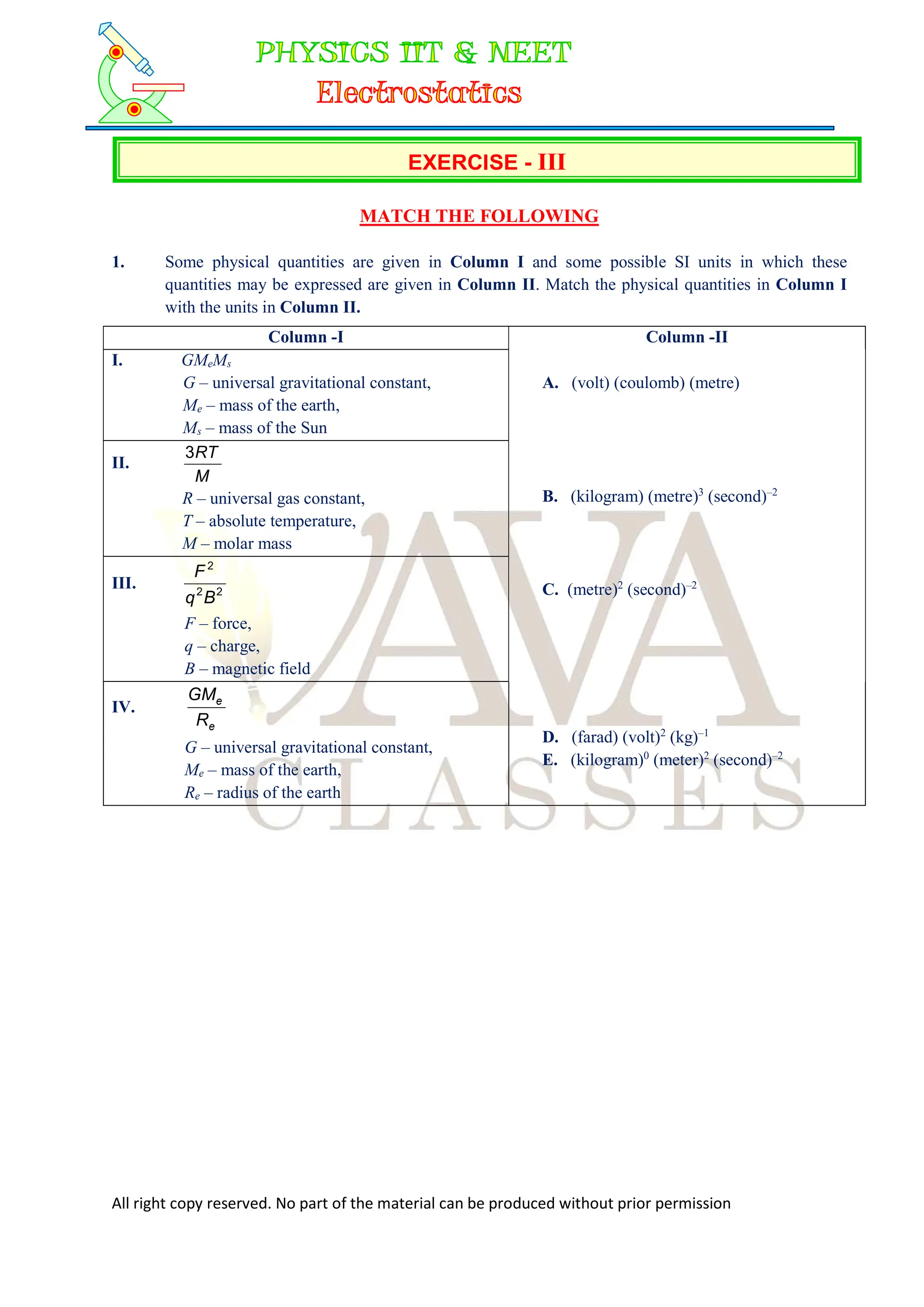
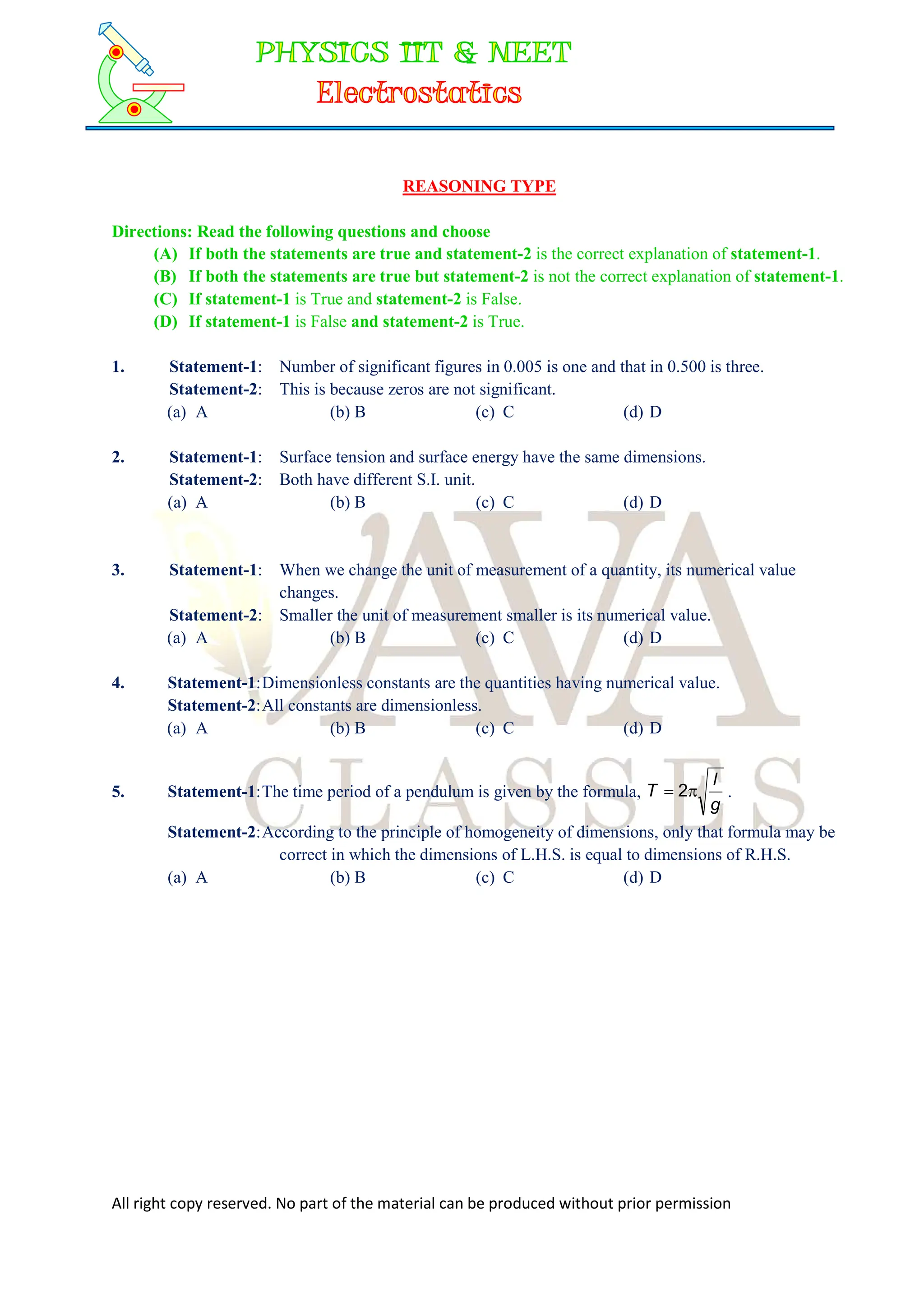
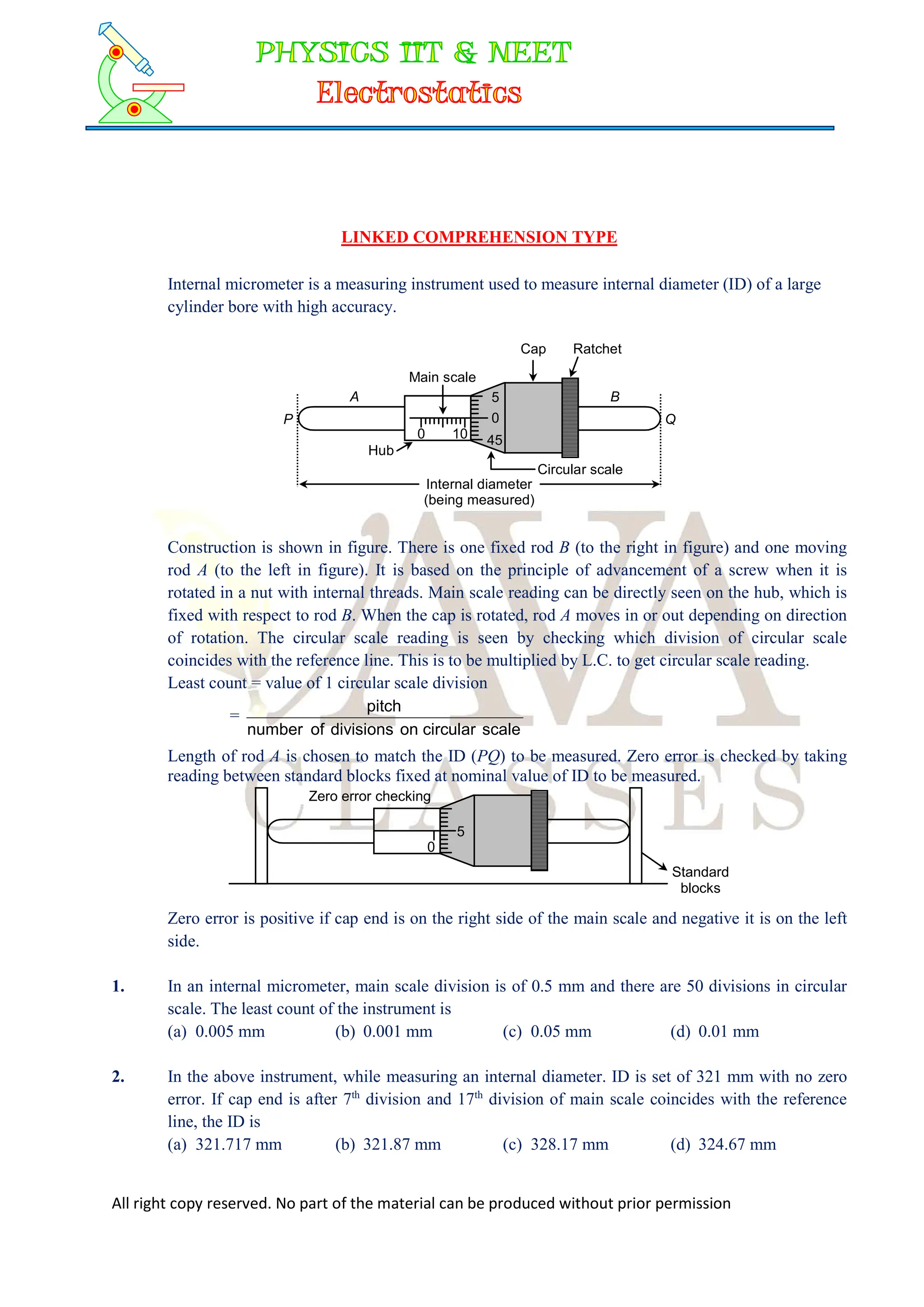
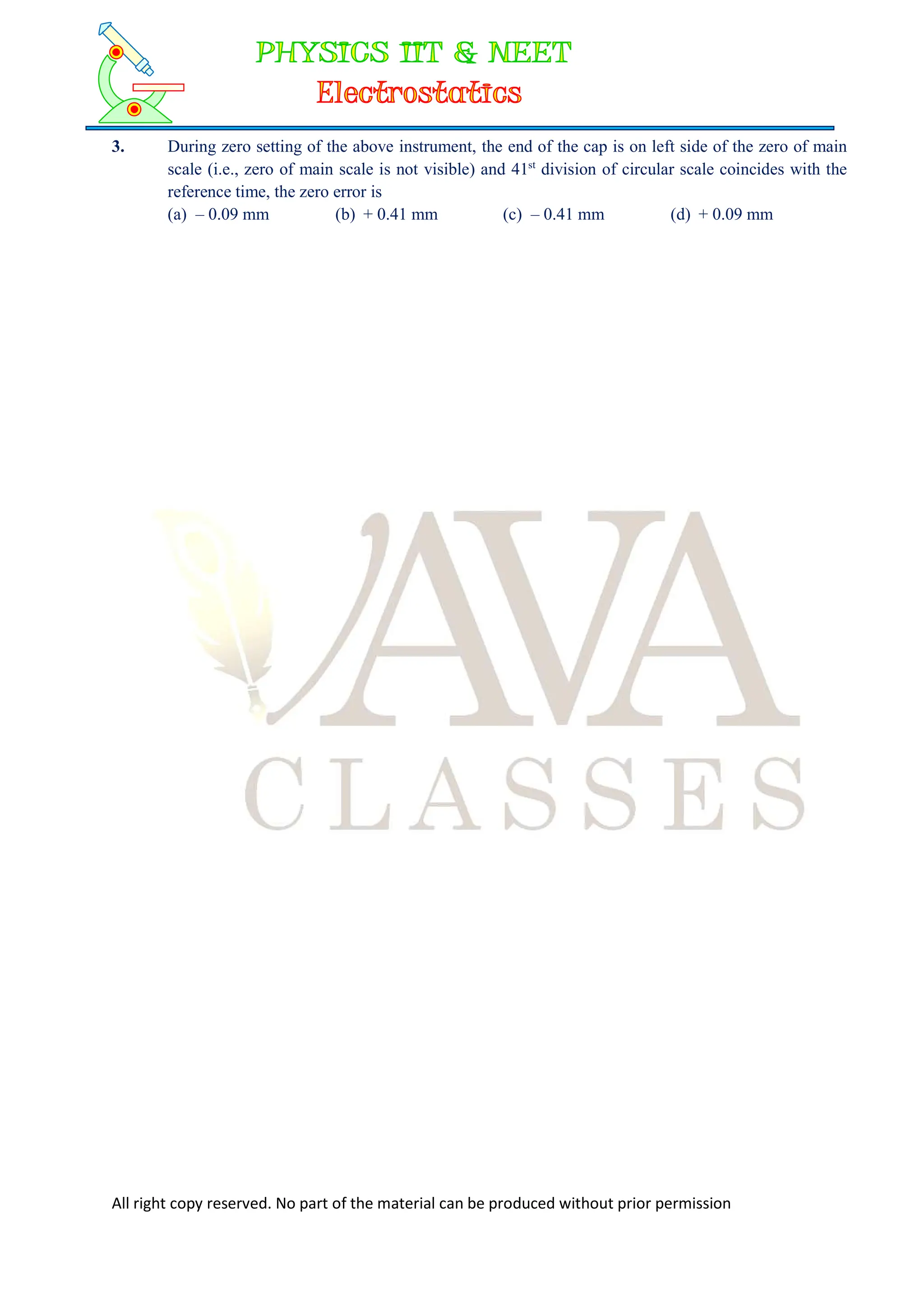
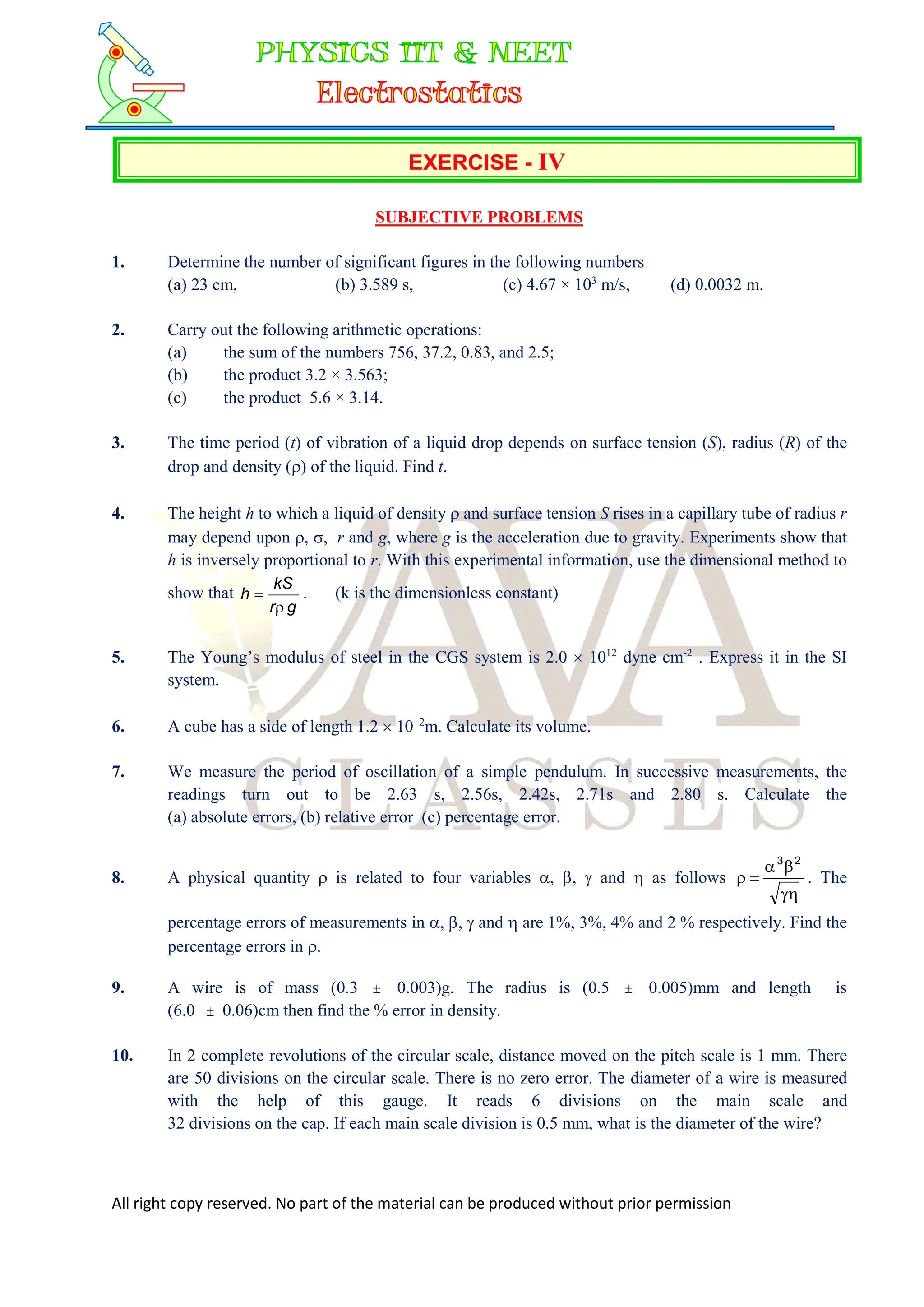
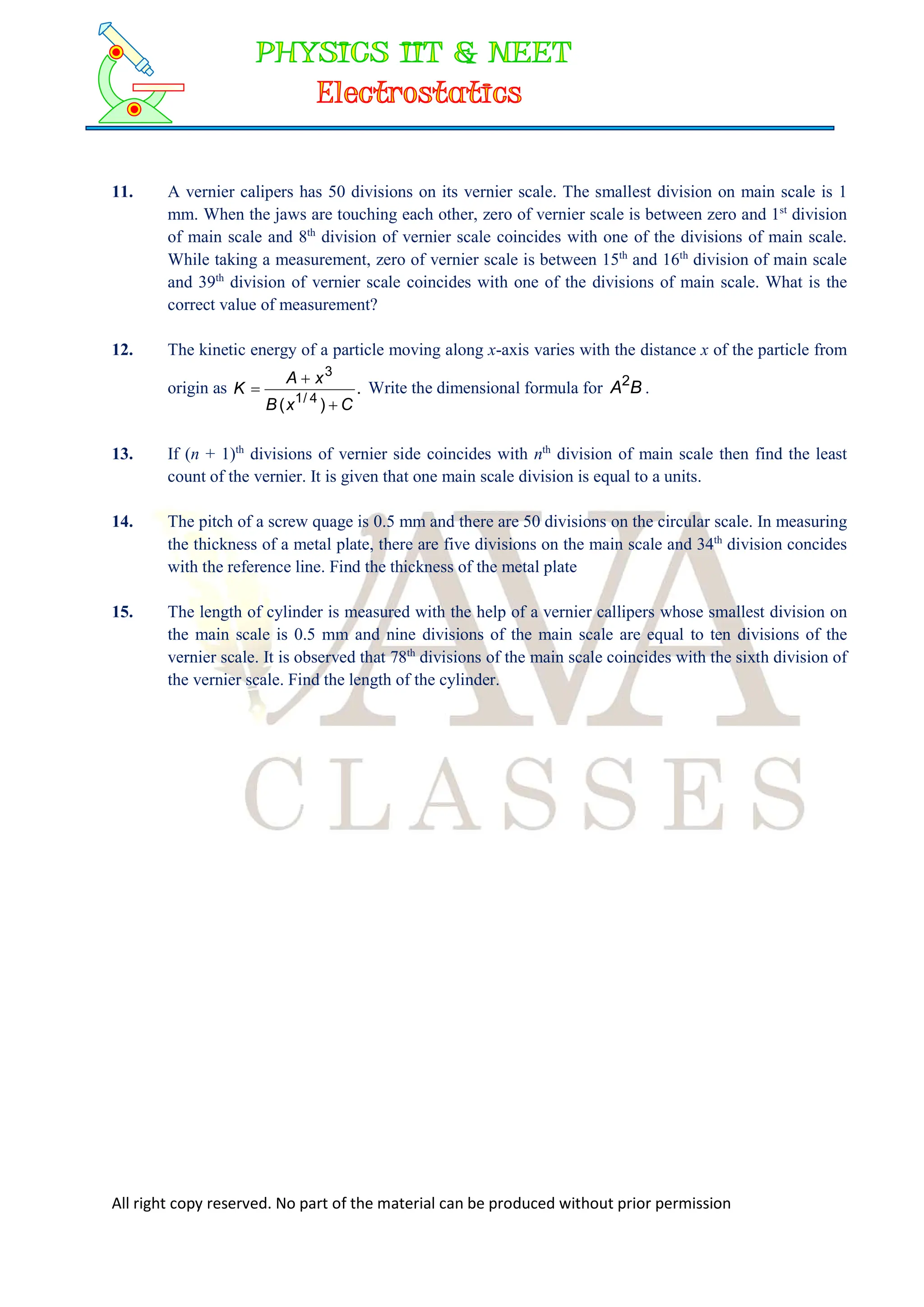
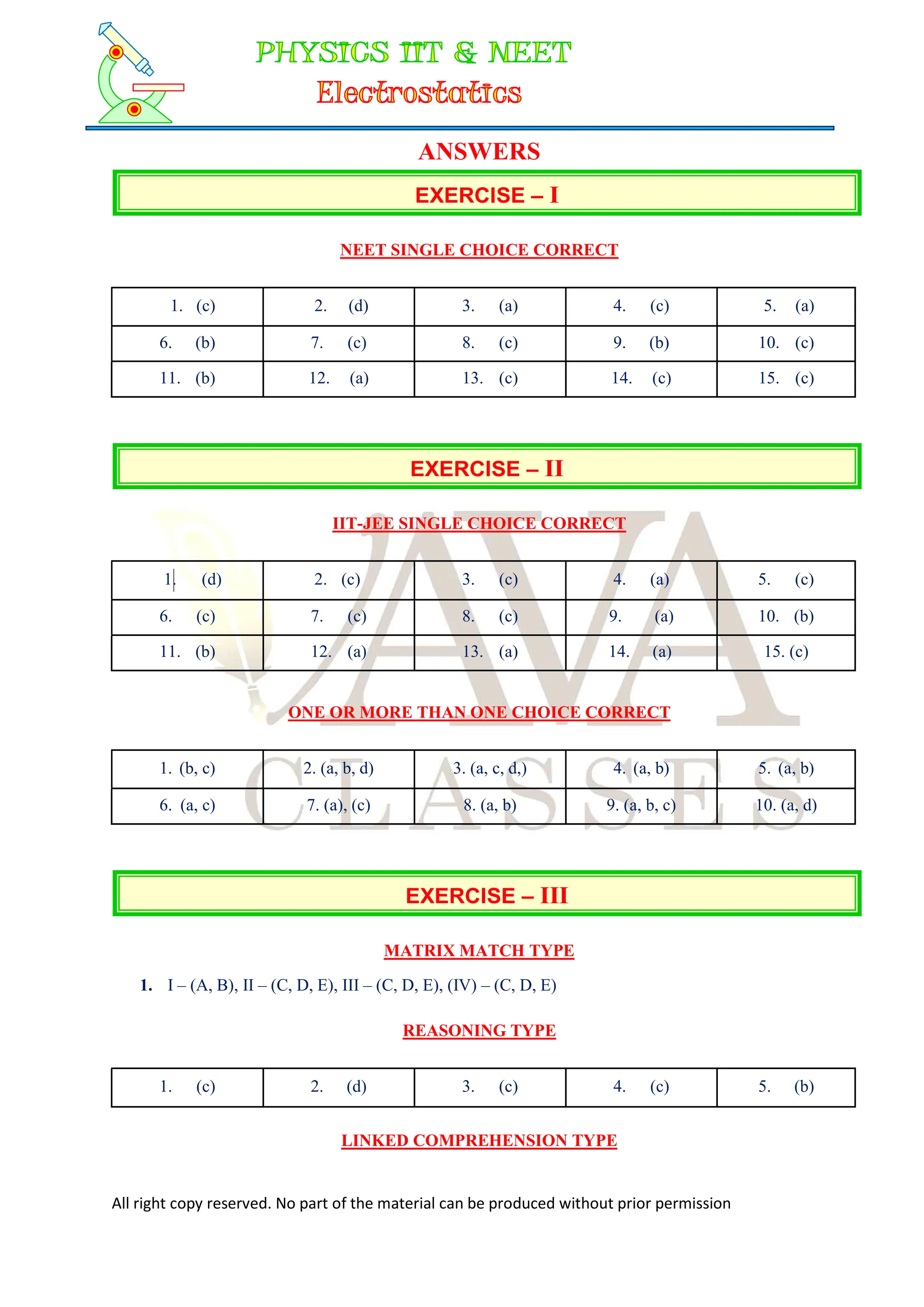
![All right copy reserved. No part of the material can be produced without prior permission
1. (d) 2. (d) 3. (a)
EXERCISE – IV
SUBJECTIVE PRBOLEMS
1. (a) 2 (b) 4 (c) 3 (d) 2
2. (a) 796 (b) 11 (c) 18
3. t = k
S
R
3
5. 2.0 1011
N m-2
6. 1.7 106
m3
7. (a) 0.01s , 0.06 s, 0.20 s, 0.09 s, 0.18 s
(b) .042
(c) 4.2%
8. 13%
9. 4%
10. 3.32 mm
11. 15.60 mm
12. ]
[ 2
1 4
19
T
L
M
13. units
1
1
n
14. 2.84 mm
15. 36.8 mm](https://image.slidesharecdn.com/unitdimensionsmeasurements-240129100521-dde0aa76/75/Unit-Dimensions-Measurements-Class-11-Physics-Chapter-1-Study-Material-in-pdf-58-2048.jpg)
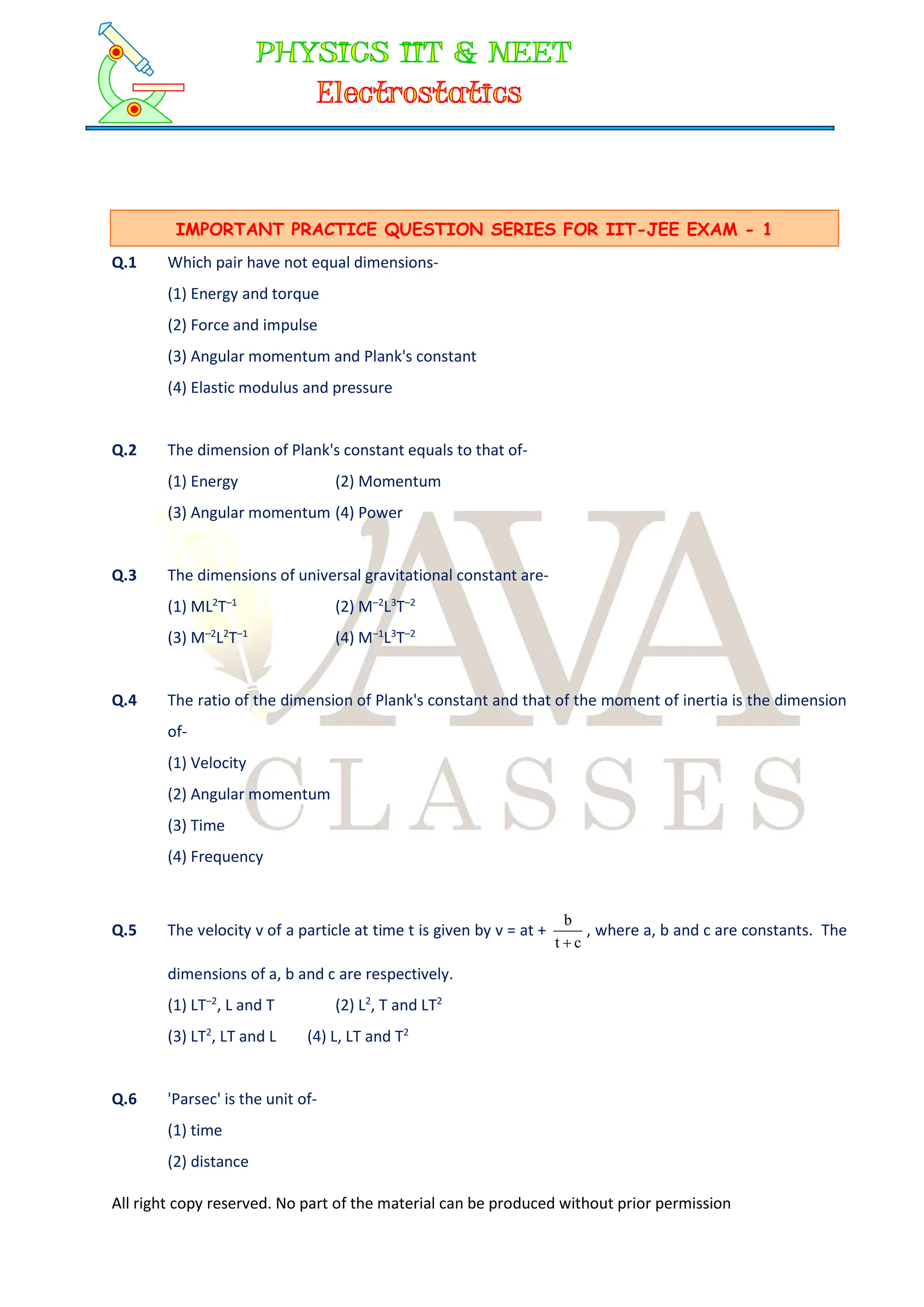
![All right copy reserved. No part of the material can be produced without prior permission
(3) frequency
(4) angular acceleration
Q.7 Dimension of electrical resistance is-
(1) ML2
T–3
A–1
(2) ML2
T–3
A–2
(3) ML3
T–3
A–2
(4) ML–1
L3
T3
A2
Q.8 Which two of the following five physical parameters have the same dimensions ?
(a) energy density
(b) refractive index
(c) dielectric constant
(d) Young's modulus
(e) magnetic field
(1) (a) and (d) (2) (a) and (e)
(3) (b) and (d) (4) (c) and (e)
Q.9 If the dimensions of a physical quantity are given by Ma
Lb
Tc
, then the physical quantity will be-
(1) Force if a = 0, b = –1, c = –2
(2) Pressure if a = 1, b = –1, c = –2
(3) Velocity if a = 1, b = 0, c = –1
(4) Acceleration if a = 1, b = 1, c = –2
Q.10 The dimension of (µ00)–1/2
are :
(1) [L–1/2
T1/2
] (2) [L1/2
T–1/2
]
(3) [L–1
T] (4) [LT–1
]
Q.11 The density of a material in CGS system of units is 4 g/cm3
. In a system of units in which unit of
length is 10 cm and unit of mass is 100g, the value of density of material will be –
(1) 0.04 (2) 0.4
(3) 40 (4) 400](https://image.slidesharecdn.com/unitdimensionsmeasurements-240129100521-dde0aa76/75/Unit-Dimensions-Measurements-Class-11-Physics-Chapter-1-Study-Material-in-pdf-60-2048.jpg)
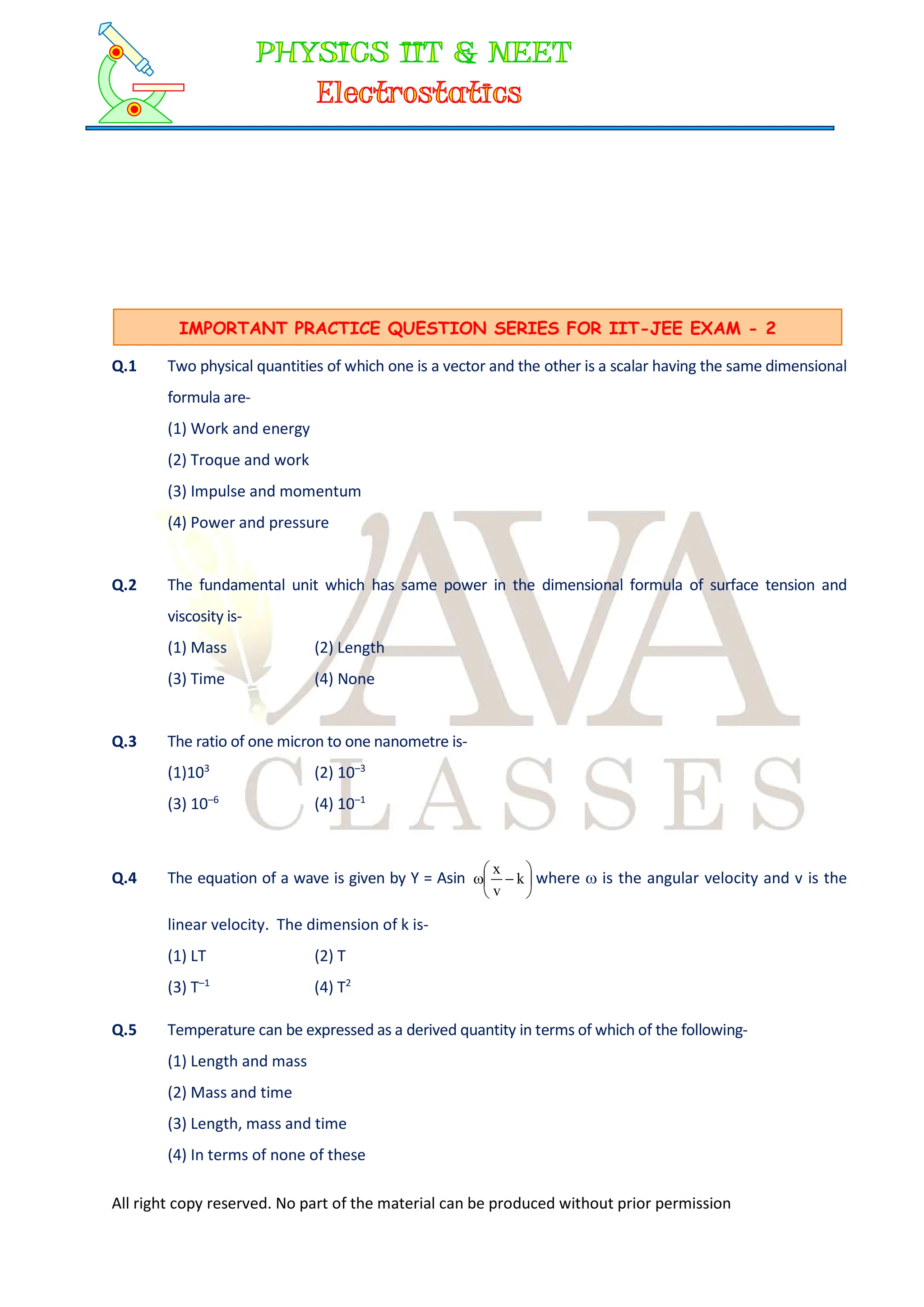
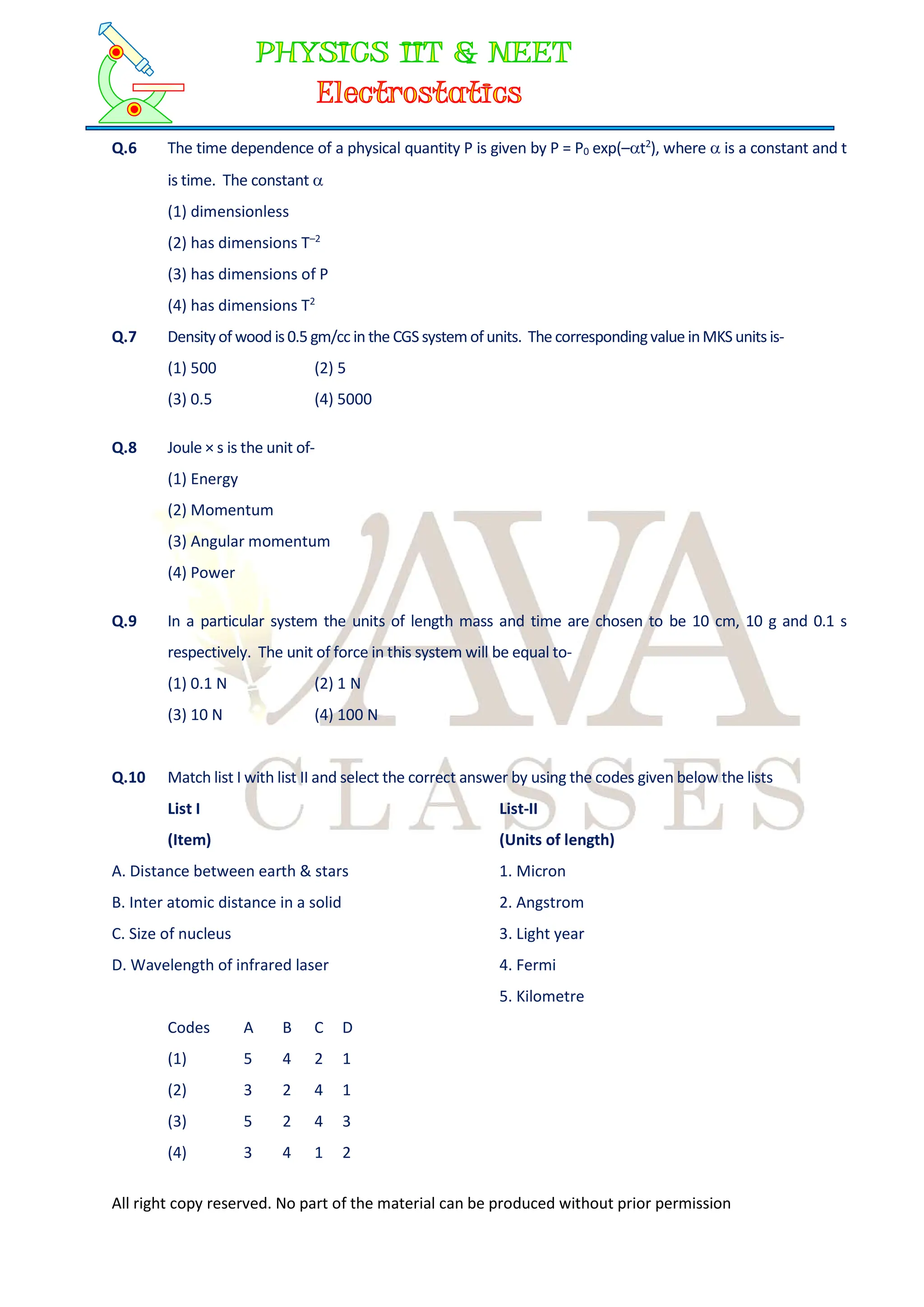
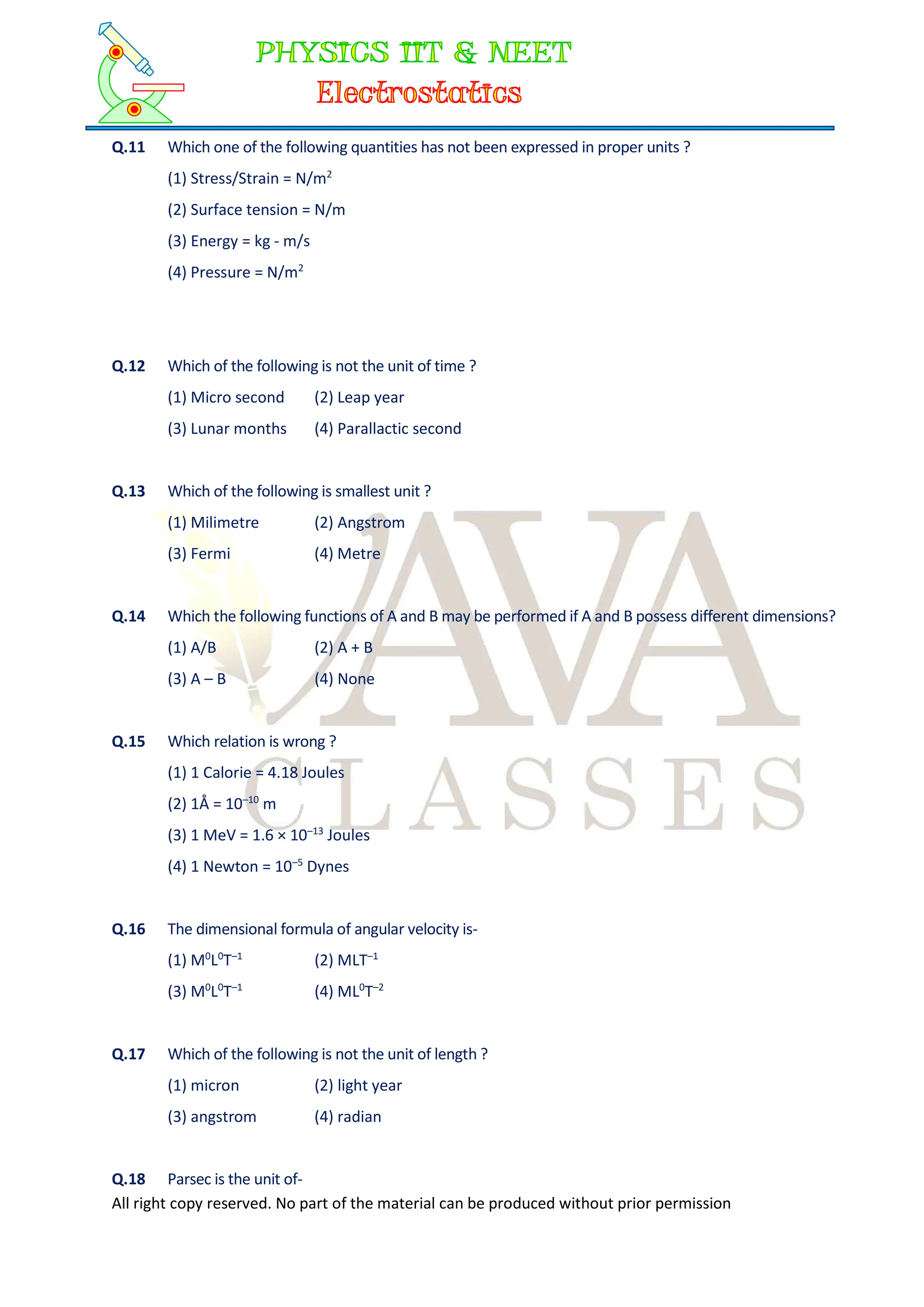
![All right copy reserved. No part of the material can be produced without prior permission
(1) Speed (2) Time
(3) Distance (4) None of the above
Q.19 From the following pairs, choose the pair that does not have identical dimensions-
(1) Impulse and momentum
(2) Work and torque
(3) Moment of inertia and moment of force
(4) Angular momentum and Planck's constant
Q.20 A force F is given by F = at + bt2
, where t is time. The dimension of 'a' and 'b' are
(1) [M L T–3
] and [ M L T–4
]
(2) [ M L T–4
] and [M L T–3
]
(3) [M L T–1
] and [M L T–2
]
(4) [M L T–2
] and [ M L T0
]
Q.21 The mechanical equivalent of heat J is-
(1) constant
(2) a physical quantity
(3) a conversion factor
(4) none of the above
Q.22 If the energy E = Gp
hq
cr
where G is the universal gravitational constant, h is the Planck's constant and c
is the velocity of light, then the values of p, q and r are, respectively-
(1) –1/2, 1/2 and 5/2
(2) 1/2, –1/2 and –5/2
(3) –1/2, 1/2 and 3/2
(4) 1/2, 1/2 and –3/2
Q.23 Match list I with II and select the correct answer:
(A) spring constant (1) M1
L2
T–2
(B) pascal (2) M0
L0
T–1
(C) hertz (3) M1
L0
T–2
(D) joule (4) M1
L–1
T–2
A B C D
(1) 3 4 2 1](https://image.slidesharecdn.com/unitdimensionsmeasurements-240129100521-dde0aa76/75/Unit-Dimensions-Measurements-Class-11-Physics-Chapter-1-Study-Material-in-pdf-64-2048.jpg)
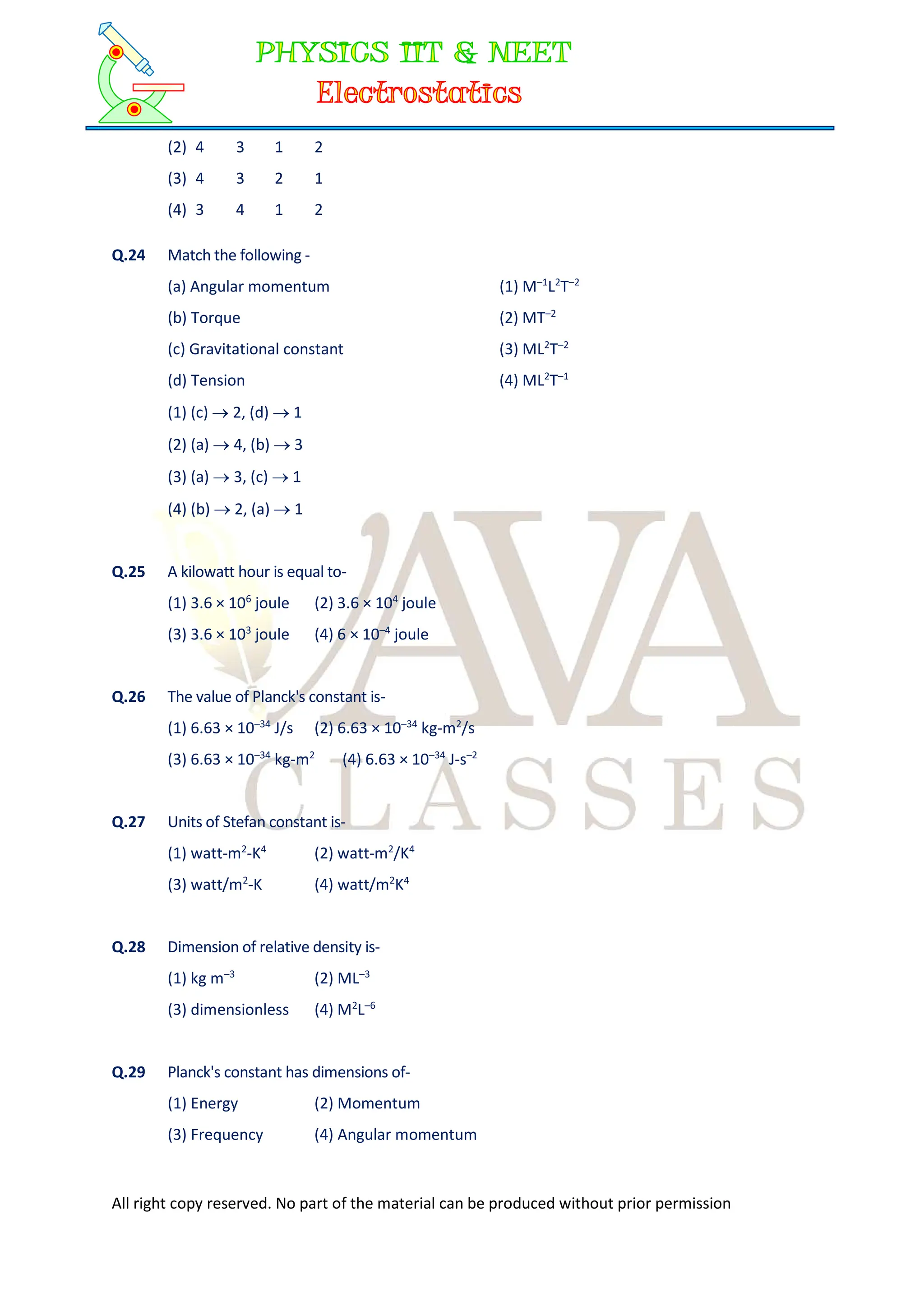
![All right copy reserved. No part of the material can be produced without prior permission
Q.30 The equation of state of some gases can be expressed as )
b
V
(
V
a
P 2
=RT, where P is the
pressure, V is the volume, T is the absolute temperature and a, b and R are constants. The
dimension of 'a' are-
(1) [ML5
T–2
] (2) [ML–1
T–2
]
(3) [L3
] (4) [L6
]
Q.31 Which of the following does not have the same unit as others ?
(1) watt-sec (2) kilowatt-hour
(3) eV (4) J-sec
Q.32 Which of the following pairs does not have similar dimensions ?
(1) Planck's constant & angular momentum
(2) Tension and surface tension
(3) Angle and strain
(4) Stress and pressure
Q.33 If dimensions of A and B are different, then which of the following operation is valid ?
(1)
B
A
(2) e–A/B
(3) A – B (4) A + B](https://image.slidesharecdn.com/unitdimensionsmeasurements-240129100521-dde0aa76/75/Unit-Dimensions-Measurements-Class-11-Physics-Chapter-1-Study-Material-in-pdf-66-2048.jpg)
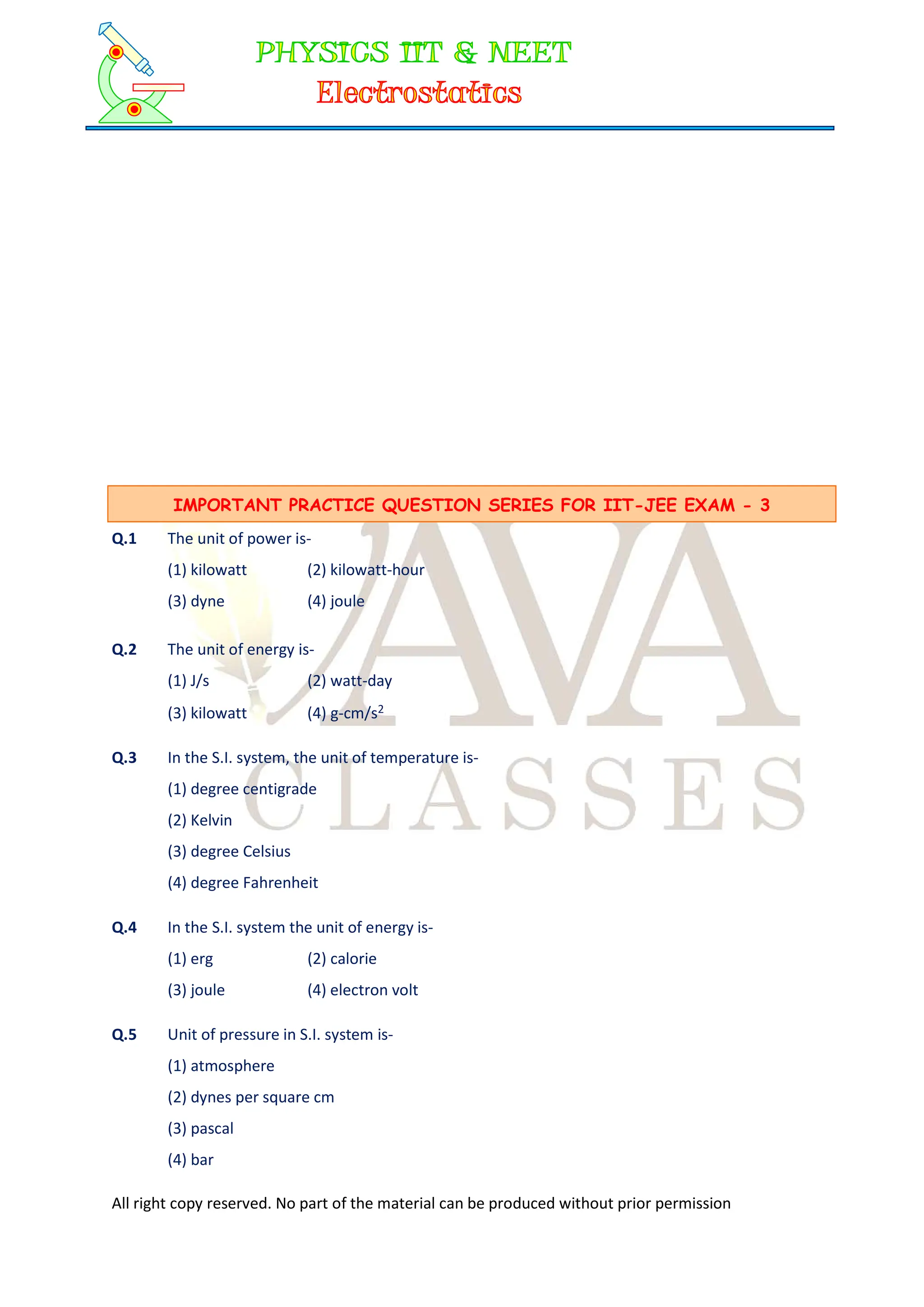
![All right copy reserved. No part of the material can be produced without prior permission
Q.6 Which of the following is not a unit for energy ?
(1) Kilo watt hour (2) Newton- meter
(3) (weber) (ampere) (4) None of these
Q.7 In SI unit the angular acceleration has unit of-
(1) Nmkg–1 (2) ms–2
(3) rad.s–2 (4) Nkg–1
Q.8 Surface tension has unit of-
(1) Joule.m2 (2) Joule.m–2
(3) Joule.m (4) Joule.m3
Q.9 The M.K.S. units of coefficient of viscosity is-
(1) kg m–1s–1 (2) kg m s–2
(3) kg m2 s–1 (4) kg–1 m–1 s2
Q.10 A dimensionless quantity-
(1) never has a unit (2) always has a unit
(3) may have a unit (4) does not exist
Q.11 [M L T –1] are the dimensions of-
(1) power (2) momentum
(3) force (4) couple
Q.12 The dimensions of impulse are equal to that of-
(1) force
(2) angular momentum
(3) pressure
(4) linear momentum
Q.13 Which of the following pairs have same dimensions –
(a) Torque and work
(b) Angular momentum and work
(c) Energy and moment of inertia
(d) Light year and wavelengths](https://image.slidesharecdn.com/unitdimensionsmeasurements-240129100521-dde0aa76/75/Unit-Dimensions-Measurements-Class-11-Physics-Chapter-1-Study-Material-in-pdf-68-2048.jpg)
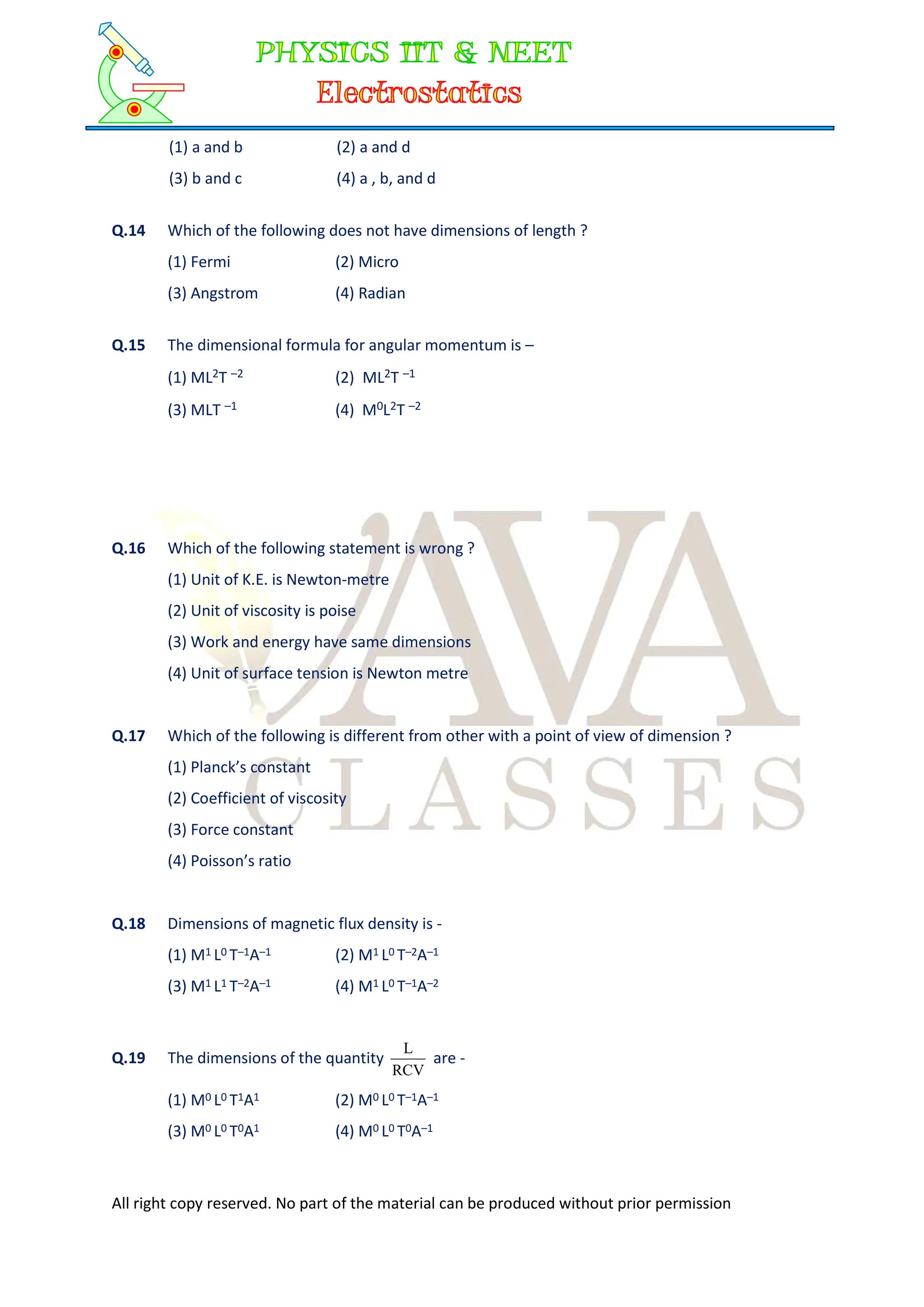
![All right copy reserved. No part of the material can be produced without prior permission
Q.20 A and B are two physical quantities having different dimensions. Then which of the
following operation is dimensionally correct ?
(1) A + B (2) log
B
A
(3)
B
A
(4) eA/B
Q.21 Vander waal's gas equation is
2
V
a
P (V–b) = RT. The dimensions of constant a as given above are –
(1) M L4 T–2 (2) ML5 T–2
(3) M L3 T–2 (4) M L2 T–2
Q.22 For 10(at+3) , the dimension of a is-
(1) M0 L0 T0 (2) M0 L0 T1
(3) M0 L0 T–1 (4) None of these
Q.23 The velocity of a moving particle depends upon time t as v = at +
c
t
b
. Then dimensional formula
for b is –
(1) [M0 L0 T0] (2) [M0 L1 T0]
(3) [M0 L1 T–1 ] (4) [M0 L1 T–2]
Q. 24 The SI unit of length is the meter. Suppose we adopt a new unit of length which equals to
x meters. The area 1m2 expressed in terms of the new unit has a magnitude-
(1) x (2) x2
(3)
x
1
(4) 2
x
1
Q.25 The units nanometre, fermi, angstrom and attometre, arranged in decreasing order will read as-
(1) angstrom, nanometre, fermi, attometre
(2) fermi, attometre, angstrom, nanometre
(3) nanometre, angstrom, fermi, attometre
(4) attometre, angstrom, fermi, nanometre
Q.26 Which of the following pairs of physical quantities has different dimensions ?
(1) stress, pressure
(2) Young’s modulus, energy density](https://image.slidesharecdn.com/unitdimensionsmeasurements-240129100521-dde0aa76/75/Unit-Dimensions-Measurements-Class-11-Physics-Chapter-1-Study-Material-in-pdf-70-2048.jpg)

